

Solo Trekking Nepal: How to Plan Your Trip

Jason is an adventure travel writer with a passion for exploring the world's most beautiful and remote destinations.
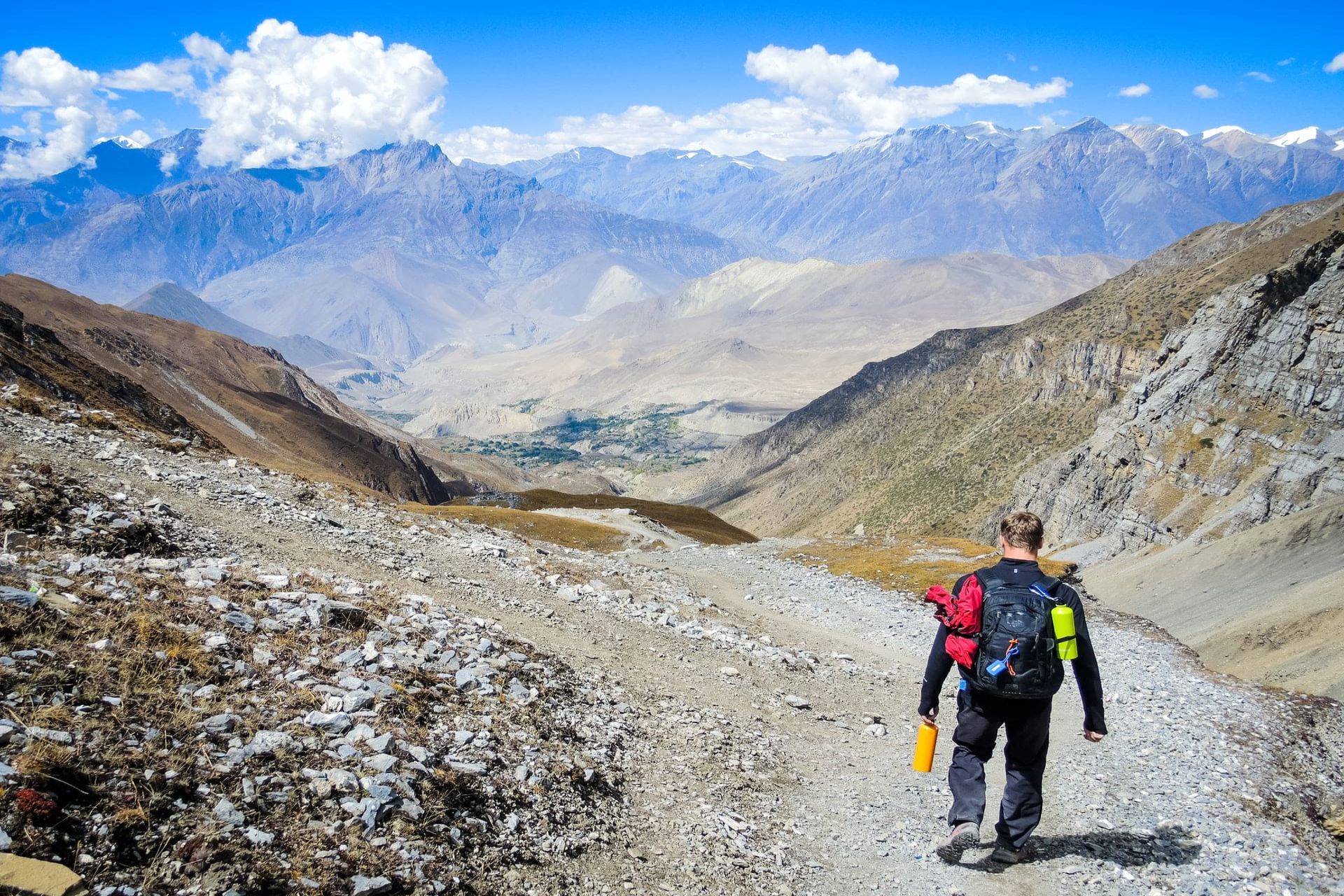
There is nothing like taking on a solo adventure, experiencing nature in its raw form, and living on your own terms. And there is no better place to take on a solo trek than Nepal.
With incredible hiking trails, rugged mountains, and friendly locals, it’s a great place to go hiking alone.
But how do you go about planning a solo trip? What about the risks of going to an unfamiliar country alone? How do you overcome the fear of traveling with no one but yourself to rely on?
In this ultimate guide, we’ll show you how to plan a solo trekking trip to Nepal, how to stay safe, and how to make the most of your visit.
Want to explore thirteen alpine and glacial lakes in the beautiful White Cloud Mountains? Check out our guide on hiking Boulder Chain Lakes here.
What You Should Know About Nepal
It’s safe to say Nepal is unique when it comes to trekking destinations. The popular trails traverse high altitudes, tough terrain, and incredible scenery. But then there are little populated areas dotted throughout with tea rooms and comfy accommodation for travelers that makes it truly special.
The Great Himalaya Range is the crown jewel of Nepal which is bordered by China’s Tibetan province to the north and India everywhere else.
Some of the peaks are over 25,000 feet including Mount Everest which sits at 29,029 feet (with Everest Base Camp being one of the most popular destinations).
As well as the mountains, Nepal is covered in jungle to the south as well as rolling plains and rivers that make it a truly breathtaking place.
Over 600,000 tourists visit Nepal every year so even when you’re solo trekking, you won’t be alone.
Pros and Cons of Solo Trekking in Nepal
When you’re deciding whether to go trekking in Nepal alone, there are some key advantages and disadvantages to consider…
Advantages of solo trekking
- Set your own schedule
A trip to Nepal is a big commitment with a lot of planning – getting someone to plan that with you can be tough. All of a sudden, you’re working around two different schedules, packing for two, and trying to make plans for more than one person.
When you go alone, you choose when, pack a bag, and take off. There’s a freedom to being on your own schedule and not having to answer to anyone but yourself.
- Learn a lot about yourself
You know how people say they go traveling to find themselves? There is some truth to it. Wandering through nature alone with your thoughts allows you some time to learn about yourself and figure out what you want from your life.
- Become more independent
When there’s no one else to turn to for answers, you become independent and resourceful fast. Going on a solo trek brings out a more confident side to yourself you might not have known was there.
You’re also much more likely to make friends and talk to people for company and might make lifelong friends you wouldn’t have otherwise.
- Go at your own pace
Everyone has vastly different skill levels when it comes to hiking. Some people prefer to hike trails quickly and barely stop, others like to take it slow and enjoy nature.
When you’re alone, you can take it at your own pace. There’s no group to keep up with or no one slowing you down, you can choose when and where to stop, and don’t have an obligation to anyone else.
- Boost your skills
When you go trekking with others, you tend to rely on each other’s strengths. That means someone ends up cooking, another is in charge of directions, maybe another is great at first aid, etc.
When you’re alone, your outdoor skills quickly improve because you’re forced to do everything yourself. You’ll come back a much better hiker than when you left and can be proud of your achievements.
- Face your fears
It’s a scary decision to go solo trekking in Nepal, and the fear of being alone in the wilderness stops a lot of people from taking on the adventure.
But there is no better feeling than facing your fear, taking on a solo trip, and coming back a much more confident and experienced trekker because of it.
Disadvantages
Having said all that, there are some disadvantages that are important to take seriously when planning your trip.
- Personal safety
The major disadvantage of solo trekking alone is the increased safety risk. Not only are you more likely to get robbed but you might encounter dangerous wildlife that can be riskier without support.
- More chance of getting lost
There is also an added risk of getting lost. With no one to double-check routes or bounce ideas off, trails can get lost more easily. Plus, getting lost alone comes with its own risk, so it is important to be extra vigilant and careful with route planning on a solo trek.
- Injury risk
Injuries can happen alone or in a group, but when you’re out trekking alone, you don’t have support from someone if you cut yourself, twist your ankle, or can’t physically go on.
If you get sick or hurt yourself out in the wilderness, you’ll need to rely on yourself to get back safely, which is tough when you have bags to carry and no moral support.
How to Trek Solo in Nepal
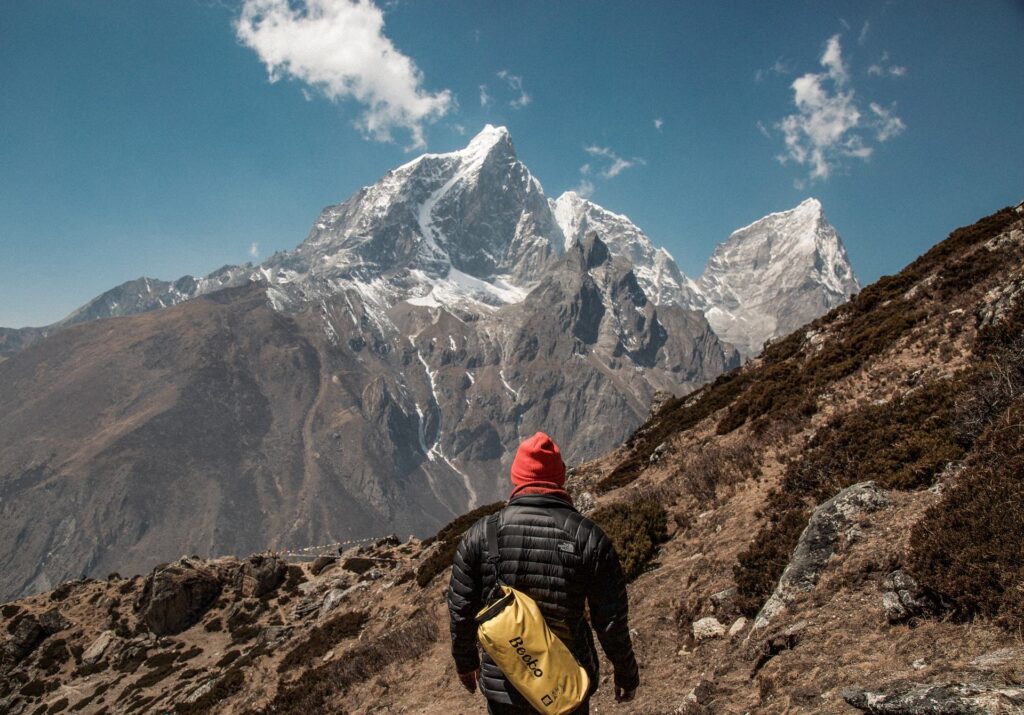
Solo treks in Nepal can last from a week to a couple of months, depending on your route. But local guides do suggest taking on a shorter trek for your first time to get used to the conditions.
Trekking in Nepal does demand a level of physical fitness, and you do need to be able to walk comfortably on rough terrain for six or so hours a day.
If that’s you, you’ll love trekking in Nepal.
When it comes to doing it solo, it’s all in the preparation. The more planning and training you do in advance, the more prepared you’ll be to be out in the wilderness alone.
Start preparing at least two months in advance with some practice hikes on rough terrain and up and down inclines. This will prepare you physically and make sure you have the right gear.
Also get to grips with survival basics including:
- Basic first aid training
- Treating insect bites
- Navigating when lost
- Filtering water
Even when solo trekking in Nepal, having a guide or porter does comes with advantages and can make the experience much more enjoyable if you’re worried about going alone.
They’ll not only recommend the best trails and rest stops but they’ll help you communicate with locals and offer a level of safety when you’re out on your hikes.
A porter will also carry a 15kg bag for you which means you can take more gear without weighing yourself down.
If you’re female, you can opt for a female guide if you’re concerned for your safety with an unknown male.
Best Time to go to Nepal for Solo Trekkers
Nepal is packed with visitors throughout the year, but each season comes with unique features.
Most agree the best seasons for trekking in Nepal are the spring and autumn, with May and October being the most popular months.
This is when the weather is best, conditions are clear, and the entire area is vibrant with wildlife and other trekkers.
The downside of peak season is everything is more expensive. Food, travel, and accommodation are all at a premium during peak season and everything is booked up quickly.
To avoid the crowds, you can go during the colder months, but the weather is much more changeable and the views aren’t nearly as spectacular.
It’s best to avoid the summer months since this is monsoon season in Nepal so the rain is heavy and many of the trails are off-limits.
What to pack for Trekking Solo in Nepal
You’ll need some crucial essentials to keep you safe on your trek:
- Lightweight hiking boots that are broken in
- Microspikes or crampons for the rough terrain
- Shorts or trekking pants
- Lightweight, quick-drying t-shirts
- Long-sleeved shirt
- Rain jacket or down jacket depending on the time of year
- Thick hiking socks
- Light backpack with waist and chest straps
- Lightweight sleeping bag
- Enough Rupees to cover your entire trek (there are no ATMs once you start)
- One liter bottle of drinking water (you’ll be able to refill along the way in tea houses)
- Sunscreen and sunglasses
- Hat and gloves depending on the weather
- A first aid kit
There are also some bonus extras that will keep your trip comfortable but aren’t necessities:
- Trekking poles to make the hike easier
- Hand sanitizer
- Toilet paper (but you can get this along the way)
- Soap/shampoo
- Flashlight or headlight (there is electricity but it’s patchy at best)
- Dust mask (some sections of the trails get very dusty)
- Sleeping bag liner
Where to Trek Solo in Nepal
Some of the most popular solo treks in Nepal are:
- Everest Base Camp trek
- Annapurna Base Camp Trek
- Langtang Valley trek
- Poon Hill trek
These are well-travelled by solo trekkers so you’ll have plenty of people to meet along the way.
If you’re trekking during the summer monsoon season, the Jomsom-Muktinath trek and the Annapurna Circuit Trek are better choices since these are in the trans-Himalayan region which is a rain-shadow area.
Whichever trek you decide to go on, make sure you are intimately familiar with the route, where the tea houses are along the way, the weather conditions, and the culture of the locals.
The more familiar you are with the route, the safer you’ll be and the more you can enjoy your trip.
Precautions to Take While Solo Trekking in Nepal

Although solo trekking does come with some inherent safety risks, Nepal is a very safe place to go exploring alone. It’s usually packed with hikers and the locals are incredibly friendly and helpful.
But even so, it’s also best to take some precautions for your own safety, especially when you’re hiking solo.
- Take a guide: if it’s your first solo trek, a guide will show you the ropes and make sure you are safe on the trail.
- Take GPS: internet and cell service are patchy in remote areas so make sure you have a compass or GPS device to avoid getting lost.
- Stick to the trails: there are no signs on the trails and they do become hard to follow in places so do your best to stick to the paths.
- Pack for emergencies: always have extra supplies just in case you do get lost or injured and need to wait for help.
- Have regular check-ins: there should always be someone who knows the route you’re taking and knows when you should be checking in to confirm you’re safe.
Permits for Solo Trekking in Nepal
To go trekking in Nepal, you need a Trekkers Information Management System (TIMS) card. For solo trekkers, you’ll need a green version, whereas group trekkers get blue.
A solo trekking permit costs more than a group permit, so make sure you get the right one.
You’ll also need a conservation area permit if you want to do any challenging treks through any of the conservation areas.
All the permits you need are available in Kathmandu.
Costs/Expenses While Solo Trekking in Nepal
It’s very affordable to go trekking in Nepal and everything you’ll need to buy along the way is very cheap from accommodation to food and services.
Be warned that the very cheap accommodation usually comes with rats or cockroaches so you might want to spring for a more expensive place to sleep if you’re not camping.
If you want a porter to help carry your belongings, they charge around $10 a day, whereas a guide will cost around $25.
Guides are more since they’ll tell you about the area, show you the best routes, and communicate with the Nepalese people on your behalf.
You should always tip porters, guides, and anyone offering accommodation since tourists are their lifeline and they are usually incredibly helpful.
Tips for Solo Trekking in Nepal
Here are some of our final tips to help you plan your solo trip to Nepal. Remember, the better prepared you are, the smoother your trip will go:
- Altitude sickness is a real risk no matter how fit or experienced you are, so make sure you know the symptoms and what to do if you get it.
- Don’t carry on trekking once it’s dark, it can become dangerous. Plan a trek you can easily complete in a day and stop at night to camp.
- Have decent travel insurance that fully covers trekking as well as emergency evacuation and rescue – it’s always better to have it and not need it.
- Carry enough cash with you to cover your entire trip – the last thing you want to do is run out of cash and be unable to get food or water.
- Drinking plenty of water throughout the day reduces your risk of Acute Mountain Sickness (AMS) so take enough water to drink all day and refill often.
- Pack as if you’re expecting to get delayed or injured to make sure you have enough supplies (the same as when you’re traveling in Death Valley ).
Take on Your Next Hiking Trip
Solo trekking in Nepal is an adventure of a lifetime that you’ll be telling people stories about for years.
The scenery and breathtaking views are like no other, the trails are tough, and the locals are welcoming. This is definitely a trip any backpacker should seriously consider.
But if you’ve already ticked this one off your to-do list, are you ready to plan your next one? Check out our guide on Channel Island backpacking for another unique trip only 30,000 people take every year.
Underground Kayaking in Red River Gorge
Hiking Big Pine Lakes: The Complete Guide
Leave a Comment Cancel reply
Save my name, email, and website in this browser for the next time I comment.
Reach out to us for sponsorship opportunities
We're always looking to grow our reach and collaborate with other influencers within this exciting space.
© 2024 The Roam Wild

- 9 Useful Tips to Solo Trekking in Nepal: Guide Compulsory from April 1 (Updated 2024)
- You are here:
- Trekking in Nepal Guide
- Feb 2, 2024
Rupak Parajuli
Nepal is generally considered a safe country to travel solo or alone in. Travelers coming in from India often say that there is no comparison as Nepal is significantly safer than India. Part of this is because of Nepal’s openness to all religions and cultures and due to its conservative society. It is perfectly legal to trek alone in Nepal but it is not recommended for first-time trekkers.
The reason for this is that every year many Solo Trekkers in Nepal go missing. And most of them go missing due to simple reasons like twisting an ankle, getting lost, or getting sick along the way. Without a companion or guide, disaster can and does strike quickly.
You should consider doing some of the following things as a back up just to be on the safe side when trekking alone. First and foremost, you should let your family and friends know your itinerary. You should also get a local sim so that you can stay in touch with people and let them know about your location. You should also always stick to your route and not take a chance and do anything risky if you are trekking alone.
While Trekking in Nepal is considered as a trip of a lifetime, if you are on a budget and planning on going solo then it is recommended that you do not do it. You should also make sure that for trekking in Nepal, you acquire the right kind of Travel Insurance .
Table of Contents
Plan your trip to nepal.
Customize your trip with help from a local travel specialist.
Staying Safe in Nepal While Traveling Alone
There are plenty of guesthouses and hotels that have accommodations no matter the budget range. There have been incidents where solo travelers have had issues in local homes. While the issues are not regular issues, things like sexual advancement, monetary issues, and emotional blackmail have happened in the past.
While commercial homestays are gaining popularity in Nepal, behind the scenes they are often run by tour companies. While the crime rate is essentially low in Nepal, the rate of bag snatching has risen at night in Thamel and along the lakeside in Pokhara. While there is no need to be paranoid, you should keep your valuables close to you.
Trekking Solo as a Woman
It is important that you do not be lulled into a false sense of security in Nepal if you have never been trekking before. If it is your first trek, it is advisable that you take a guide no matter your gender. And if you have been trekking elsewhere or in Nepal, you should still remember that solo trekkers go missing every year. And in the past, there have been attacks and murders of female solo trekkers although they are exceptions. But because of the cases in the past, you should keep it in mind. The clothes you wear during the trek need to be non-revealing and respectful.
It is frowned upon if you were skin-tight clothes while trekking as it is generally not accepted in the Nepali culture. Loose-fitting clothes are more favored when trekking. Choosing the right guide to trek with is an important part while planning the trek, especially if you plan on traveling solo. So, you should meet a ton of travel guides from different travel agencies before you choose someone you feel 100% comfortable with.
You should also not be scared to ask for references, points of contact, your itinerary, and take a photograph of your guides to face. You should also tell them that you are sending it to your family and a friend here in Nepal. While you do not necessarily need to be harsh as you are going to be traveling with them, you should make it a friendly conversation but still let them know that if anything goes wrong then there are people who know where you are going and who you are with.
Best Time For Solo Travellers
Every season offers unique features while Trekking in Nepal and Nepal does have tourists travel here all year round. Despite that, the most ideal season to visit and trek in Nepal will be during Spring and Autumn and the best months for trekking here are May and October. The main reasons for this are that during these times, the weather will be clear and the views of the mountains will not be veiled by clouds. During these times, the rhododendrons will be in full bloom and you will get to witness them.
As this is the best time to trek, there will be a high number of trekkers during these months and seasons. You will most likely meet people who share similar tastes with you. A major benefit is that in case you manage to get yourself in trouble, as there will be people milling about you are more likely to find help more easily. Pre-booking is important as it is the peak season. Compared to offseasons, the accommodation, travel costs and food will be high.
Permits for Solo Trekking in Nepal
For every trekker who wishes to trek in Nepal, the TIMS card ( Trekkers Information Management System) is compulsory as without it you will be rejected. For solo travelers, green TIMS cards are issued while group travelers will get blue TIMS cards. If you plan on trekking through conservation areas then you will need a conservation area permit. Both of the permits that you require can be gained from Kathmandu.
The permit cost for solo travelers is slightly more expensive as you will have no one to divide the cost with. The permits for trekking in restricted areas are not handed out to solo travelers. To gain restricted area permits, there needs to be at least 2 people excluding the guide.
9 Useful Tips For Solo Trekking
- You should pack all the items you will require and choose a safe season with good weather conditions.
- Despite being physically fit and having previous trekking experience, there is a possibility of altitude sickness. You should know about the diseases related to high altitude and in case of any symptoms, you should immediately seek help.
- A great safety precaution is to inform someone you trust who is near you about the places you are going to be staying at and where you are going.
- You should pick a trekking destination that can be reached comfortably in time with the trails. Also, it is not recommended to trek after dark for solo travelers.
- You should get travel insurance that covers foreign countries too and one that offers rescue and emergency evacuation.
- As there are no ATMs in remote trails, you should carry enough Nepali Cash so that it will cover you for your entire trip. And while there are few regions with ATM facilities available, they are not reliable at all times. So, it is recommended that you carry cash with you.
- You should also walk along the trekking route of your destination and not take any unnecessary risks, especially when you are traveling solo.
- It is important to walk slowly and take the necessary breaks that you require. You should not push your body beyond its limits and to stay hydrated, you should drink plenty of water which will reduce the risk of AMS ( Acute Mountain Sickness ).
- Unplanned situations like delays and injuries might happen, you should also remember to keep a few extra days.
Top 3 Places Where Solo Travels To
Ghorepani poon hill trek.
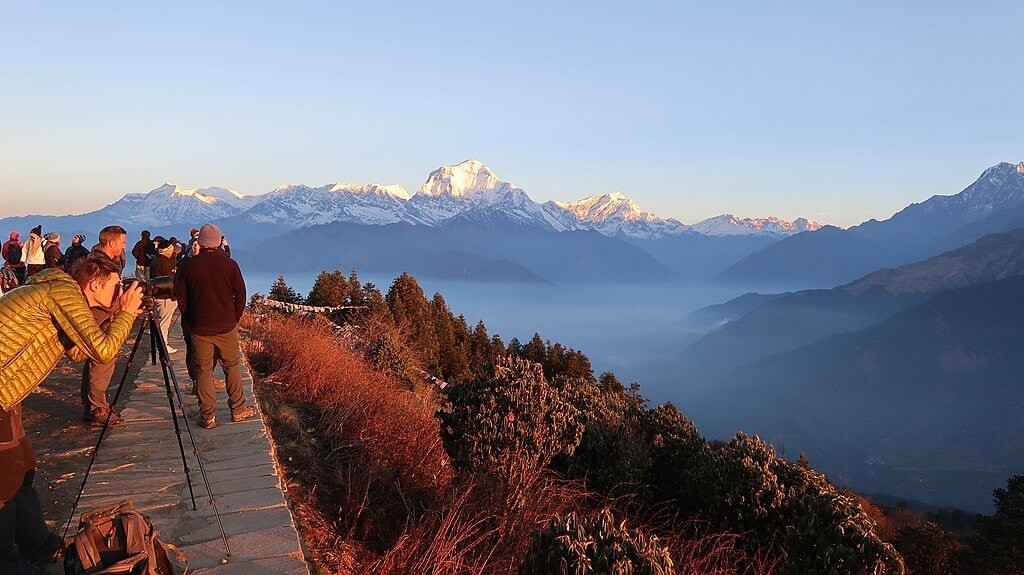
While it is possible to do the Ghorepani Poon Hill trek alone, it is recommended that you take a guide along with you if you are a first-time trekker. Having a guide and a porter is a good way to support the locals and they can be worthwhile but they are an option and you can opt-out of hiring one. It is pretty difficult to get lost in Poon Hill as it is a well-marked trail.
The first step to getting ready is to get your permits. For Poon Hill, you will require two separate permits. One is the Annapurna Conservation Area Project (ACAP) permit and the other is the Trekker’s Information Management System (TIMS) permit. The ACAP permit is your entrance fee while the TIMS permit helps the authorities to keep everyone safe and keep track of trekkers. You can get both of these permits in the Nepal Tourism Board ’s office in the Damside area in Pokhara.
In Kathmandu, you can get your ACAP permit in the Nepal Tourism Board office in Bhrikutimandap and you can get your TIMS permit in Tourism Service Center or in Trekking Agencies’ Association Nepal (TAAN) located in Maligaon. You will need your passport, cash, and a passport photo for each of the permits. Each permit costs Rs 2000 for solo travelers and lesser for citizens from SAARC countries. If you are going with a guide from a travel agency, they will acquire the permits for you.
Nayapul is located to the west of Pokhara and is approximately 43 kilometers away from it. The easiest way to get there is to take a taxi or travel on a public bus. The price of the taxi ranges typically between NPR 2000-3000. The buses are significantly cheaper compared to taxis. The bus ticket costs around NPR 150. While the taxis will take you there in roughly 90 minutes, the buses will take longer and get you there in over 2 hours. You can get a bus to Nayapul from Baglung Bus Park. The buses to Nayapul leave every 30 minutes and you can find buses from 5:30 am to 3:30 pm. While there is a significant difference in price, the taxis are much more comfortable than the buses but it depends on you and the method of traveling you prefer.
After reaching Nayapul, you should register at the TIMS checkpoint and then follow the trail up to Birenthanti. The ACAP checkpoint is located inside the Annapurna Conservation Area. You should make sure that you register at both checkpoints. To start your trek, you simply follow the trail after the ACAP checkpoint.
Langtang Valley Trek
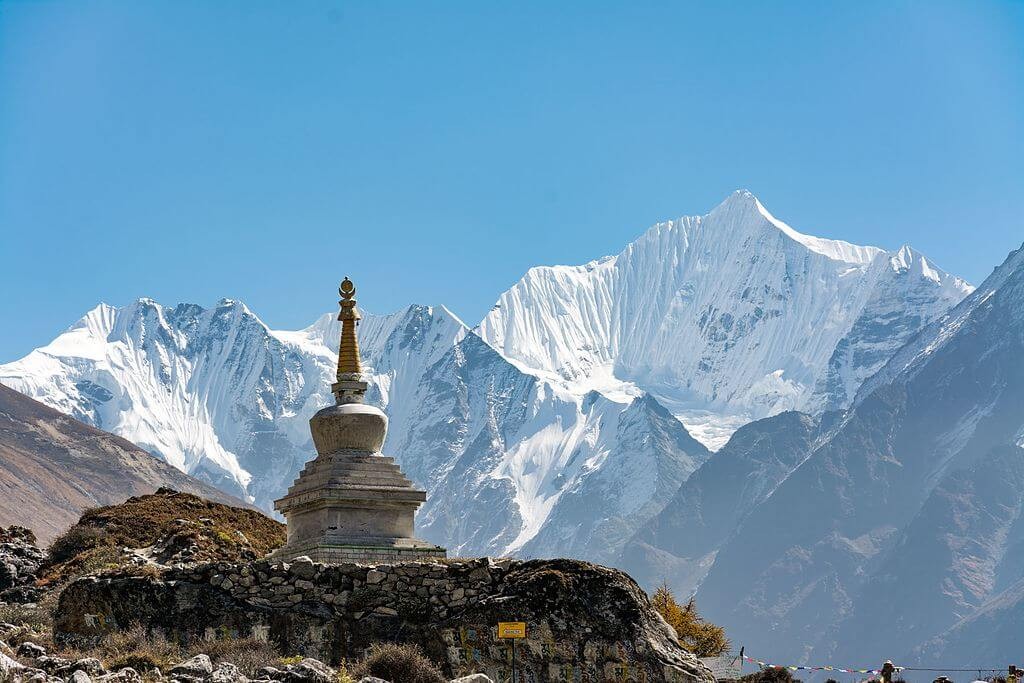
While Langtang Valley Trek is one of the easier treks in the Himalayas, it is going to put your physical fortitude to test. Located at an altitude of 1460 meters is the small mountain town of Syabrubesi which is where your trek will begin. Throughout this trial, you will trek alongside the Langtang river as the trail gains altitude and leads you up to large rocky steps and through thick forest. Above the treeline, the landscape is dominated by Buddhist prayer walls, snow-capped mountain peaks, and Buddhist prayer walls.
While the temperature will drop significantly, the guesthouses offer warm black coffee, hot food, and cozy beds. The last point for many trekkers is Kyanjin Gompa in Langtang Valley . Kyanjin Gompa is a delightful town located at 3,870 meters and made up of a bakery, several guesthouses and a shop that sells freshly made yak cheese. When traveling solo, very quickly trekking costs can add up. If you pre-plan everything and follow the management of the expenses you have prepared then you can complete the whole trek in less than USD 200.
Your trekking will start after your arrival in Kathmandu . The Thamel district of Kathmandu is known as the tourist area and here you can find many accommodations, gear rental shops, and trekking agencies. It takes about 20 minutes to get to Thamel from the airport by taxi but you can also take a public bus till Ratnapark and then walk from there to Thamel.
For Traveling solo, it is recommended that you hire a guide but you can make do without one. If you are on a strict budget then it is probably better if you do not travel solo and wait a bit until you have enough budget to trek. As the entire trail follows the Langtang river, it is nearly impossible to make a wrong turn. On day one, you will come across the only one unmarked fork in the trail. While the right fork leads you over the ridgeline to Lake Gosaikunda, the left follows the river.
For this trek, you will need 2 permits. One is the Trekker’s Information Management System (TIMS) which is a card that has your important information like your itinerary, emergency contact, trekking route, and plans. Along the way, you will have to present this card at checkpoints as it is used for your safety. Another permit you need is the National Park permit. Both the permits can be acquired from Nepal Tourism Board located in Kathmandu. The TIMS permit costs NPR 2,000 for solo trekkers without a guide and the Langtang National Park Permit costs NPR 3,390.
Everest Base Camp Trek
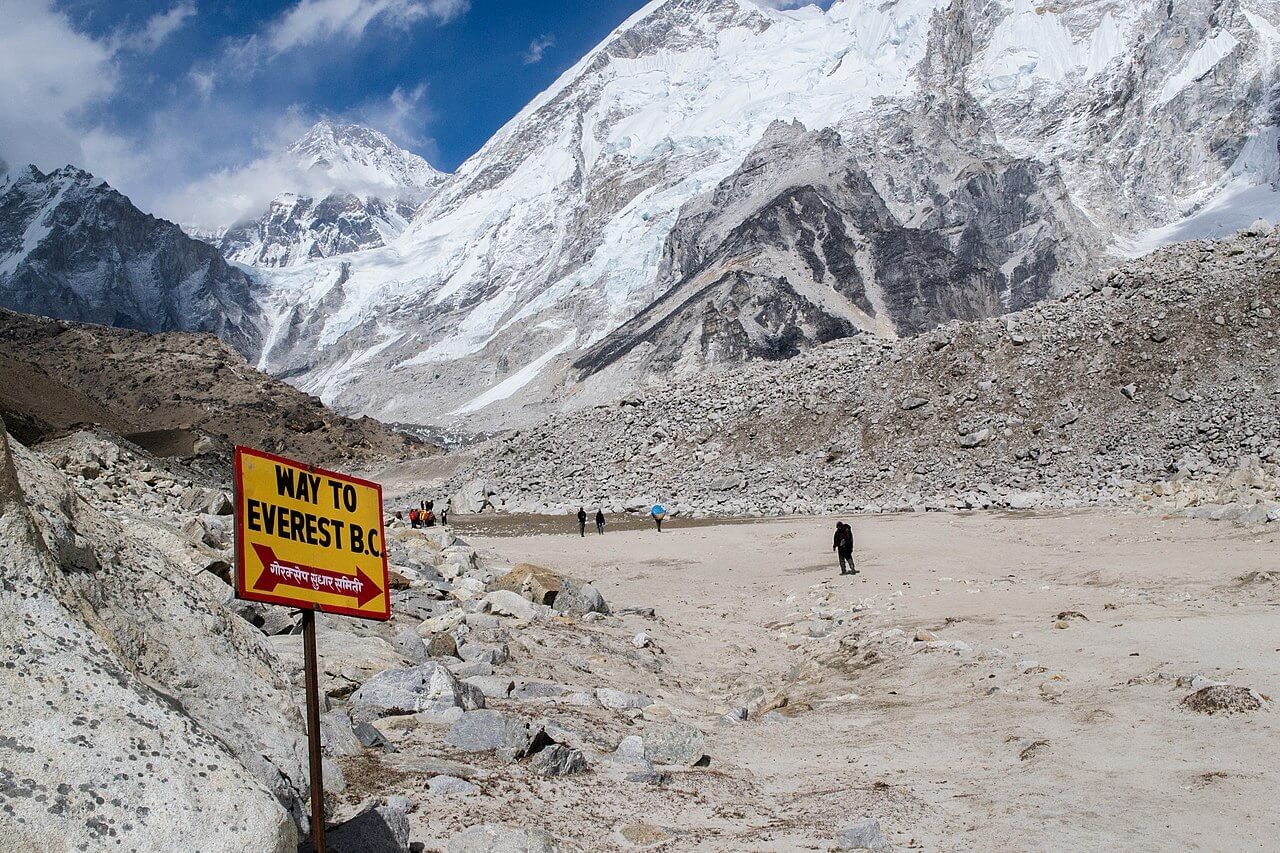
While traveling solo to Everest Base Camp is not recommended, it is possible to do it. You can trek to Everest Base camp by yourself by carrying all the necessary equipment you will need in your bag like trekking socks, water bottles, light snacks, trekking poles, etc. The things that you must not forget are a map and a compass so you can get a proper sense of direction. You can pack all the necessities and trek to base camp as an independent trekker but it will lead to certain problems such as difficulty in finding accommodations and food.
Taking a guide is essential for higher altitudes as at higher altitudes, there is a chance of getting altitude sickness. You might also get problems with vertigo and other mountain difficulties, during that time you will need someone to take care of you and if there is no guide or another companion with you, you will end up alone. Also, during the trek, you will not be able to know the names of the mountains, fauna, and flora of that region. To know about them, you will have to consult the locals at each point.
On the bright side, trekking is about finding peace by emerging oneself in nature and exploring natural environments that you will be able to do on this trek as you will be trekking alone. You will not have to follow a strict schedule and can move at your own pace. Without the restrictions of anyone, you will be able to spend lots of time in the lap of Himalayas. But on the downside, the main disadvantage might be the difficulty in communication. Also when you are trekking alone, people will take advantage of you and overcharge you for things. The risk of taking a wrong turn or going on a completely different area is also there. For female solo travelers, the main problem that may arise is harassment from local boys or foreigners.
Trekking alone is a lot more expensive than traveling in a group. You will have to pay for flight tickets, lodging, food, and all the other necessary stuff by yourself. Some of the things you will need to spend your money on are the cost of flight, permits, TIMS permit, local government permit, guide and porter and your accommodations and food per day.
You will also need to bring all of the stuff you will need by yourself. 25 kilograms is the average recommended weight that once can carry. If you carry less stuff then it will be easier for you to manage. But you should bring essential stuff like a fleece jacket, trekking shirt, breathable underwear, trekking trousers and shorts, water bottles, base layers, insulated jacket, sun protection glasses, hats, lip balm, lotions, a first aid kit and many more.
While trekking alone you will face tons of problems so taking a guide or porter or going in a group is more beneficial. Traveling in a group provides more security and gives lesser burdens about the essential stuff. Traveling with a guide or porter helps you to gain knowledge about the forests, mountains, flora, and fauna. And while there is no certainty that you will get sick, if you do manage to get sick then your companions will use the available resources to take care of you.
Traveling with a Travel Agency will lessen the burden of having to choose hotels, worry about language translators, permits, and carrying bags. Trekking alone is not a big deal but to reduce the number of problems that may arise, you should consider taking a guide or porter with you as prevention is better than cure.
Need Help Planning a Trip to Nepal?
Feel free to contact us , if you need any help planning your trip to Nepal . Our local travel experts will design a custom-made itinerary based on your time, group, cost, and other requirements.
He is a Travel Enthusiast and Writer, who mostly covers the guide to outdoor adventure in the Himalayas of Nepal. He can be your friendly trip planner. Feel free to reach out to him.
Contact Now!
Send an Enquiry
Recent post.
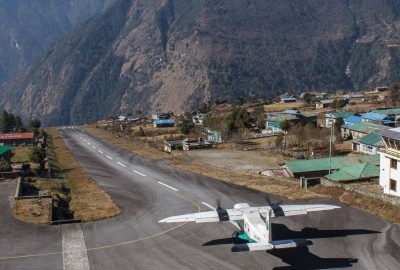
- April 10, 2024
Flying to Lukla - What You Need to Know

- April 09, 2024
How to Drink Clean Water while Trekking in Nepal?
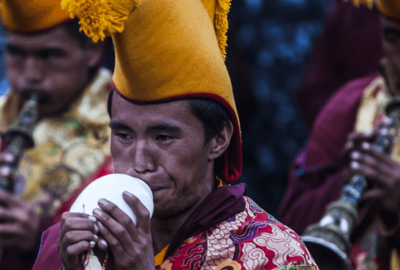
- February 23, 2024
Shey Festival 2024 Dates & Itinerary
- Annapurna Guide
- Bhutan Guide
- City Tour Guide
- Educational Guide
- Everest Guide
- Festival Guide
- Flight Guide
- Gears Checklist
- Kathmandu Guide
- Langtang Guide
- Manaslu Guide
- Mountain Biking Guide
- Nepal Guide
- Off The Beaten Path Guide
- Peak Climbing Guide
Mount Mania Treks & Expedition P. Ltd.
Share this:
You may also like.
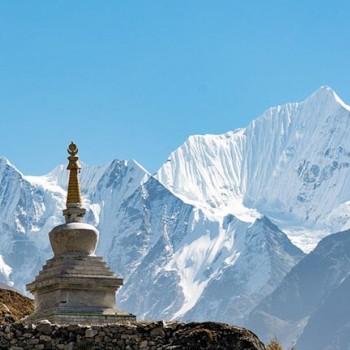
7 Days Langtang Valley Trek
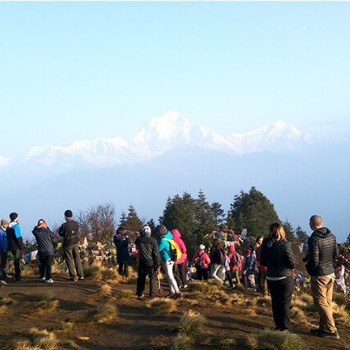
6 Days Ghorepani Poon Hill Trek
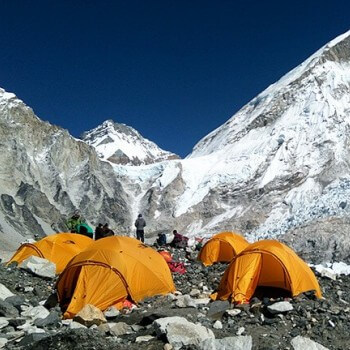
12 Days Everest Base Camp Trek
Registered with: company registration office, government of nepal, licensed by: nepal tourism board & department of tourism, proud member of trekking agency's association of nepal, general member of nepal mountaineering association.
Solo Trekking in Nepal's Everest National Park
:max_bytes(150000):strip_icc():format(webp)/greg-rodgers-adventure-ed92646b25f247049e53af6d36f6c15f.jpg)
Kriangkrai Thitimakorn / Getty Images
"Om mani padme hum ."
I heard the Sanskrit mantra many times while solo trekking in Nepal , but this time it was sweeter than ever. I looked up from a trail lunch of nak cheese into the red-cheeked face of a Sherpa. He was the only person encountered since sunrise. With a kind smile, he beckoned me to follow through the snowstorm. His timing was good: I was tired and lost.
I’m not sure what made being frozen, exhausted, and short of breath sound inviting while sitting on a beautiful beach in Thailand two weeks earlier. But as John Muir said, the mountains were calling, and I felt I must go. In a moment of madness, I grabbed a flight to Kathmandu and began one of the greatest adventures of my life: 19 days of trekking alone in Sagarmatha (Everest) National Park.
Kathmandu was hectic. I spent a few days haggling for knockoff adventure gear in dimly lit shops. Next, I grabbed a topographic map—one like I had learned to read in the army. Everest Base Camp is a popular place in spring, so I planned to circumnavigate the national park clockwise. Starting my solo trek on the quieter, western side of the park would help to avoid the most crowded trails.
I knew that trekking alone in the Himalayas would be an entirely different experience. Solitude in these ancient places would be a blessing, and I could choose my pace. I planned to carry my own stuff, which worked out to around 30 pounds of gear and water. The guides and porters rely on tourism for income, so after the trek, I gave all equipment and leftover currency directly to families on the trail.
Safety was an obvious concern . I sought advice from the weathered guides met in Thamel’s smoke-filled pubs. They were fun characters, buzzing with stories and life. Some were missing fingers lost to frostbite. I scoffed when they told me how Snickers were coveted at higher elevations, but they were right: simply nibbling a frozen candy bar could lift spirits after a bad day on the trail.
Entering the Himalayas
The flight to Lukla is equal parts exhilarating and terrifying, and the excitement begins in Kathmandu’s airport . With only 10 kilograms (22 pounds) of luggage allowance per passenger, the antique scale at check-in was scrutinized. Weight is understandably a concern when flying through thin air in a small, turboprop plane. Excited passengers chatted in many languages; adventure was upon us.
When flying to Lukla, sit on the left for the best snow-capped scenery—assuming you can take your eyes off the show in the open cockpit. For the duration of the 45-minute flight, we alternated between gasping at mountains and gawking at the copilot, who was furiously pumping jammed levers and resetting flashing breakers. The trip works out to around $5 per minute in the air, but I feel like I got more than my money’s worth.
Tenzing-Hillary Airport (LUA) in Lukla is dubiously known as “the most dangerous airport in the world.” The short landing strip has an 11-degree uphill slope and ends at a wall of stone. If the wind changes during the approach, as it’s prone to do in the mountains, there is no time to pull up for a second attempt. To stick the landing, level-headed pilots have to fly into a mountain. Gray granite fills the view through the front windows until you (hopefully) deplane moments later with wobbly legs. Before leaving, I thanked our skilled pilots. They seemed as happy to be back on terra firma as everyone else.
Although the flight is a wild one, you soon realize it’s a proper rite of passage for accessing the Himalayas. I noticed the peace immediately once on the trail. Kathmandu’s cacophony of honking horns is replaced with only the sounds of wind and jingling bells on yak trains.
Nepal enjoys low humidity in April, giving the sky a sharpness and exaggerated clarity. I felt as though I could see impossibly far in every direction, and what I saw was surreal. The mountain landscapes are almost too perfect to process . A brain struggles to keep up. No roads, wires, signs, or fences mar the majesty in any direction. Only cairns, friendly stacks of stones, were there to remind me I wasn’t alone. They silently showed me the path on many frosty mornings.
On the second day of walking, I arrived in Namche Bazaar. Namche is a hub and the final stop for last-minute essentials such as crampons and pizza. It’s also the last opportunity to use an ATM. Bakeries offer sweet treats and screen documentaries in the evenings. The atmosphere is social and lively. Newly arrived trekkers are excited about heading higher. Weary trekkers descending are doubly happy to enjoy new food options and an abundance of oxygen. Although Namche Bazaar rests at 11,286 feet, it’s low by Himalayan standards.
To acclimate quicker, I used my three days in Namche Bazaar wisely by adhering to the mountain adage “climb high, sleep low.” Regional hikes provided heart-pounding workouts rewarded by exceptional views. Before leaving, I paid to take a cold shower, my last for 16 days, and bought an extra Snickers bar just in case.
There are no roads in Everest National Park. Everything has to be painstakingly carried up by porters and yaks. Heavily loaded yak trains rattle along the trails. I was advised never to share a bridge crossing with them, and always yield to the side of the trail farthest from the edge. The advice was spot on. Later, I was trampled when several of the animals became startled by a helicopter passing low overhead. The panicked beasts gave me a good stomping and broke my toe, but had I been on the cliffside of the trail, they may have pushed me over.
Icy streams and small waterfalls usually provided my drinking water. It was beautifully clear, but I always treated the water first. Until you’re standing at the top, which actually is an option in Everest National Park, you should assume a settlement is higher and sending pollution downstream. I was drinking more than two gallons of water a day to beat dehydration due to the dry air and elevation gains.
In the evenings, I huddled with other trekkers around yak-dung-burning stoves in tea lodges. Conversations became a gibberish of numbers. Elevation stays at the forefront of everyone’s mind for a good reason: It can be a killer if you mess up the math. Even when all goes well, having less oxygen available does strange things to the body. You physically morph as new capillaries are grown to divert blood. On a one-week trek, you’ll get a taste. But according to a volunteer doctor, lingering longer really causes things to “get weird.” She was correct.
Sleep doesn’t come easily no matter how weary you are, and dreams are psychedelic carnivals. The body manufactures more red blood cells to carry oxygen. To make room, other liquids are eliminated. Going to the toilet 10 times on any given night isn’t unusual. Unfortunately, those toilets are too often found at the ends of frigid hallways in trail lodges. The worst are outside in snowy outhouses, but at least you get to see the stars.
The uninsulated lodge rooms along the trail feel a bit like camping indoors. Before turning in around 7 p.m. each night, I poured boiling water into my bottles to use as bed warmers. Each morning they were frozen solid under the heavy blanket. Many nights were spent fantasizing about sunburn and coconut drinks at sea level. Meanwhile, clouds of frozen breath collected above the bed like weather systems.
Crossing the Cho La Pass
I knew the Cho La pass was going to be tough, and it didn’t disappoint. The cheerful clues on my map had filled me with dread for too long: “difficult ice crossing,” “danger of rocks falling,” and “shifting crevasses.” The vertical scramble up the loose moraine and unstable glacier stood defiantly at 17,782 feet, blocking the path to Everest Base Camp . The Cho La is a pinch-point connecting the western side of the national park with the popular trail to Everest. If I couldn’t cross it, I would be forced to spend a week backtracking. Hard-earned elevation gains would be forfeited.
I began at 4 a.m. with a headlamp, but the Cho La was more temperamental than usual. The path was obscured by snow from a winter storm that had trapped me the day before. Ice-covered rocks slipped and tumbled as I climbed upward alone. Snow dusted me from unseen slides above. No groups attempted the crossing that day due to conditions. I probed for freshly concealed crevasses with my climbing poles. I felt exposed and alone. Few things are as unsettling as watching boulders the size of cars move on their own accord. I managed the crossing, then collapsed to take a break while snow collected in my beard. I wasn’t sure I could go on—that’s when the lone Sherpa arrived right on cue, singing his mantra.
I spent two glorious nights recovering in Dzongla before pushing up to Gorak Shep, last stop before Base Camp. I ate my last precious Snickers bar slowly and reverently. After two winter-survival scenarios in one week, I had a new appreciation for enjoying the present. To be blunt, I felt more alive than ever. The challenges in the Himalayas are tough, but the rewards greater.
Arriving at Everest Base Camp
Ironically, Mount Everest isn’t visible from Everest Base Camp. I began my climb up to Kala Patthar, an adjacent “hill,” in darkness to get the best view of the Holy Mother herself. At 18,500 feet (5,639 meters), I was treated to sunrise and a spectacular glimpse of the top of this world. Prayer flags flapped wildly in the blasting wind as I panted for breath. Oxygen levels atop Kala Patthar are only around 50 percent of those at sea level. As for many trekkers, this was the highest elevation I would experience in the Himalayas. I tried to imagine what climbers must feel with only 33 percent oxygen when they reached the summit of Everest in front of me.
The next day, despite uncertain weather, I made the three-hour walk to Everest Base Camp. I felt jittery and giddy. After a lifetime of watching documentaries about Mount Everest, a childhood dream was realized. When I arrived, the happy tears tried to freeze on my face.
Helicopters roared overhead as supplies were brought up. With the climbing season about to begin, the atmosphere was buzzing and frenetic. I met camera teams from BBC and National Geographic. I reverently touched the Khumbu Icefall, the start of the route up Everest and one of the most dangerous sections. To go beyond where I stood requires an $11,000 climbing permit .
Like so many times during my trek, I felt barometric pressure plummet. My ears popped as bad weather swooped in quickly. I had to leave Base Camp sooner than I wanted, but the alternative would have been begging for an overnight stay in a stranger’s tent! I scooted back to Gorak Shep in a hurry. But as snow blew sideways and brittle rocks slid around me, I had a smile on my face. Somehow, I knew everything was going to be OK. No matter what adventures the rest of my life holds, the time I spent at the top of the world will be mine forever.
I sang " om mani padme hum " on the descent.
Everything You Need to Know About Trekking to Everest Base Camp
The Best 12 Hikes in Nepal
Five Amazing Hiking Routes Among the High Mountains of the Himalayas
The Most Beautiful National Parks in Nepal
20 Solo Trips in 2020: I Traveled Solo During COVID-19
Where Is Mount Everest?
Independent Trekking in Nepal
The Top 15 Destinations in Nepal
The World's Highest Places and Attractions That You Can Visit
The Story of the 5 Greatest Mount Everest Climbers
The Best Time to Visit Nepal
Sedona, Arizona: Day Trip or Weekend Getaway
How to Go Teahouse Trekking in Nepal
15 of the Most Beautiful Sacred Sites in Nepal
I Biked Hundreds of Miles Alone on My Birthday—and I Can't Wait to Do It Again
Your Trip to Nepal: The Complete Guide

+977-9802342081
Thamel, Kathmandu, Nepal
How can a beginner solo trek in Nepal?
Nepal offers a trekking experience like no other. However, a beginner solo trek in Nepal can be difficult. But from experienced to beginner, everyone is welcomed by the Nepalese trails. Its breathtaking landscapes, diverse cultures, and majestic mountains make it a dream destination for adventurers worldwide.
From short and scenic walks to challenging high-altitude treks, there's a trail suited for every adventurer. What's so remarkable about beginner solo trek in Nepal?
Nepal's Natural Beauty: Solo Trekking Guide for Beginners Nepal is a trekker's paradise, as reflected by various trekking routes supporting all experience levels.
The Annapurna, Langtang , and Everest are famous trekking routes. It highlights the Himalayas' stunning beauty, lush forests, and quaint villages. Each route presents a unique blend of natural wonders and cultural immersion, making every step memorable. Advantages and Challenges of a Beginner Solo Trek in Nepal Advantages Freedom and Flexibility : Solo trekking allows you to set your own pace and make spontaneous decisions. You can spend more time at places that captivate you and adapt your itinerary as you see fit.
Personal Growth : Trekking alone can be a transformative experience. It pushes you out of your comfort zone, fostering independence and self-reliance. Cultural Interaction : Traveling solo encourages interactions with locals and fellow trekkers. It can lead to profound cultural experiences and lasting friendships. Challenges Navigation : Finding your way can be tricky, especially in less-travelled areas. Carrying a map, compass, or GPS device is essential.
Safety : Solo trekking poses unique safety concerns. You should have a reliable communication device. Informing someone about your plans and adhering to local guidelines are crucial.
Loneliness : While solitude can be rejuvenating, moments of loneliness may arise. Engage with other trekkers and locals can help alleviate this feeling.
Logistics : You should handle accommodations, permits, and meals can be more challenging without a group. Proper planning and research are essential.
Preparation for Any Beginner Solo Trek In Nepal
It would help if you started on a solo trek in Nepal requires careful planning and preparation. Choose the Right Trekking Route It would help if you went for trekking routes that are relatively short and have moderate levels of difficulty. These routes can introduce the world of trekking and allow you to acclimate to the altitude and terrain.

However, consider trekking in well-known regions like Annapurna and Langtang. These areas offer a range of trekking options with well-maintained trails, comfortable accommodations, and stunning vistas. Researching and Understanding the Trail It would help if you researched the trail's terrain and altitude changes. At the same time, understanding the weather patterns for the time of year, you plan to trek is vital. The knowledge will help you pack appropriately and anticipate challenges. Check the permits required for your chosen trek. Some areas demand special permits, while others might need only a national park entry permit. Research the entry procedures and fees to avoid any last-minute complications. Physical and Mental Preparation Fitness Training and Conditioning
Begin a fitness regimen that includes cardiovascular exercises, strength training, and endurance-building activities. Focus on exercises that strengthen your legs, core, and cardiovascular system. Acclimatization and Altitude Sickness Awareness Understand the importance of acclimatization to avoid altitude sickness. Acquaint yourself with the symptoms and know when to ascend slowly or take rest days.
Packing Essentials
Pack light, but ensure you have the essentials. Items such as sturdy hiking boots, moisture-wicking clothing, a warm jacket, a hat, sunglasses, sunscreen, a reliable backpack, a water bottle, and a headlamp are crucial. Solo Trek Safety Tips Share your itinerary and expected return date with a friend, family member, or your accommodation. Regular updates offer peace of mind to both you and your loved ones. You should stick to established paths and avoid shortcuts. It might lead to unfamiliar and potentially hazardous areas. Additionally, equip yourself with a reliable means of communication like a satellite phone or locator beacon, especially when trekking in remote regions with limited cell reception. Familiarize yourself with local traditions, customs, and rules to demonstrate respect for the communities you encounter and to prevent any unintentional cultural misunderstandings. Embracing the Culture While preparing for a solo trek in Nepal is primarily about exploring nature. It's also an opportunity to connect with the local culture and positively impact the communities you encounter. Interacting with Locals Pick up a few simple Nepali phrases to show respect and engage with locals. It can lead to meaningful interactions and bridge cultural gaps.
Also, approach encounters with humility and respect. Seek permission before taking photographs, and ask questions about local traditions and customs when appropriate. Responsible Trekking Practices Follow the ideology of Leave No Trace, such as packing out your waste, avoiding littering, and staying on designated trails.
Purchase goods and services from local communities along your trek. It directly contributes to the local economy and fosters a positive relationship between trekkers and locals.
Trekking Experience
You can prepare for the trek early with the most daylight hours. Meanwhile, avoid trekking during the hottest part of the day. Stay hydrated and refuel with snacks and meals to maintain energy throughout the day.

Take your time with the trek. Take breaks to enjoy the stunning scenery and capture the moments with your camera. Engage with other trekkers along the way. Sharing experiences and stories can enhance the journey. How can you overcome challenges?
Pushing Through Physical Strain
When fatigue sets in, focus on your mental strength. Break the trek into smaller goals and celebrate your progress. Pay attention to your body's signals. Rest when needed, and don't hesitate to adjust your pace or plans if you're not feeling well.
Gaining Confidence Along the Way
Acknowledge and celebrate each achievement, whether completing a challenging section or conquering a high pass. Overcoming obstacles fosters adaptability and builds self-assurance.
What can a beginner for a solo trek in Nepal do after the trek? Sharing Your Journey You can write a journal, take photos, or create a travel blog to capture your trekking adventure. Share your stories and photos with friends, family, or online communities to inspire others and relive your memories. Lessons for Future Treks Evaluate the challenges you faced and how you overcame them. Use these lessons to enhance your future trekking experiences. Consider what worked well and what you could improve for your next solo trek. Each journey is a learning opportunity.
Trekking solo in Nepal as a beginner is a remarkable journey that offers adventure, self-discovery, and cultural exploration. Nepal Vision Treks helps you tackle all the problems during your adventure and provides the best trekking experience in town.
FAQS 1) Can you trek alone in Nepal? Yes, you can trek alone in Nepal.
2) What is the easiest trek in Nepal? The Ghorepani Poon Hill Trek is often considered the easiest trek in Nepal.
3) What is the cheapest way to trek in Nepal? Opting for independent teahouse trekking without a guide or porter tends to be the cheapest way to trek in Nepal.
4) Is it awkward to hike alone? Hiking alone can be a mix of solitude and empowerment, with moments of self-discovery and connection to nature.
5) Can you trek without a guide in Nepal? As of April 1, tourists travelling to Nepal must hire a licensed guide or porter before trekking through the country's wilderness.
6) What's the best time for solo trekking in Nepal? The peak trekking seasons are autumn (September to November) and spring (March to May) when the weather is clear and comfortable.
7) Do I need special permits for solo trekking in Nepal? Some trekking areas, such as the Annapurna and Everest regions, require special permits. It's important to research and obtain the necessary permits before your trek.
8) How physically fit must I be for solo trekking in Nepal? While fitness levels vary, being moderately fit and engaging in physical training before your trek can greatly enhance your experience and help you tackle the trails more easily.
9) Will I lose weight trekking in Nepal? Trekking in Nepal can lead to weight loss due to increased physical activity and potential calorie expenditure, but individual outcomes vary.

5 Places To Visit in Dhankuta

5 Places to Visit in Far Western Nepal

Things to Pack for Mera Peak Climb in 2024

Can I do Mardi Himal Trek?
Featured Packages
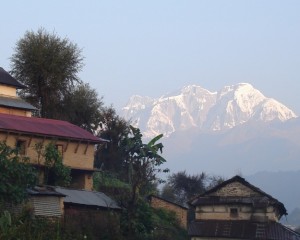
12 days | Trekking & sightseeing
Destination
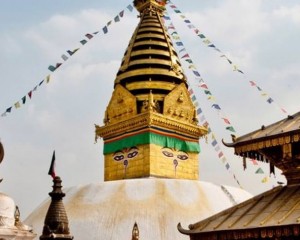
16 days | Sightseeing and tour

21 days | Trekking & Sightseeing

14 days | Trekking

Mosaic Adventure
Unleash the trekking bug in you…. experience the Himalayan touch……
Solo Trekking in Nepal
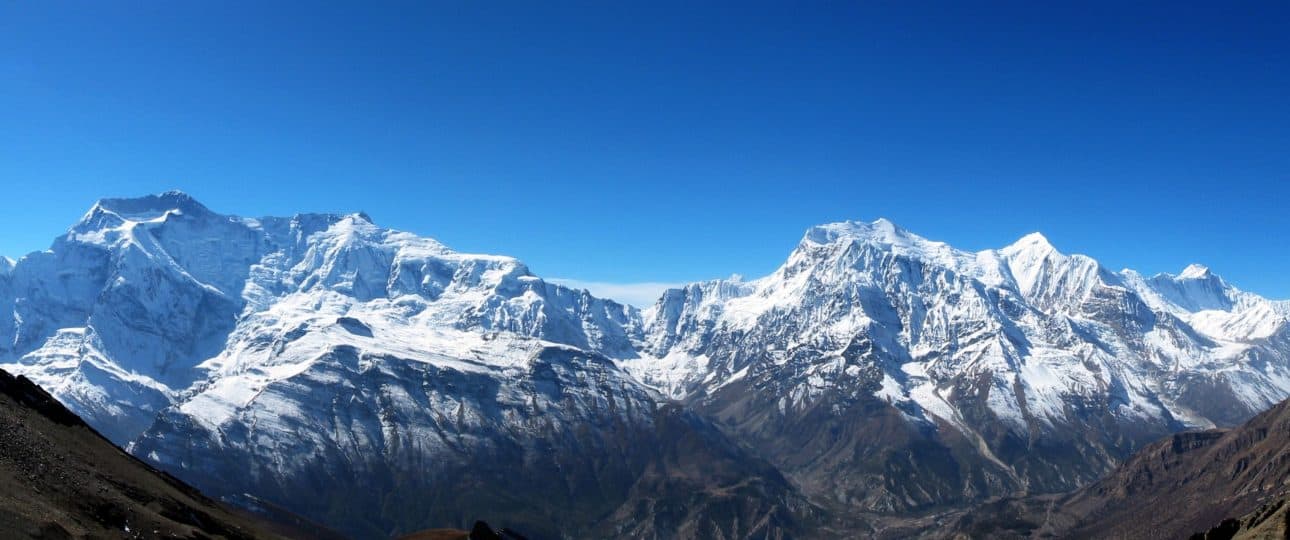
Trekking is a wonderful experience and is also one of the most popular activities to indulge in. Nepal has the most beautiful and diverse trekking destinations with surreal exotic trails.
Both solo and group trekking is possible in Nepal.
While trekking in a group can be an exciting adventure, Solo trekking in Nepal can be an experience on its own.
Solo trekking in Nepal comes with its own set of advantages, disadvantages, and doubts. However, this doesn’t stop people from solo trekkers.
Solo trekking is quite popular in Nepal. After all, seeing the world on your own without having to worry or adjust with a group allows you the freedom and has its own perks.
Also, Nepal is one of the safest trekking destinations in the world. And with the right preparations and precautions, you can definitely trek solo in Nepal.
Table of Contents
Best Time for Solo Trekking in Nepal
Best solo treks in nepal, clothing and equipment for solo trekking in nepal, permits for solo trekking in nepal, trekking with or without guide and porter, cost and budget for solo trekking in nepal, physical fitness for solo trekking in nepal, safety of solo trekkers in nepal, some useful tips for solo trekking.

Traveling to Nepal in every season has its unique feature. Nepal experiences tourists all year round.
Yet, the best season to visit and trek in Nepal is Spring and Autumn. And the best months are May and October.
There are many reasons why these are the best time to visit Nepal . During this time the weather is pleasant providing you clear view of mountains. Also, you will see the rhododendron flowers in bloom.
There will be a high number of trekkers during these seasons and months. Hence you are most likely to meet similar minded people to talk to and gather information.
And most importantly, in case you get into any trouble, during this time you can find help around you more easily.
The accommodation, food and travel cost is higher during this time due to peak season. Hence pre-booking is important.
Want more information? Send us your query, and our experts will get back to you within 24 hrs.
- Full Name *
- Address Select Country Afghanistan Albania Algeria American Samoa Andorra Angola Anguilla Antarctica Antigua and Barbuda Argentina Armenia Aruba Australia Austria Azerbaijan Bahamas Bahrain Bangladesh Barbados Belarus Belgium Belize Benin Bermuda Bhutan Bolivia Bonaire, Sint Eustatius and Saba Bosnia and Herzegovina Botswana Bouvet Island Brazil British Indian Ocean Territory Brunei Darussalam Bulgaria Burkina Faso Burundi Cabo Verde Cambodia Cameroon Canada Cayman Islands Central African Republic Chad Chile China Christmas Island Cocos Islands Colombia Comoros Congo Congo, Democratic Republic of the Cook Islands Costa Rica Croatia Cuba Curaçao Cyprus Czechia Côte d'Ivoire Denmark Djibouti Dominica Dominican Republic Ecuador Egypt El Salvador Equatorial Guinea Eritrea Estonia Eswatini Ethiopia Falkland Islands Faroe Islands Fiji Finland France French Guiana French Polynesia French Southern Territories Gabon Gambia Georgia Germany Ghana Gibraltar Greece Greenland Grenada Guadeloupe Guam Guatemala Guernsey Guinea Guinea-Bissau Guyana Haiti Heard Island and McDonald Islands Holy See Honduras Hong Kong Hungary Iceland India Indonesia Iran Iraq Ireland Isle of Man Israel Italy Jamaica Japan Jersey Jordan Kazakhstan Kenya Kiribati Korea, Democratic People's Republic of Korea, Republic of Kuwait Kyrgyzstan Lao People's Democratic Republic Latvia Lebanon Lesotho Liberia Libya Liechtenstein Lithuania Luxembourg Macao Madagascar Malawi Malaysia Maldives Mali Malta Marshall Islands Martinique Mauritania Mauritius Mayotte Mexico Micronesia Moldova Monaco Mongolia Montenegro Montserrat Morocco Mozambique Myanmar Namibia Nauru Nepal Netherlands New Caledonia New Zealand Nicaragua Niger Nigeria Niue Norfolk Island North Macedonia Northern Mariana Islands Norway Oman Pakistan Palau Palestine, State of Panama Papua New Guinea Paraguay Peru Philippines Pitcairn Poland Portugal Puerto Rico Qatar Romania Russian Federation Rwanda Réunion Saint Barthélemy Saint Helena, Ascension and Tristan da Cunha Saint Kitts and Nevis Saint Lucia Saint Martin Saint Pierre and Miquelon Saint Vincent and the Grenadines Samoa San Marino Sao Tome and Principe Saudi Arabia Senegal Serbia Seychelles Sierra Leone Singapore Sint Maarten Slovakia Slovenia Solomon Islands Somalia South Africa South Georgia and the South Sandwich Islands South Sudan Spain Sri Lanka Sudan Suriname Svalbard and Jan Mayen Sweden Switzerland Syria Arab Republic Taiwan Tajikistan Tanzania, the United Republic of Thailand Timor-Leste Togo Tokelau Tonga Trinidad and Tobago Tunisia Turkmenistan Turks and Caicos Islands Tuvalu Türkiye US Minor Outlying Islands Uganda Ukraine United Arab Emirates United Kingdom United States Uruguay Uzbekistan Vanuatu Venezuela Viet Nam Virgin Islands, British Virgin Islands, U.S. Wallis and Futuna Western Sahara Yemen Zambia Zimbabwe Åland Islands Country
- Trip Title *
- Number of Days
- Group Size *
- Travel Date Day Month Year
- Contact Number *
- Your Email *
- Describe Your Trip *
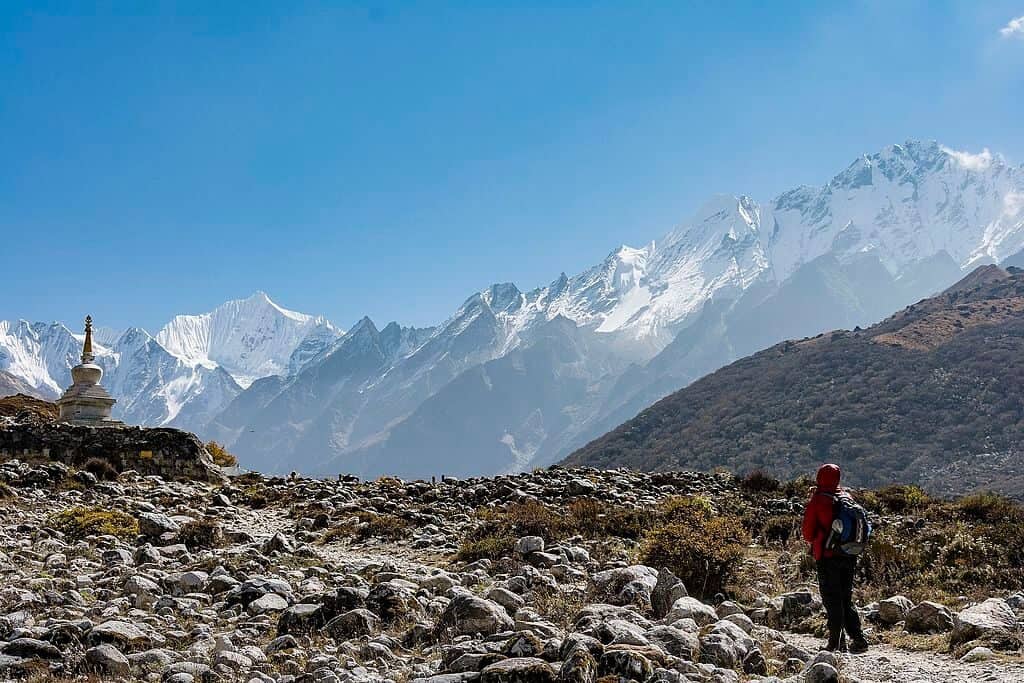
Some of the most recommended solo treks in Nepal are Everest Base Camp trek , Annapurna Base Camp Trek , Langtang Valley trek and Poon Hill trek .
And if you plan on trekking during the summer monsoon season in Nepal, you can take the Jomsom-Muktinath trek and Annapurna Circuit trek. These treks lie in the trans-Himalayan region and rain-shadow areas of Nepal. Hence solo trekking in monsoon in still possible here.
So, once you decide what trek you want to take you should start gathering detailed information on the trekking routes. You should know the trekking route, tea houses, food, local weather, the culture of the local, etc.
This way it will prepare you for the trek. And as for the duration, Nepal has treks that will last from a week to a month.
We recommend solo trekkers to try shorter treks before you opt for longer ones.
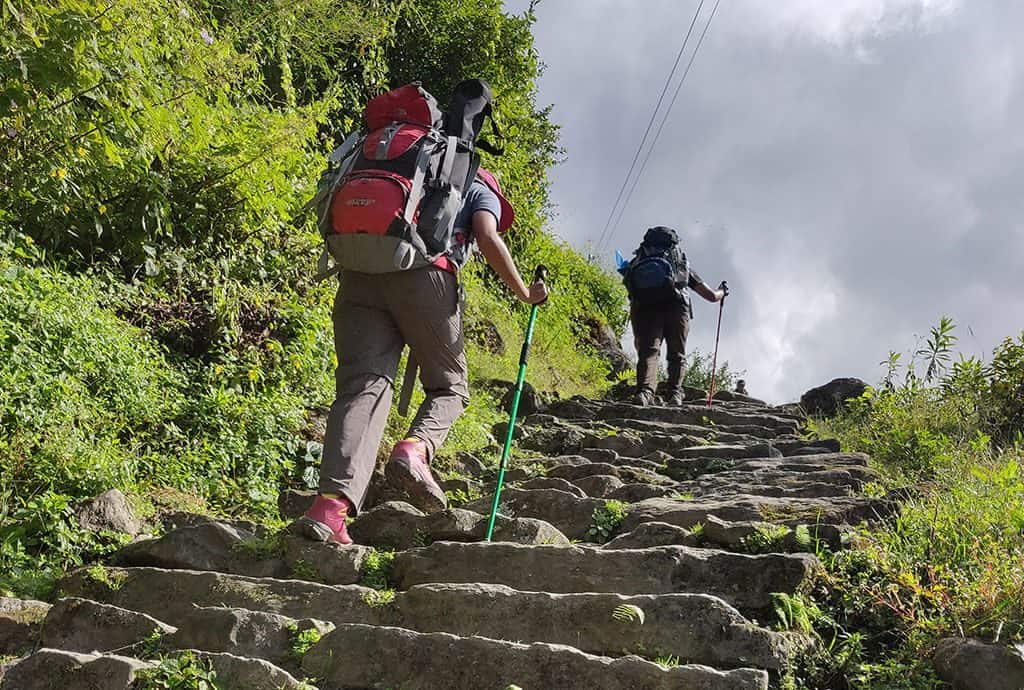
The right packing of necessary clothing and equipment can make or break your trekking experience. Hence once when you know when you are trekking know the weather condition and pack accordingly.
Make sure to carry all the necessary clothing requirements. Also, avoid overpacking or even underpacking.
As for the equipment you can find all the list and the supplies of equipment for a trek in Nepal. You can purchase or rent both in Kathmandu and Pokhara.
Be careful not to pack any unnecessary clothing or equipment. Because as a solo trekker, you will be carrying your own baggage. Hence anything extra will just add as a burden to you. So the most important thing to remember is to pack smart.
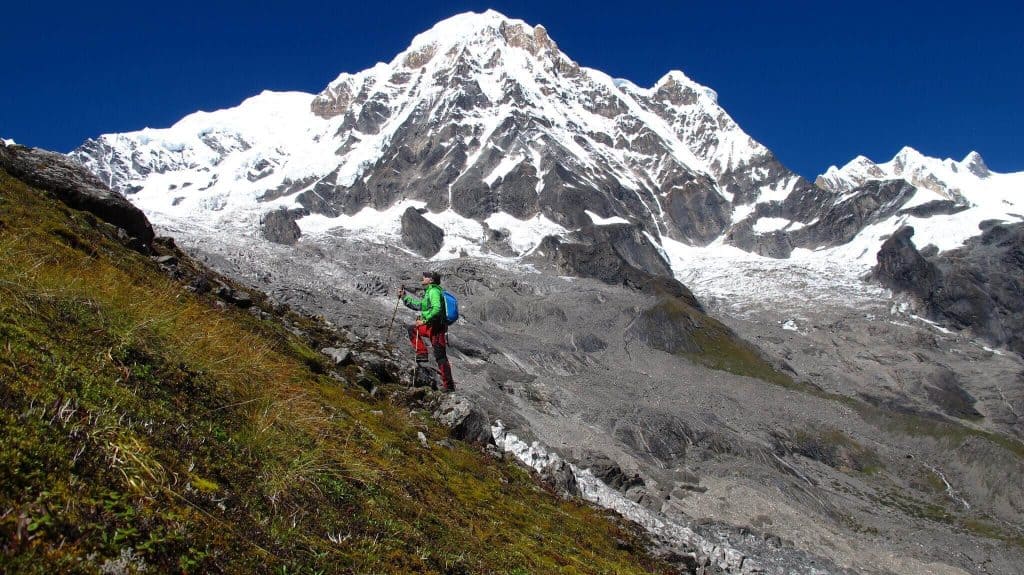
TIMS card ( Trekkers Information Management System) is compulsory for every trekker wishing to trek in Nepal. If you are trekking solo, you will get a green TIMS Card. And for group trekkers, they issue blue TIMS card.
Also, you need a conservation area permit if you choose to do treks that go through the conservation area. You can get both these permits easily from Kathmandu.
Yet for solo trekkers, these permits cost slightly more. Moreover, there are also permit for trekking in the restricted regions of Nepal. But these are not issued for solo treks.

Having a guide and porter has various advantages. Both of these ensure in making your trekking experience smooth and safe.
While trekking solo in Nepal, it is important to have at least one of the two. You also have the option of having a porter-guide who does the work of the two.
Yet, he or she will have less experience than a guide and will carry less than a porter.
Hiring a guide can make your trek a lot more comfortable and safe. They will have good information on the trekking trails. And will know what to do in case of emergency and danger ahead.
They can even recommend the best tea houses to rest and eat at. Moreover they will help you communicate with the locals. This will allow you to connect with the locals and know about their lifestyle and culture.
And with a porter, he will carry your 12 to 15 kg baggage. This will allow you to walk free to explore the trails in your own comfort. You can also opt for female guides in Nepal.
So if you choose to have a guide or porter, make sure to confirm their legal work status. And go with the only one you feel yourself in safe hands.
To trek in popular regions like Everest Base Camp and Annapurna Base Camp, a guide or porter is not compulsory. But to trek in some restricted areas of Nepal , trekking without a guide is not allowed for safety reasons.

Traveling in Nepal is quite affordable. Nepal is one of the most affordable trekking destinations in the world.
There are a variety of accommodations to choose from and you can choose the one that best suits your preference and budget.
However, avoid choosing the cheapest accommodations as the facilities in these can be very low and personal hygiene very poor.
Hence do check your rooms before confirming to have a comfortable sleeping area. A porter can cost you from USD 10 to 15 per days. And a guide can cost you around USD 20 to 25.
The choice is yours if you want to have both or either one from the two. And do keep some Nepali currency for tipping to the guide or porter who helps you with the accommodation. This little amount can light up their day.
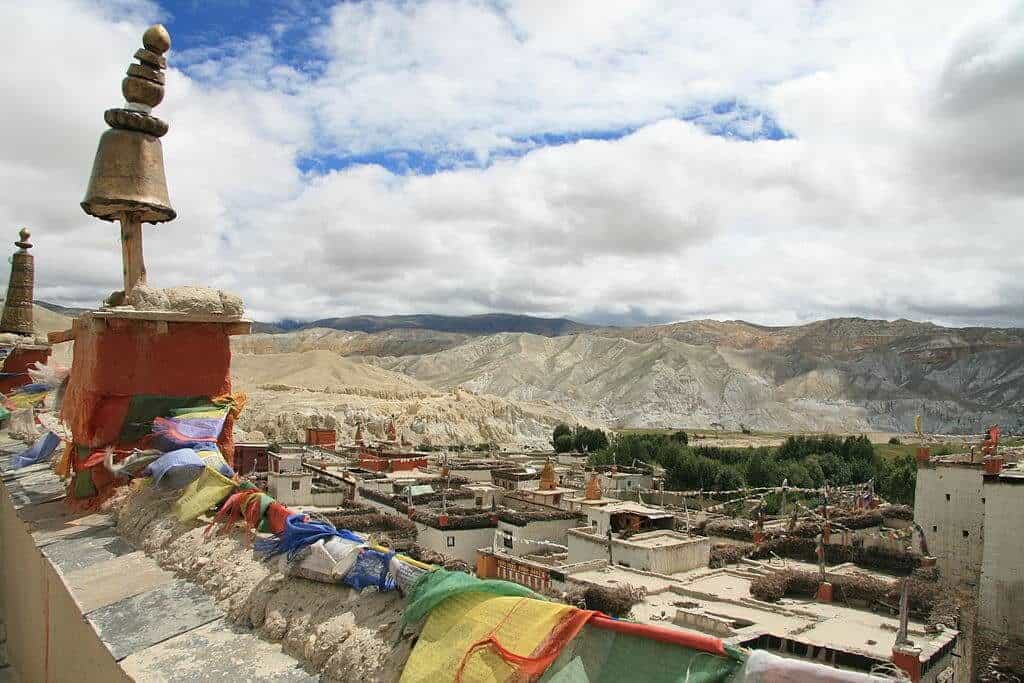
The type of treks you choose determines the physical fitness for a Solo trekker. If you are someone who can comfortably walk on rough terrains for 6 to 7 hours on a daily, then you can do any treks in Nepal.
Yet it is important for Solo trekkers to take more preparations and training. You can start preparing for your treks at least 2 months before the trek. You can do so by taking short to long hikes in nearby places.
Also, it is important to consult with your physician before you start preparing for your trek. He or she can examine you and see if you have any underlying condition. Or if you are fit to take the trek.
Hence do not undertake any solo trek unless recommended by your physician.
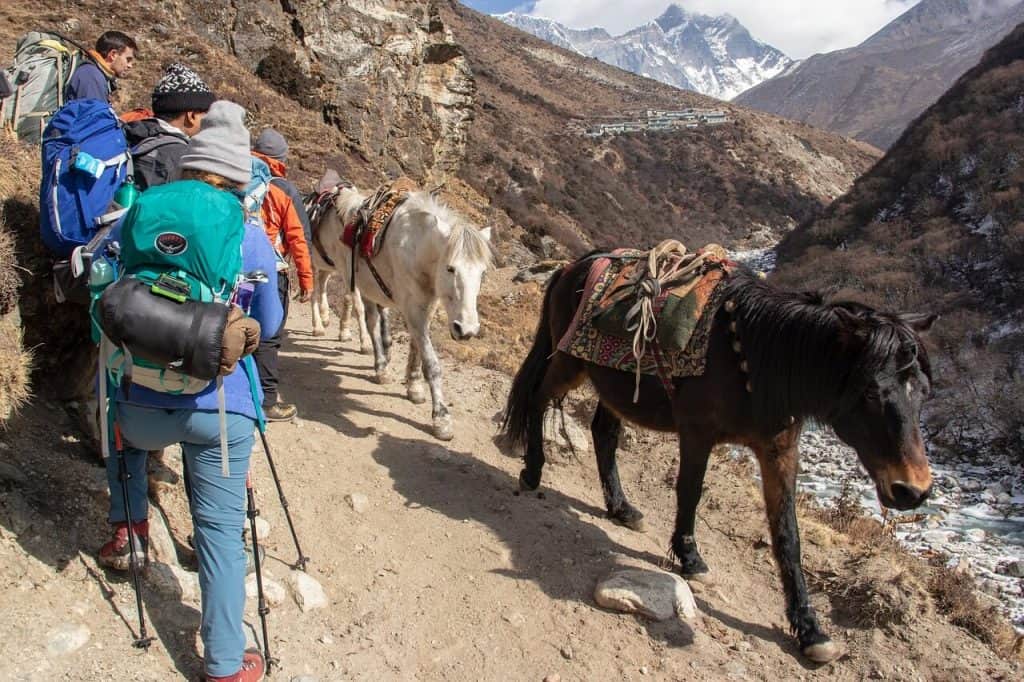
Nepal is one of the safest places to trek in. Female trekkers who want to take solo treks can also go for it.
However, it is best to take safety measures. And for those who are going on their first treks to Nepal, it is important to trek with a guide, porter or a trekking partner.
The trekking trails in Nepal are very rocky and rough. In the remote area, phone and internet coverage can be poor. You have a high chance of forgetting your way to the top or either back to the city.
There would rarely be any kind of sign in your way. Hence for the first time trekkers, the trails are going to be harsh and confusing. However, if you have already trekked before in the same trail, you may be able to trek it next time.
Due to poor signs, there are high chances of forgetting your trekking trail as they all look similar.
So for safety reasons, it is best to have a reliable and professional trekking guide with you.
Pros and Cons of Solo Trekking
There are pros and cons to everything. And Solo trekking is no exception. Down below let us discuss some advantages and disadvantages of solo trekking.
- You can set your own pace : This is one of the main advantages of trekking alone. When you trek with a group there are people who often want to go fast and you end up breaking yourself trying to keep up. And on the other side, there are slower and less confident trekkers for whom you have to slow down. Hence trekking solo allows you to walk on your own pace.
- More flexible : Similarly when you are on your own, you don’t have to worry about what other people want. If you decide you want to take a detour or break, you can. Or if you want to push on to the next campsite you can without having to think for others.
- More Peaceful: Trekking solo and being on your own gives you more time to think about things and admire the beauty that surrounds you. It gives you solitude and more peaceful time with nature.
- Easier logistics : If all your friends are busy or you have no friends, you can either hike on your own or not at all.
- Less support in case of injury : This is a major disadvantage while trekking alone. If you fall or trip, you have no one else to help you. The seriousness of the issue will depend on your situation. For injuries that you can walk out, it is not a problem as long as you have a decent first aid kit.
- The greater risk from wildlife/humans : Depending on where you are hiking, there may be dangerous wildlife or risks from other people. In general, these risks will be greater while traveling alone. A single person as easier prey than a group.
- Can be lonely: Being on your own all day can be very lonely especially while eating when you can normally chat with the rest of the group. Hence this can leave you with little to do particularly when it gets dark. However, this may or may not be an issue depending on your personality.
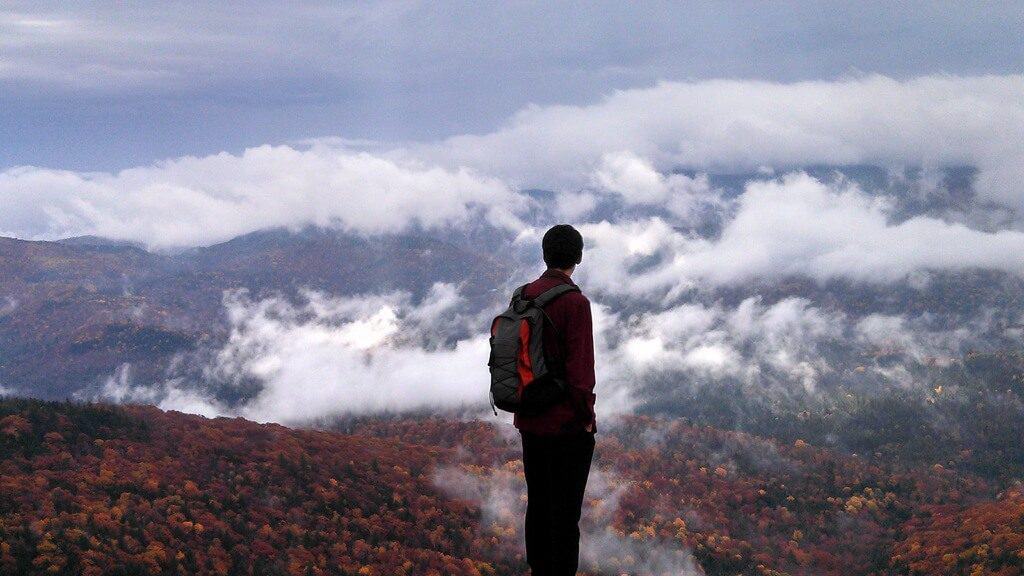
- Choose a safe season with a good weather condition and pack all the necessary items you will need for the trek.
- Altitude sickness is possible despite being physically fit and prior trekking experience. Hence it is important to knowledge yourself about ailments related to high altitude. And in case of any symptoms related to altitude sickness, reach out for help immediately.
- It is always wise to inform someone trustworthy near you about your plans and places that you are staying. This is a great safety precaution.
- Choose a trekking destination within the trails that you can reach comfortably in time. For solo trekkers, it is not recommended to trek once it gets dark.
- Have travel insurance that covers treks to foreign countries including Nepal. Also, make sure your insurance covers emergency evacuation and rescue as well.
- Carry enough Nepali cash to cover your expenses for the entire trip. There are no ATM’s in the remote trails. The few that are there in some region are not always reliable.
- Do not take unnecessary risks. Stick with the trekking route and destination you have chosen while trekking solo.
- Walk slow and take necessary breaks. It is also very important to drink plenty of water to stay hydrated. This even reduces the risk of AMS( Acute mountain sickness).
- Keep extra days in case of any unplanned situation like delays or injuries.
Solo treks in Nepal opened to the foreigners in the 1970s. Hence it is not something new in Nepal.
But, while trekking solo one should be careful on the trails and with the strangers, you meet on the trails during your solo trek.
If you choose to trek in the popular trekking trails during the peak season, Solo treks are great and safe. Hence choose a safe time.
For further question or queries, please feel free to contact us. It is our pleasure to guide and assist you with the best of our knowledge.
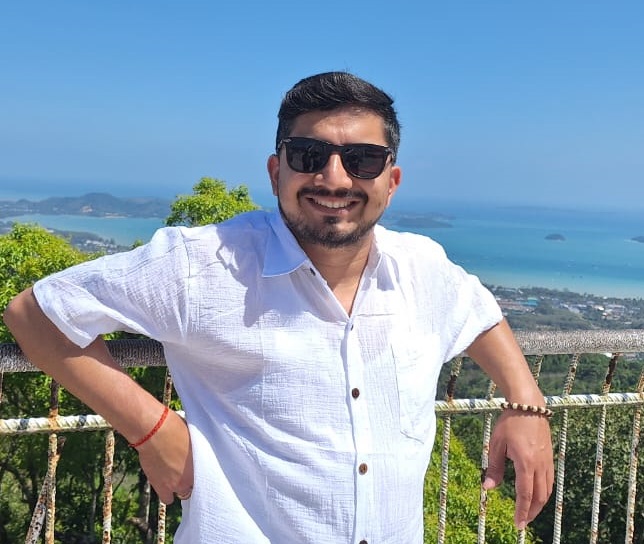
Madhav started working as a porter in 2001 and then moved on to work as a trekking guide. After working in the trekking and tourism industry for eight years, he co-founded Mosaic Adventure in 2009.
Madhav has trekked to most of the trekking destinations in Nepal, including Everest Base Camp Trek, Annapurna Base Camp, Annapurna Circuit Trek, Poon Hill Trek, Jomsom Muktinath Trek, Indigenous Peoples Trek, Langtang Valley Trek, Mardi Himal Trek, and all of the day hikes around Kathmandu.
He has also extensively traveled to other countries such as Australia, the USA, the UK, France, Hong Kong, Japan, China, the Philippines, the UAE, Saudi Arabia, Bahrain, Thailand, Turkey, and India. Madhav is the one who answers most of your questions about trekking and tours and helps to plan your trip by giving a personal touch.
You may also be interested in...
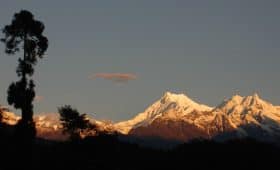
Kanchenjunga Base Camp Weather
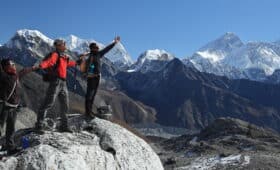
Three Passes Trek vs Everest Base Camp
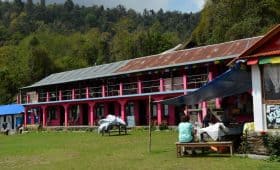
Nepal Teahouse Trek
Leave a reply cancel reply.
Your email address will not be published. Required fields are marked *
Save my name, email, and website in this browser for the next time I comment.
Trekking In Nepal – A Comprehensive Guide

Some of the links on this page are affiliate links
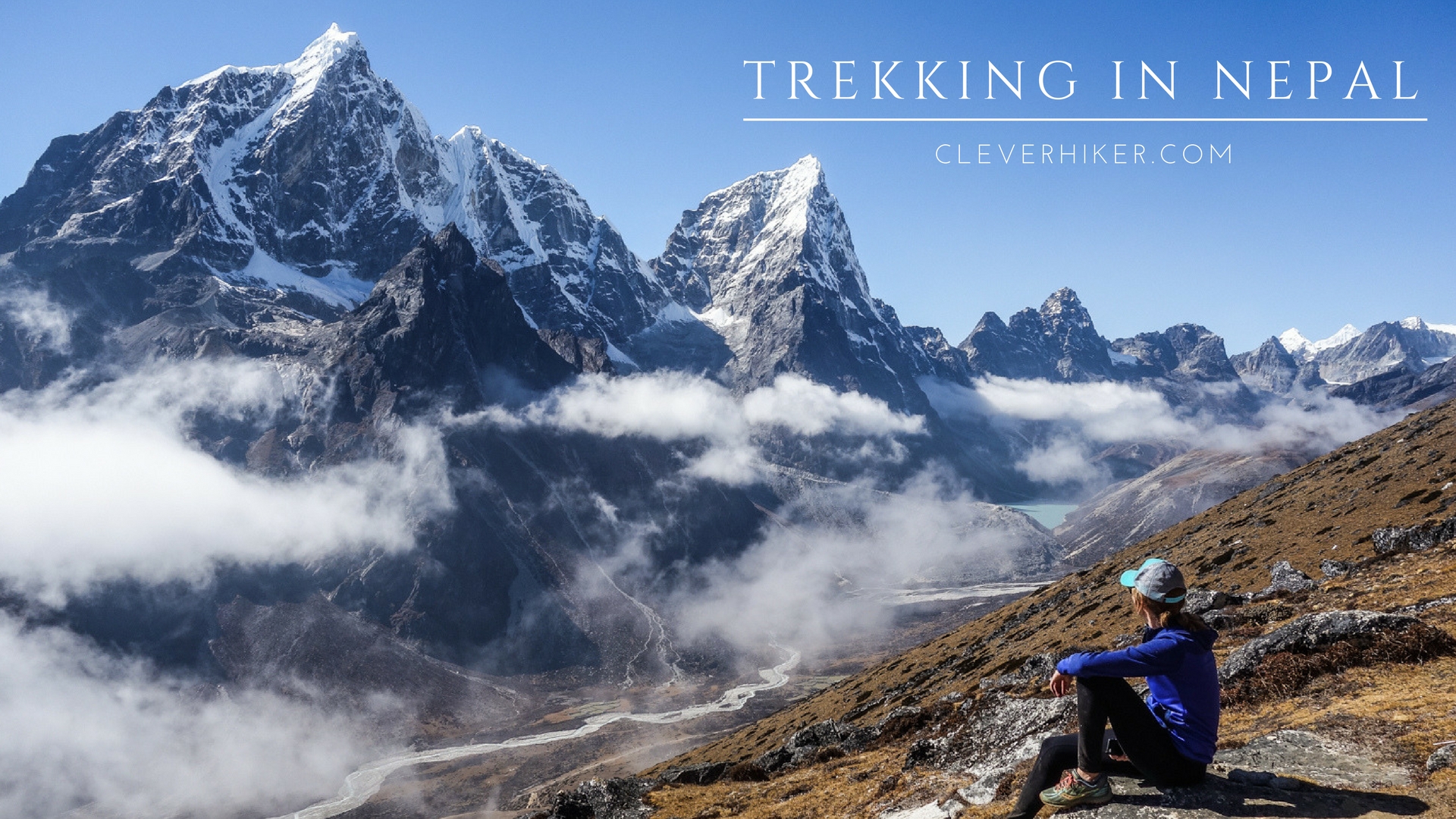
Nepal is one of the most stunningly beautiful countries on the planet. It’s a place where towering white peaks touch the sky, monks peacefully meditate in ancient mountainside monasteries, and lumbering yaks haul goods to quaint villages largely disconnected from the outside world. To put it simply, Nepal is a backpacker’s dream come true.
For all it’s grandeur and immensity, planning a trek in Nepal isn’t as difficult as you might think. Trekking tourism has been popular in Nepal for decades and Nepalis are excellent hosts. Kathmandu has hundreds of quality guiding companies and “teahouse” lodges bring an entirely new level of comfort to the backcountry. Even for those with little backpacking experience, trekking in Nepal is likely to be accessible, affordable, and absolutely unforgettable.
So if you enjoy stunning views, radiant culture, and epic adventure, chances are you’ll fall in love with Nepal. We hope you find this guide useful for planning your next trip.
Check out our Nepal Trekking Gear Checklist to help you with planning your adventure.
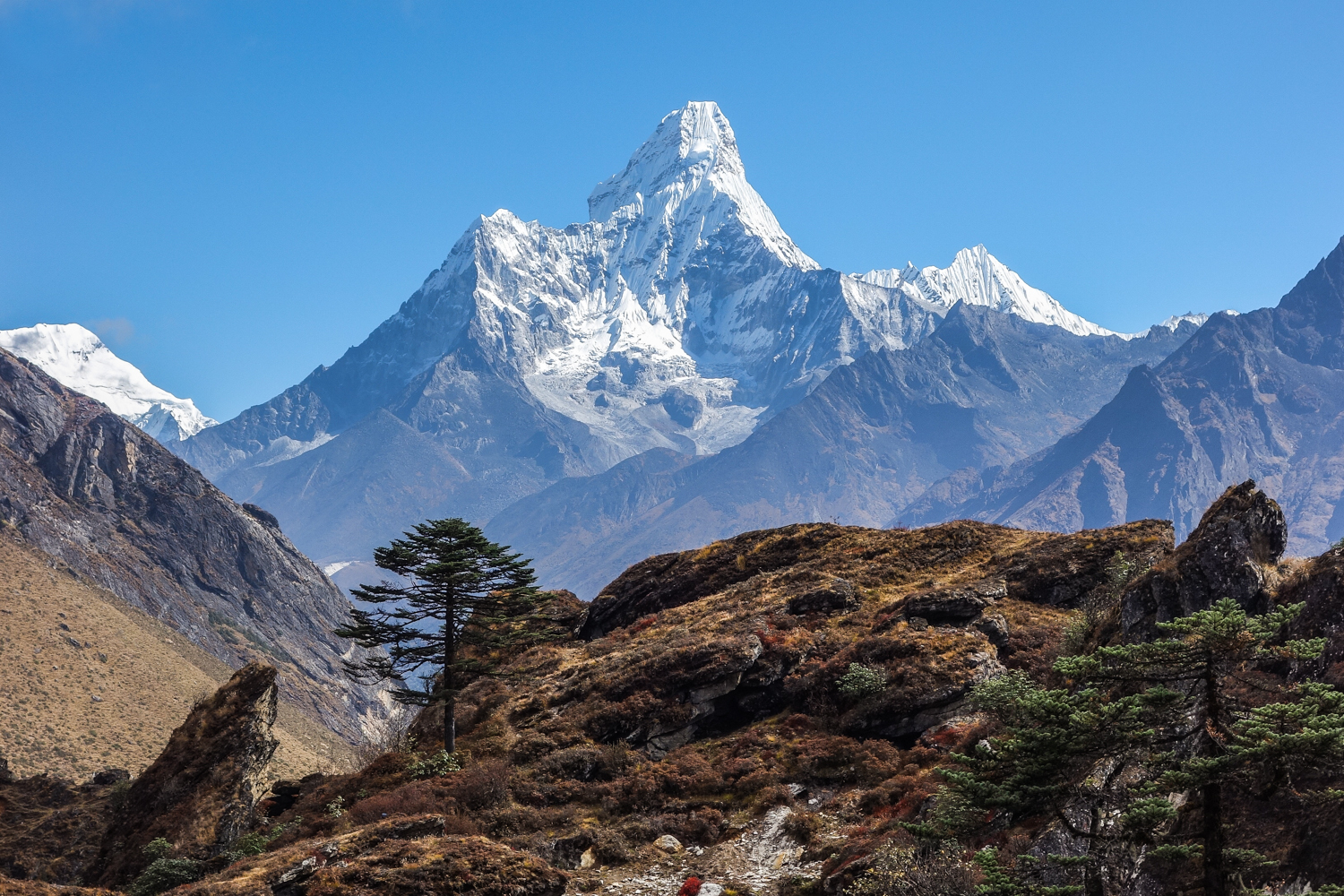
BEST TIME TO TREK
Technically you can hike in Nepal year round, but most trekkers choose between the two peak hiking seasons of fall and spring. If it’s your first time trekking in Nepal, we recommend visiting during one of these peak seasons. The trails will be more crowded, but the benefits tend to be worth it in our opinion.
Fall (October – November) : This is the most popular trekking season in Nepal. During this time you’ll have the best chance for clear mountain views, sunny skies, mild temperatures, and little precipitation. The downside is that you’ll be sharing the trail with throngs of other tourists and teahouses will be bumping, especially along the most popular routes.
Spring (March – April) : Spring is the second most popular time of year to trek in Nepal. As the snowpack melts on high mountain passes, giant rhododendron trees bloom across the hillsides of Nepal. Temperatures are generally mild this time of year and it’s a good time for viewing wildlife too. The two main downsides to spring hiking are busy trails and the possibility of hazy skies, which can obscure mountain views. That said, hazy skies tend to be less of an issue as you climb in elevation.
Off Peak Season : Trekking outside the peak seasons in Nepal can be rewarding as well. Solitude is easier to find, prices are cheaper, and befriending locals is easier too. That said, there are significant downsides to trekking outside the peak seasons in Nepal, so don’t be too cavalier when choosing your travel dates.
Experienced winter travelers ( December – February ) can find sunny days and brilliant mountain views this time of year. That said, temperatures can be bitter cold, daylight hours are shorter, and harsh winter storms can disrupt travel plans with little warning. Also, many popular trails will not be accessible this time of year due to heavy snowfall at high elevations.
Trekking during monsoon months ( May – September ) is not usually advised. Monsoon rains bring landslides and leaches to Nepal. The former makes mountain travel very difficult (if not dangerous) and the latter is just gross and obnoxious. The weather can also be hot and humid this time of year and the mountains are often obscured by clouds.
TEAHOUSE TREKKING
One of the reasons Nepal is such an amazing place to hike is the teahouse trekking culture. “Teahouses” are essentially small mountain lodges frequently spaced along popular trails. On most trails in the Everest, Annapurna, Manaslu, and Langtang regions you’ll pass a teahouse every hour or two. They’re a great place to meet other travelers, eat a home-cooked meal, warm your toes by the fire, and bed down for the night.
On a teahouse trek you’ll sleep in one of these lodges every night and you’ll eat almost all of your meals in teahouses too. Accommodations are usually simple, comfortable, and very affordable. It’s expected that you’ll eat your meals wherever you stay, which is one of the reasons rooms are so cheap. Teahouses also sell snacks, candy, hot showers, beer, and sometimes even halfway decent wifi.
Most teahouses cost around $3-5 per night and can be booked upon arrival. The usual setup is a small room with two twin beds and a shared bathroom down the hall. Some teahouses have rooms with attached bathrooms, but you’ll likely pay a premium for the upgrade. Blankets may be provided, but we recommend hiking with a sleeping bag for warmth, comfort, and cleanliness (learn more: Nepal Equipment Guide ).
For those looking to hike in Nepal’s more remote areas, camping treks can be arranged through most trekking agencies in Kathmandu. This option will add cost and complexity, but could lead to a unique and rewarding trek. That said, camping treks aren’t nearly as popular as teahouse treks and camping won’t be necessary on any teahouse trekking route.
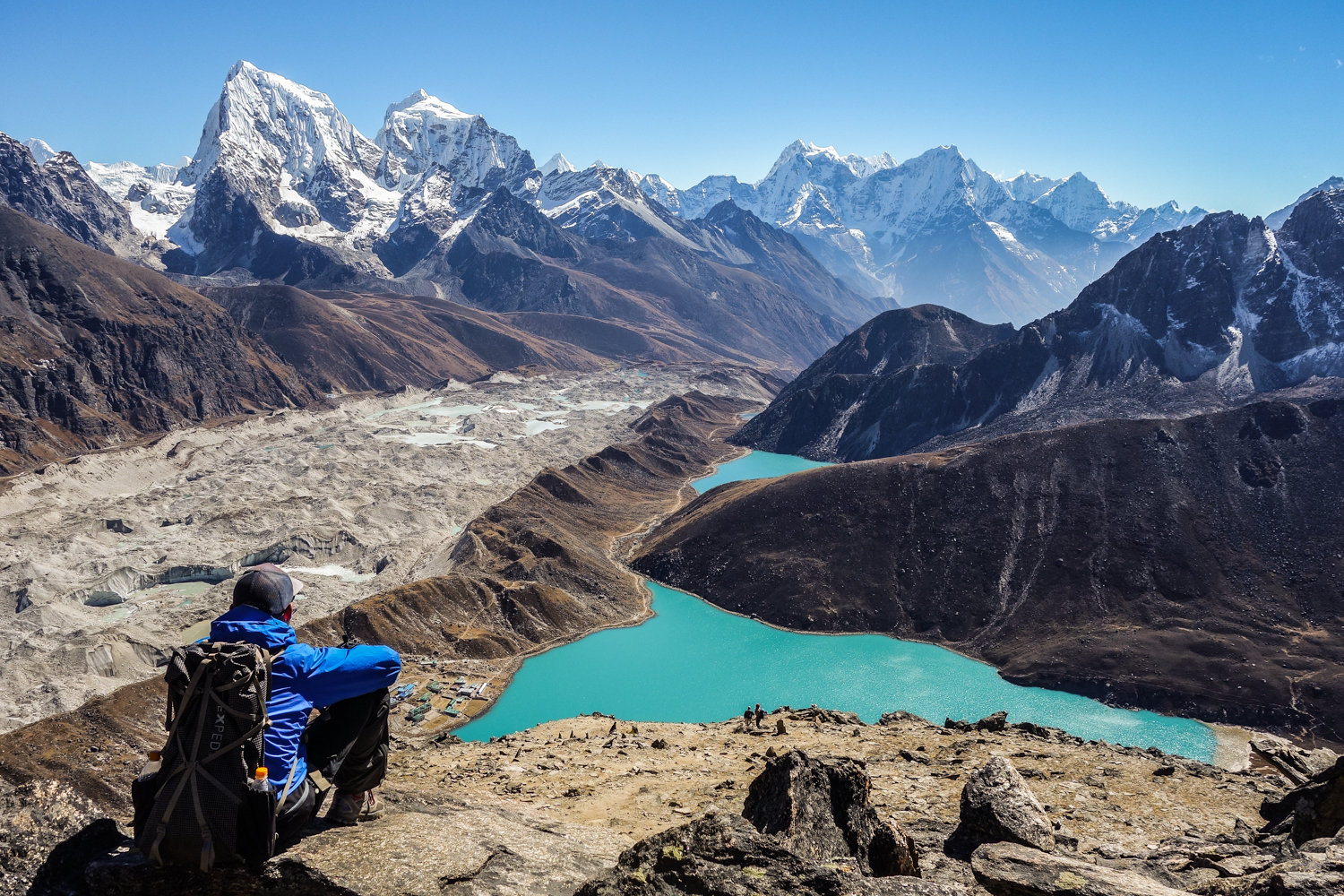
POPULAR TEAHOUSE TREKS
It would be impossible to list all the fantastic and unique trails in Nepal. So instead, we wanted to highlight a few of our favorites and some popular recommendations. These teahouse trekking routes are all exceptional hikes, and they’re a great place to start.
Everest Base Camp
Difficulty: Moderate to Difficult
Best Time: March-April & October-November
This is the most popular trekking route in Nepal, and with good reason. Walk in the footsteps of the world’s most famous climbers and gain a spectacular view of Everest from the peak of nearby Kala Patthar.
Annapurna Circuit
An extremely popular and stunning trek with lots of variety. This route combines spectacular mountain scenery with Tibetan-influenced culture and culminates at one of the highest trekking passes in the world, the Thorong La.
Annapurna Base Camp
Difficulty: Moderate
A fantastic trek for those with limited time still wanting to experience a stunning Himalayan amphitheater of mountains. This is also a lower elevation hike, which may make it better for those worried about altitude or hiking off-peak season.
Everest Three Passes Loop
Difficulty: Difficult
For those with the time and physical ability, this is one of the most spectacular trekking routes on the planet. Hit the highlights of the Everest Base Camp route and the stunning Gokyo Lakes on this epic and increasingly popular loop.
Langtang Valley
Once among the most popular trekking routes in Nepal, this area was hit hard by the 2015 earthquake, but it’s on the rebound. Trekkers looking to avoid crowds on a hike filled with Tibetan culture, natural diversity, and fantastic Himalayan scenery should definitely take a closer look.
Manaslu Circuit
This trek features spectacular mountain scenery coupled with a rich and authentic Tibetan culture. Though Manaslu is gaining in popularity, it still sees a fraction of the travelers drawn to the Everest and Annapurna treks. Also, if you have the time, a side trip up the Tsum Valley should not be missed.
Gokyo Lakes
This is a great trek for those looking to avoid the crowds of hikers headed to Everest Base Camp but still seeking majestic Everest scenery. The views from atop Gokyo Ri may be the finest in all the Himalayas.
Upper Mustang
Best Time: May-October
This heavily Tibetan-influenced district oozes with culture and panoramic Himalaya views. The uniquely arid mountain landscape of this region makes it a good choice when other areas are soaked in monsoon rains. This is a restricted area though and permits are pricy.
Difficulty: Easy to Moderate
This lower altitude trek is a popular option among hikers looking for a shorter taste of Nepal’s trekking culture. The route isn’t nearly as remote as many treks, but the views from Poon Hill are still stunning.

DIFFICULTY RATING
Trekking difficulty will depend on a multitude of factors including your experience, physical fitness, pack weight, and weather conditions. There are many different types of treks to choose from in Nepal with varying degrees of difficulty. Make sure to choose a trek that fits your fitness level and train adequately before your hike.
Trekking trips in Nepal are not technical (no ropes, ice axes, or crampons), but there will still be big ups and downs. There are sure to be long days and sore legs, but treks in Nepal are paced to give a lot of time for rest and acclimatization, so don’t fret. It certainly won’t be easy, but most active hikers fair very well on Nepal’s trails, especially with some training beforehand.
Porters are another consideration for reducing the difficulty of your trek. A porter can be hired to carry heavy gear, so all you have to tote is a small daypack. This option greatly increases accessibility along Nepal’s trails. We were surprised and impressed by the amount of people in their 50’s, 60’s and even 70’s who we met on the trail.
INDEPENDENT OR GUIDED TREKKING
Update: Effective April 1, 2023, new requirements require solo or foreign independent trekkers to use a local guide or porter while trekking in Nepal’s national parks and protected areas.
This is an important question for many trekkers and the choice will likely come down to experience and personal preference. If you’re a highly experienced backpacker traveling along a popular route (Annapurna Circuit, Everest Base Camp, etc.), it’s likely that you’ll get by just fine without a guide. That said, Nepali guides bring more to the table than just logistics management. A good guide can help you learn about local culture and may even become a close friend.
For many popular trekking routes in the Annapurna and Everest regions you won’t be required to hire a guide. These trails are mostly well marked and have lots of travelers. This leaves the door open for experienced trekkers to hike independently, which is a nice benefit for those with the skills and know-how. If you’re unsure of your preparedness or nervous about high altitude safety, we recommend hiring a guide. Also, for trekking trips to any restricted area, you will be required to hire a guide.
If you plan to hike independently, make sure you have a good map, the proper permits, and a good guidebook before you leave Kathmandu (see map & guidebook section below). Also, expect to put in a good amount of planning time to fully prepare for your hike.
Guided Trekking Pros
All pre-trip details handled (permits, fees, etc.)
All transportation arranged (bus, plane, jeep, etc.)
Little worry about any details while hiking (lodging, route, schedule, etc.)
Guidance & safety while trekking at high altitude
Local information on religion, culture, food, etc.
Independent Trekking Pros
Can be much less expensive
Hike on your own schedule
More direct interaction with locals
More choice on where to stay & eat (though guides usually know the best spots)
No group dynamics to deal with, just you and the trail.

GUIDES AND PORTERS
Guides and porters are very common in Nepal (though not always mandatory) and prices are quite competitive. In general a guide will cost around $25-30 per day and a porter will cost around $10-15 per day. A guide will help with logistics, information, and safety on your trek. A porter will carry heavy gear, so you only have to hike with a small daypack.
If you choose to trek with a guide, make sure they speak fluent English because they’ll be the point person on your hike. They’ll manage transportation, lodging, food, hiking schedule, routes, and safety on the trail. Your guide will also be a good source of information on local culture, customs, festivals, and norms. A good guide can be an extremely useful resource on the trail and they may even become a lifelong friend.
Porters are also useful and very common along trails in Nepal. Porters have the job of carrying heavy gear, so you don’t have to. This is especially beneficial for older trekkers, novice trekkers, or groups with children. Just remember, even if you do decide to trek with a porter, it’s still very important to keep your gear weight to a minimum. Porters have an absolutely backbreaking job, so please don’t make it any harder on them.
Also, make sure to tip your guide and porters well. A good tip is about 15% of the total you paid for their services. Hand the money directly to each person to ensure they get the full payment. Guides and porters have very tough jobs and they often get surprisingly little compensation for their work.
Guide Recommendation
Looking for a guide on your trip to Nepal? I highly recommend reaching out to our friend Ganesh in Kathmandu. Ganesh is truly an exceptional guide and you’ll love trekking with him if he’s not booked up. He’s knowledgeable, friendly, funny, and highly experienced. Here’s his contact info: [email protected] , Ace Vision Treks & Tours or ACE Vision Nepal , and Ganesh on Facebook . Just tell him Dave & Annie sent you.
TREKKING COMPANIES
There are literally hundreds of trekking companies in Kathmandu and many of them are very good. With a little online research (try tripadvisor ) you should be able to find a bunch of highly qualified companies to help you plan a trek. Most companies plan treks advance, but you can also fly into Kathmandu and plan a trek in person surprisingly easily. Planning things in person will require more flexibility, but you’ll likely save a good chunk of change and have the chance to interview guides before your trip.
Trekking Company Recommendation
During our most recent three months in nepal, we worked with Ram at Outdoor Himalayan Treks . Ram was absolutely fantastic and we’d highly recommend contacting him if you have any questions. He gave us tons of useful information and helped us plan transportation, accommodation, and trekking permits on a few of our hikes. Here’s Ram’s contact info: [email protected] or Ram on Facebook . Just tell him Dave & Annie sent you.

GROUP OR SOLO TREKKING
Some trekking companies offer group packages for popular trails. This can be a good way for solo travelers and couples to link up with other hikers and save a little money in the process. There are downsides to traveling in a large group as well, so make sure you know what you’re getting into before you sign up. Many trekkers (us included) prefer hiking in small groups or with a personal guide. That type of travel will give you more flexibility and less compromise as you trek.
TEAHOUSE TREKKING GEAR
Need to know what to bring? Visit our Nepal Gear Guide & Checklist for personal recommendations on the best trekking equipment. You can also check out the CleverHiker Gear Guide for all our favorite non-Nepal equipment (tents, stoves, sleeping pads, etc.).
NEPAL GEAR GUIDE & CHECKLIST
CLEVERHIKER GEAR GUIDE
GUIDEBOOKS & MAPS
For general trip planning and research, we highly recommend picking up the Trekking in the Nepal Himalaya book. This book covers all the popular trails and some less popular routes too. It has extremely helpful information about trekking, accommodation, food, and general Nepal travel advice. We used this book nearly every day on the trail (we took pictures of pages with our phones to save weight) and found it very useful.
Once you decide on a trek, it should be easy to find specific maps and guidebooks when you reach Kathmandu. Just walk around Thamel (the main tourist hub in Kathmandu) and you’ll find lots of bookstores catering to trekkers with the most updated resources.
Make sure at least one member of your group is carrying a detailed map of your trek. You may not need it much for navigation (most popular routes are well marked), but it will still be useful. Also, a good guidebook with detailed trail descriptions can be helpful as well. It’s nice to know what challenges lie ahead and get excited for upcoming highlights.

TREKKING SAFETY
When hiking in Nepal, you’ll be heading into remote areas far from reliable hospitals. That’s why it’s important to take every precaution before you set out. Below you’ll find some of our safety tips for trekking in Nepal. Also, check out our emergency first aid skills tutorial video to brush up on your wilderness safety knowledge.
Educate yourself on Acute Mountain Sickness (more info below). Take the prescribed acclimatization days on high-altitude treks, stay hydrated, and listen to your body.
Helicopter evacuations are not uncommon in Nepal, and many of them are preventable. Evacuations like these can be incredibly pricy, so we recommend picking up trekking travel insurance before you trip.
Don’t trek alone. If you’re traveling solo consider hiring a guide or making friends to hike with.
Always pay close attention to weather conditions, especially on long pass days. Storms can develop quickly in the mountains and can be fatal if you’re unprepared.
Always hike with a lightweight first aid kit and the 10 backpacking essentials .
Leave a detailed itinerary with an emergency contact and write important phone numbers on a piece of paper that will be easy to find in an emergency.
When encountering yak or donkey caravans, move to the inside (away from any cliff) and let them pass. These animals can sometimes be clumsy and may bump into you.
Crime is not common in Nepal, but it’s not unheard of either. Keep a close eye on your belongings, especially your backpack filled with valuables.
Always carry enough water on the trail and stay hydrated. Also, bring a water purifier (more info below) to make sure your drinking water is clean.
Keep your eyes on the trail to avoid any missteps that could end your trek.
Be very careful around landslide and avalanche areas. Consult a guide or locals if a crossing looks difficult and don’t take unnecessary risks. Turning around is always an option.
HIGH ALTITUDE SAFETY
If you’re trekking in Nepal, there’s a good chance you’ll be hitting some high elevations, so it’s important to know the basics of high altitude hiking. Acute Mountain Sickness (AMS) is no joke, and if you make reckless decisions or ignore symptoms, it could even kill you. Most hikers take the time to acclimatize properly and experience limited AMS symptoms if any, so there’s no need to freak out. But you do want to understand AMS and take it seriously. Check out our high altitude safety tutorial video for more info.
TRAVEL INSURANCE
We highly recommend purchasing travel insurance if you plan to trek in Nepal. In fact, we wouldn’t trek in Nepal without it. Most trekking locations in Nepal are very remote, so if something goes wrong, you’re likely to need an emergency evacuation, and that can get insanely expensive.
When choosing travel insurance, make sure to buy a plan that will cover high altitude trekking and helicopter evacuations in Nepal. We did a bunch of research and ended up choosing World Nomads . Their rates were reasonable, their coverage was excellent, and communicating with them was easy. We fortunately didn’t need to use our travel insurance, but the peace of mind alone was well worth it.

POST EARTHQUAKE CONDITIONS
Nepal was hit by a massive earthquake in April of 2015 . Thousands died in the disaster and widespread damage affected many temples, buildings, roads, and some trekking infrastructure.
We spent 3 months trekking around Nepal in the fall of 2016 and had very few inconveniences due to the earthquake. Some signs of the devastation remain, but most trails have been fully repaired. Accommodations were safe and plentiful, especially along popular routes.
Teahouse food options are generally simple but sufficient. Menus are roughly the same at most teahouses (see example menu below) with the ubiquitous dhal bhat as a hearty and delicious staple. You will also commonly find momos (dumplings), pasta, rice dishes, soups, pizzas, and in some places yak steak and apple pie. A home-cooked warm meal will always be a nice treat at the end of a long day on the trail.
Although teahouse menus are always similar, you’ll notice that prices increase as you move farther away from cities. Most supplies must be carried by yak or donkey to remote locations, which explains the increase in cost. It’s also always a good idea to carry snacks when trekking between villages and on long pass days.
*Note: If you plan to book a trip through a trekking agency, make sure to talk about food costs ahead of time. Most companies will give you two options: 1) you pay an up-front fee that will cover all food costs on your trip or 2) you bring money and pay for meals as you go. The first option is easier because you won’t have to hike with lots of cash and handle money throughout the day. The second option can be much cheaper though, because you’ll only pay for exactly what you order.
Below is an example of a typical teahouse menu. Prices are displayed in Nepalese Rupees (about 100 = 1 USD). For reference, this was one of the most expensive teahouses we visited.

It’s important to have a water treatment plan before you trek in Nepal. Water is usually easily accessible, but you’ll want to purify it first for safety. Water treatment pills, UV sterilizers, and water filters are all popular options. You can also purchase bottled water from teahouses, but that’s an eco-unfriendly strategy that will greatly increase cost and waste on your trip. We used a SteriPEN Ultra on our last Nepal trip and we highly recommend it. It was fast, easy to use, and we didn’t have to ingest any funky tasting chemicals.
While hiking, we recommend carrying at least 1-2 liters of water and filling up often. Staying hydrated is essential while trekking and it becomes increasingly important as you hike higher in elevation. Also, it’s easy to forget about drinking water when it’s chilly outside, but it’s imperative to stay hydrated. Ordering pots of hot tea can be a great way to ensure you’re getting enough fluids on cold days.
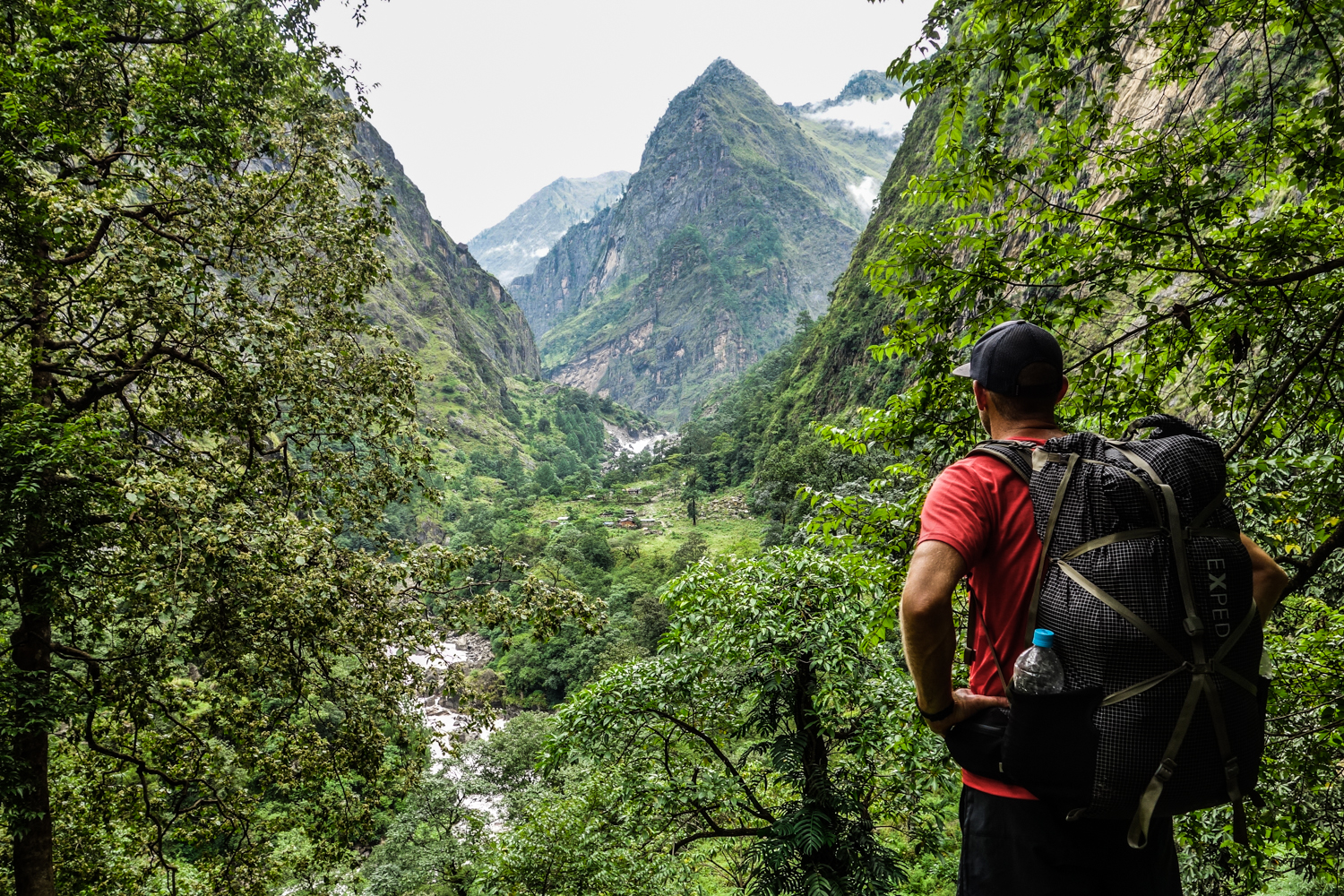
Trail towns don’t have ATM machines and teahouses rarely accept credit cards, so you’ll want to make sure you bring plenty of cash for your trek. In the fall of 2016, we budgeted around $30 per person per day for food and accommodation on our treks. In the Annapurna and Manaslu regions that budget covered our daily expenses and then some. We often had extra funds for treats like hot showers, beer, and baked goods. In the Everest region our $30 per day didn’t go quite as far, but we were still able to buy the occasional treat.
In general, it’s always smart to carry more cash on the trail than you might think. Luxury items like chocolate, tea, beer, wifi, and hot showers are all great morale boosters, but the costs add up. You may also want to buy small gifts, replace broken equipment, or hire transportation if your travel plans fall through.
It’s also important to consider the costs of charging your electronic devices. Some teahouses will let you charge batteries for free, but most collect a fee. Usually you’ll be able to get a full battery charge for $2-5, but in remote areas it can cost more.
Most teahouses offer hot showers for a fee, usually around $3-5 per shower. Showers will range in quality from a bucket of hot water to the rare proper shower. We found it often wasn’t worth the cost for a mediocre shower, so we recommend bringing wet wipes for quick cleaning.
*Note: Namche Bazaar in the Everest region does actually have an ATM machine, but it can be inconsistent, so we wouldn’t recommend counting on it.
TRANSPORTATION
Most visitors fly into the Tribhuvan International Airport (KTM) in Kathmandu, the capital city of Nepal. Kathmandu is a great base for sightseeing, planning a trek, or any last minute hiking preparations.
In general, transportation around Nepal is very slow going. Long bus rides, cancelled flights, and unexpected delays are sadly part of the norm. So make sure to give yourself a couple buffer days when planning your trip and embrace the adventure.
Most popular treks depart directly from Kathmandu or Pokhara, the second largest city in Nepal. Some treks are accessible via flight, but many require a long bus or jeep ride to the starting point. Depending on your destination, there will usually be a couple different options to get there. Local transportation tends to be cheaper, but “tourist” options will often be far more comfortable.
If you organize a trip through a trekking company, they will take care of the logistics for you. If you choose to trek independently, you’ll need to get the proper permits and pay any park/conservation fees before your trek.
Every trekker in Nepal needs a TIMS card ( Trekking Information Management System ), which costs around $20. You can get your TIMS card and pay your park fees at the Nepal Tourism Board offices in Kathmandu or Pokhara before your trek.
It’s also likely that you’ll need to pay conservation or national park fees. These can be obtained ahead of time and commonly cost around $20-$30, depending on where you’ll be hiking. You may be able to pay some park fees on the trail, but we found it much easier to take care of everything ahead of time.
UPDATE- JANUARY 13, 2018 – There have been some changes to the TIMS requirements for the Khumbu (Everest) region. It is no longer necessary to obtain a TIMS Card for this area. Instead, they are collecting a Khumbu pass, which costs NRS 2000 or USD 20 per person. It is uncertain how long this change will stay in place as many people in the travel agencies are unhappy with the system. We always recommend checking the most current requirements before beginning your trek.
PERMITS – RESTRICTED AREAS
There are several restricted areas in Nepal that require special trekking permits. If you’re heading to one of these areas you’ll need to obtain permits through a registered trekking agency and travel with a guide. As of March 2017, the following areas require restricted-area permits: Manaslu, Nar-Phu, Tsum Valley, Upper Mustang, Dolpo, Kanchenjunga, and Humla.
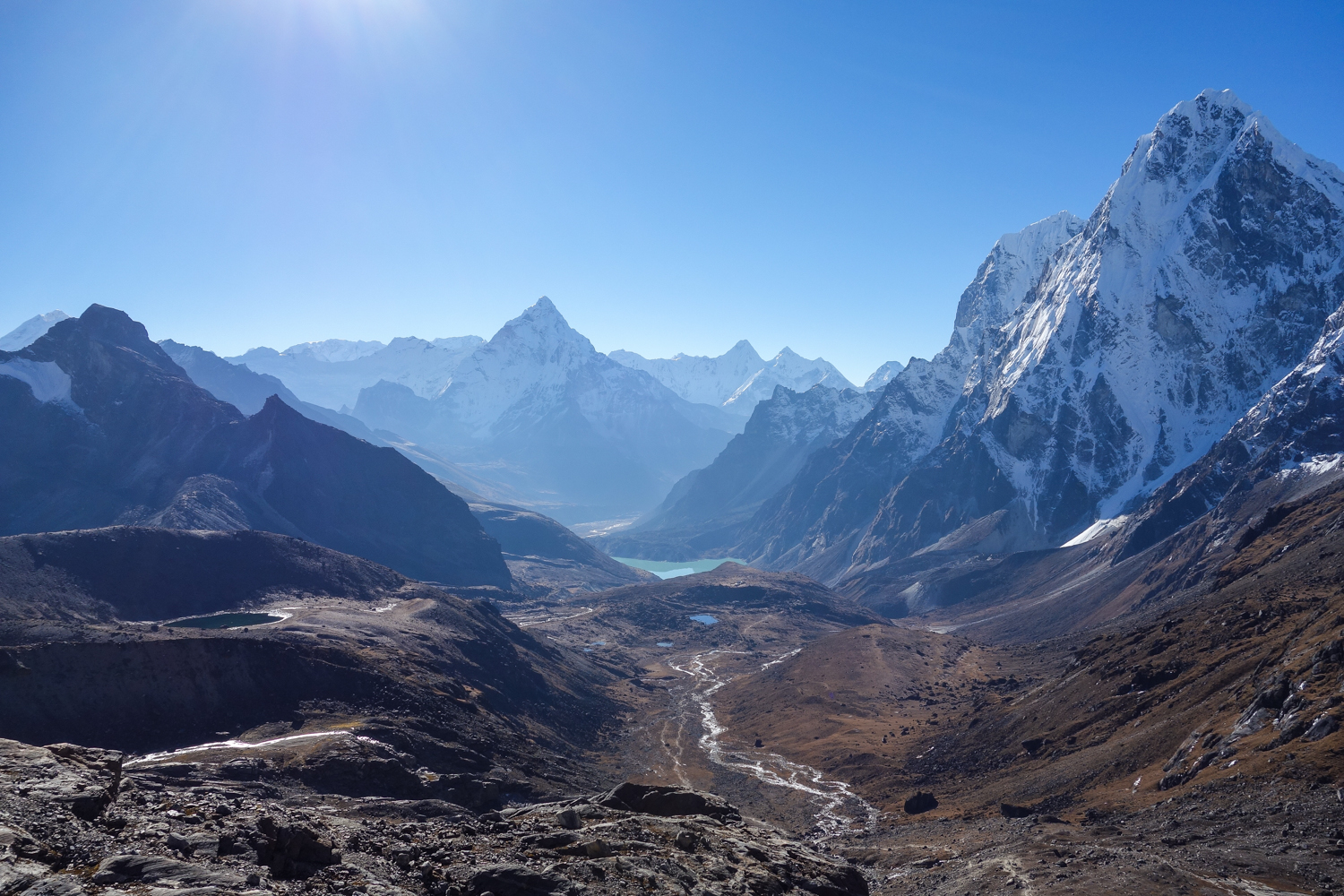
PHONES AND WI-FI
For better or worse, it’s becoming increasingly easy to stay connected while trekking in Nepal. Along the most popular routes, some teahouses sell wifi and you may even get a phone signal using a local SIM card. Don’t count on staying connected though, because service is often unreliable at best.
If you buy a local SIM card in Kathmandu, there are two main companies to choose from: Ncell and Nepal Telecom. As of fall 2016, there was minimal (if any) coverage in remote regions, such as Manaslu, Tsum Valley or Dolpo. In the Annapurna region, Nepal Telecom SIM cards seem to work okay, while in the Everest region, NCell was a better bet. We were far from impressed by phone connectivity on the trail, but we expect coverage will get better in the coming years.
Wifi may be available at some teahouses along your trek as well, though speed and functionality will be highly variable. In the Everest region they sell pre-paid wifi cards (around $3 for 100mb) that work well but get used up quickly. In contrast, on the Annapurna Circuit you may pay a one time fee of $3-5 for wi-fi access, but connections can be very slow (if working at all).
VISA INFORMATION
In order to enter Nepal you will need to obtain a tourist visa. Most people get a visa on arrival at the Tribhuvan International Airport in Kathmandu. You can also do this ahead of time at a Nepal Embassy if you are traveling overland from India.
As of March 2017, US travelers had three tourist visa options. You could choose a 15 day visa ($25), a 30 day visa ($40), or a 90 day visa ($100). There are electronic visa machines at the international airport and staff to assist with forms. We applied for a 90 day visa on arrival and found the process to be surprisingly quick and efficient.
Please check current visa guidelines for specific information as these policies can change and this website is not an official source of information on Nepal visas.
RESPONSIBLE TREKKING & CULTURAL CONSIDERATIONS
The number one rule of backpacking conservation is Leave No Trace . Learn it and live it.
Don’t buy bottled water in teahouses. The extra cost and waste are not worth it. Instead, use treatment pills, a water filter, or a UV sterilizer. We used the SteriPEN Ultra and loved it.
Don’t litter. Pack out your trash and keep Nepal beautiful for generations to come. If you really want to be a superstar, pack out trash that you find along the trail.
Deforestation is a real problem in Nepal. Avoid using firewood and stay in lodges that use eco-friendly fuel.
Dress conservatively, especially when sightseeing in towns. For women, this sadly means no shorts or shirts that show shoulders.
Public displays of affection are frowned upon in Nepal, so save it for private time.
Walk to the left of religious monuments such as mani walls, chortens, and prayer wheels. If you spin a prayer wheel, always spin it clockwise.
Follow the rules when visiting temples. Shoes off, no exposed shoulders, cover your legs, and don’t take pictures inside. Also, don’t enter Hindu temples wearing leather products.
Always ask permission before taking a photo of a person. Most people won’t mind, but if they decline, respect their wishes.

MORE RESOURCES
Hopefully you found this guide helpful for planning your trip to Nepal. We have truly fallen in love with Nepal and we know you will too. For more helpful resources check out the following links:
Nepal Gear Guide & Checklist
Best Backpacking Gear – CleverHiker Gear Guide
CleverHiker Top Gear Awards
Essential Trail Skills Video Series
L ightweight Gear Basics Video Series
And as always, please feel free to leave a comment below if you have any recommendations, questions, or suggestions. Take care and happy hiking!
Disclosure: Some of the links on this page are affiliate links, which means we may receive a small commission if purchases are made through those links. This adds no cost to our readers and helps us keep our site up and running. Our reputation is our most important asset, which is why we only provide completely honest and unbiased recommendations.
You are using an outdated browser. Please upgrade your browser to improve your experience.

Solo Trek in Nepal
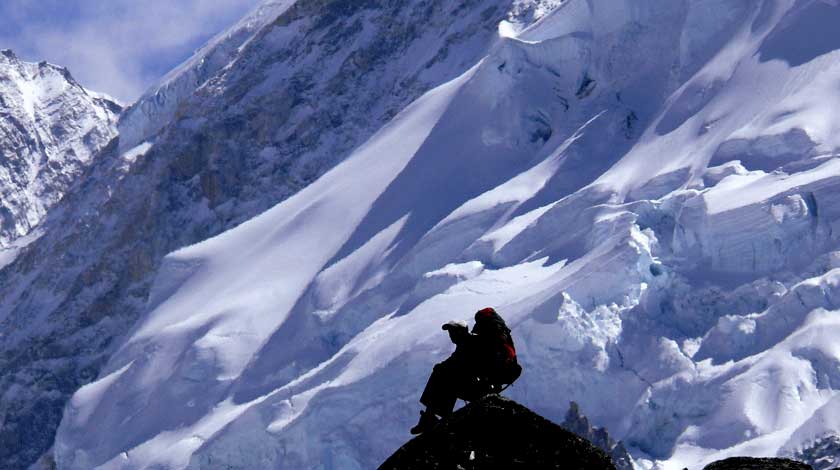
Solo trek in Nepal
solo trek in Nepal is an enriching and fulfilling adventure that allows you to immerse yourself in the breathtaking landscapes and diverse trekking destinations of this Himalayan nation. Whether you choose renowned regions like Everest Base Camp Trek 12 days , Annapurna Base Camp, or the Classic Annapurna circuit trek , or opt for lesser-known gems like Langtang Valley, Ganesh Himal, or Gosaikunda-Helambu, the experience promises to be unforgettable.
Choosing to trek solo provides a unique opportunity to tailor the journey according to your preferences and pace. While hiring an experienced guide is an option, solo trekkers in Nepal can navigate the trails independently, benefiting from a deeper connection with nature and the mountains. Although accommodations might pose challenges for solo trekkers in popular regions during peak seasons, the less-explored areas offer more flexibility, allowing solo travelers to find suitable lodgings even during the busiest times.
Nepal, renowned for its warm hospitality and friendly locals, is a haven for solo trekkers. The local guides and porters, intimately familiar with the terrain and lodge owners, ensure a smooth and secure journey. The country’s popularity among solo trekkers stems from the freedom it offers—the freedom to explore, reflect, and challenge oneself amidst stunning natural beauty.
In contrast to group treks, where securing accommodations during peak seasons can be daunting and requires advanced booking, solo trekkers enjoy greater flexibility. The absence of coordination with a group allows for spontaneous changes to plans, invaluable when adapting to unforeseen circumstances or shifting weather conditions.
The timing of your solo trek plays a crucial role in the overall experience. While March to May showcases Nepal’s lush landscapes with blooming rhododendrons, September to November offers excellent mountain views. However, it is essential to be mindful of the increased costs during these peak seasons due to the influx of visitors. To ensure safety and convenience, pre-booking accommodations, food, and transportation are recommended.
The benefits of solo trekking extend beyond the logistical advantages. Setting your own pace and making independent decisions empower you to shape your adventure according to your preferences. The solitude of a solo trek provides a unique opportunity for self-reflection, allowing you to disconnect from the distractions of everyday life and reconnect with your inner thoughts and emotions.
Overcoming challenges solo builds self-confidence and instills a sense of accomplishment. The journey becomes a personal exploration where hidden strengths are discovered, and problem-solving skills are honed. The adaptability to change plans on the go adds an element of spontaneity to the trek, enhancing the overall experience.
In conclusion, a solo trek in Nepal offers a perfect blend of adventure, self-discovery, and the freedom to chart your course amidst the awe-inspiring landscapes of the Himalayas. Whether you choose the well-trodden paths or venture into the lesser-explored regions, solo trekking in Nepal promises an unforgettable journey filled with personal growth and a deep connection with nature.
What are the benefits of solo trekking?
Solo trekking offers numerous advantages, allowing you to set your own pace and make decisions independently. The freedom to choose your route, schedule, and activities without compromising with others is a key benefit. Spending time alone in nature creates an opportunity for self-reflection, enabling you to disconnect from the distractions of everyday life and connect with your inner thoughts and emotions.
Overcoming challenges on your own during a solo trek contributes to increased self-confidence and a profound sense of accomplishment. It provides a platform to discover hidden strengths and develop valuable problem-solving skills. The absence of the need to coordinate with others gives you the flexibility to change your plans on the fly, a quality that proves valuable when dealing with unforeseen circumstances or changing weather conditions. This adaptability adds an element of spontaneity to your solo trek, enhancing the overall experience.
Lists of a Solo trek in Nepal
- Ghorepani poon hill trek
- Mohare danda trek
- Khayer lake trek
- KARBAKELI eco trek
- Dhampus Sarangkot trek
- Pike peak trek
- Namche Bazaar Trek
- Tengboche monastery trek
- Helambu trek
- Gosaikunda trek
- Langtang Trek
- Tamang heritage trek
- Ganesh Himal trek
Some challenging adventure trekking regions are not allowed to be done by solo trekkers, that is I mean they can only be done by groups of two or more, single trekkers don’t have permission for those places; these areas can be found in the following list.
- Manaslu valley trek
- Narphu Trek
- Upper Mustang trek
- Upper Dolpo Trek
- Lower Dolpo trek
Nepal Wilderness Trekking (Pvt.) Contact Us

Leave a Comment
Pasang doma sherpa, female sherpa guides, travel photographer, thonak lake, kathmandu sightseeing, 10 best short trek in nepal, best treks in nepal, kyanjin gompa, syangboche airport.
- Government Registered No: 113188/070
- Tourism No: 1599
- VAT No: 601221723
Nepal Eco Adventure
Committed To Be Eco Friendly!
- +977 9851170646 (Chhatra)
How to Trek Solo in Nepal
Trekking in a group can be an exciting adventure. But, trekking alone can also be a completely different yet unique experience. And what best way than to go solo trekking in Nepal.
Nepal is a country blessed with vast natural beauty. There are no words to describe how exquisite the country is. No wonder visiting such a place will create a lifelong experience and beautiful memories.
But trekking solo comes with its own set of questions and worries. How do I trek alone? Will I be able to do it? What if I get into trouble? Will it be awkward? Is it even safe? And so on.
But there are many people who tend to trek alone. They are the ones who say that solo trekking is indeed the best form of trekking. They claim nothing can give them more relief than trekking alone.
So, let those many questions slide to the side and go pack your bags for a solo journey. After all, seeing the world on your own without worrying about a group has its own perks.
Starting your journey with Nepal can be the best option. Because according to many solo travelers, Nepal is best suited for beginners to start exploring early.
We Have Covered
Begin with a plan
Making a plan to travel is the most crucial step in order to make your trip an organized one. You must decide about the number of days that you will be spending there. You must make up your mind about how much you can afford to spend on the trip.
It is also necessary for you to choose the place depending on your physical and mental fitness. Well, despite your abilities and condition, you surely won’t be missing out on the mesmerizing view of snowcapped mountains. Nor will you will able to skip the natural charm of the country.
Whatever is your objective of visit, be it spiritual or adventure, your decision of visiting Nepal will never disappoint you.
- Send us a Quick Enquiry
- Contact Number
- Your Message *
Trekking with a guide ?
It is completely your choice about hiring a guide while trekking in Nepal. If you choose to trek with a guide, the trekking path becomes easier because they certainly know far better than you do about the places and the difficulties.
You should be well aware of restricted areas where you are not allowed to trek without a guide for safety reasons. But, choosing not to have a guide is also not too risky as it is very obvious that you will find many other trekkers on the way.
If exploring the country on your own is your motive, it is better not to go with a guide. In this case, you will get a chance to interact with different people from different parts of the world. However, if you want a guide by your side, make sure to confirm if the person is a legal guide and has all the permits required.
If you are a female trekker, you can opt for a female guide for your own comfort. Nothing can be better than empowering a female from a country where uplifting their condition can prove very fruitful. Doing this will add a social cause to your adventure as well.
Cost and Budget Plan for Solo Trekkers
Travelling in Nepal is not going to make a hole in your wallet as it is not so expensive here. You can choose from a variety of accommodation that suits you best and is within the budget.
Be careful not to choose the cheapest facilities as that may lead to sleeping all night with cockroaches and rats. The facilities may be below par and you may have to suffer. You will of course not want that after a day-long trek.
You can take a porter with you if you have a heavy backpack. Spending around $10 can provide you the facility of carrying your things so you can enjoy the trek in the best possible way.
Taking a guide with you can cost around $25 per day. Remember to carry some Nepali Rupees to give tips to the porter and those who help you with accommodation because this little amount can lighten up their day.
Best Time for visit for Solo Trekkers
Visiting Nepal in every season has its own specialty. People visit Nepal round the year.
Nevertheless, April is regarded as the best time for the treks in Nepal. Some of the major reasons of the attraction of this time are a very favorable climate and the blooming of Rhododendrons. The prices of accommodations, food and travel tend to be higher than other time of the year in April because of the heavy flow of the tourists.
You are advised to pre-book all the facilities for safety and convenience.
Best Treks in Nepal for Solo Trekkers
- Poon Hill Trek
- Annapurna Base Camp Trek
- Everest Base Camp Trek
- Langtang Valley Trek
- Jomsom Muktinath Trek
Additional Tips for Solo Trekkers
No matter how healthy and fit you are, you must be aware of altitude sickness. Be careful not to avoid any symptoms of this condition. Remember to carry chocolates and extra snacks which can help you deal with it.
As soon as you feel uncomfortable, do not hesitate to inform the person nearest to you and ask for help.
Your safety is very important. That is why always inform the nearest and a trustworthy person about your plan and the places you will be visiting. Updating the person about your location regularly can be of great help if you get in some trouble.
It is always better to reach your destination before it is too dark for safety reasons.
Trekking in Nepal will not make you uncomfortable because the people here are renowned for their kind hospitality and humble nature. The locals follow the phrase” Athithi devo vawa” meaning “Guests are God”.
Also, to fulfill all your expectations you may have from Nepal, you need to give this beautiful country enough attention and time, which it truly deserves.
Recommended Articles
Major festivals of nepal.
Once a person finds out about Nepal, its natural beauty, diversity and cultural richness, it is impossible for him/her to not be excited about visiting the home of Mount Everest and the birthplace of Lord Buddha. While a number of natural, religious and cultural factors …
Best Time for Bhutan Tour
For most purposes, Spring and Autumn are the best time for Bhutan tour. Yet, summer and winter have its own advantages and attractions. A visit to Bhutan is possible throughout the year. Each month and season has its own beauty and appeal. And depending on …
Training for Trekking in Nepal
Trekking in Nepal is a major attraction for tourists. Most of the trekkers visit Nepal, especially to walk on classic trails like Everest Base Camp and Annapurna Circuit. Most of the popular trekking destinations lie in the shadows of these trekking regions. The popular, as …
Since 1998 15,000+ Happy Guests Sherpa Owned & Operated Company
- Find Your Trips

We Help You Decide Your Special Trip
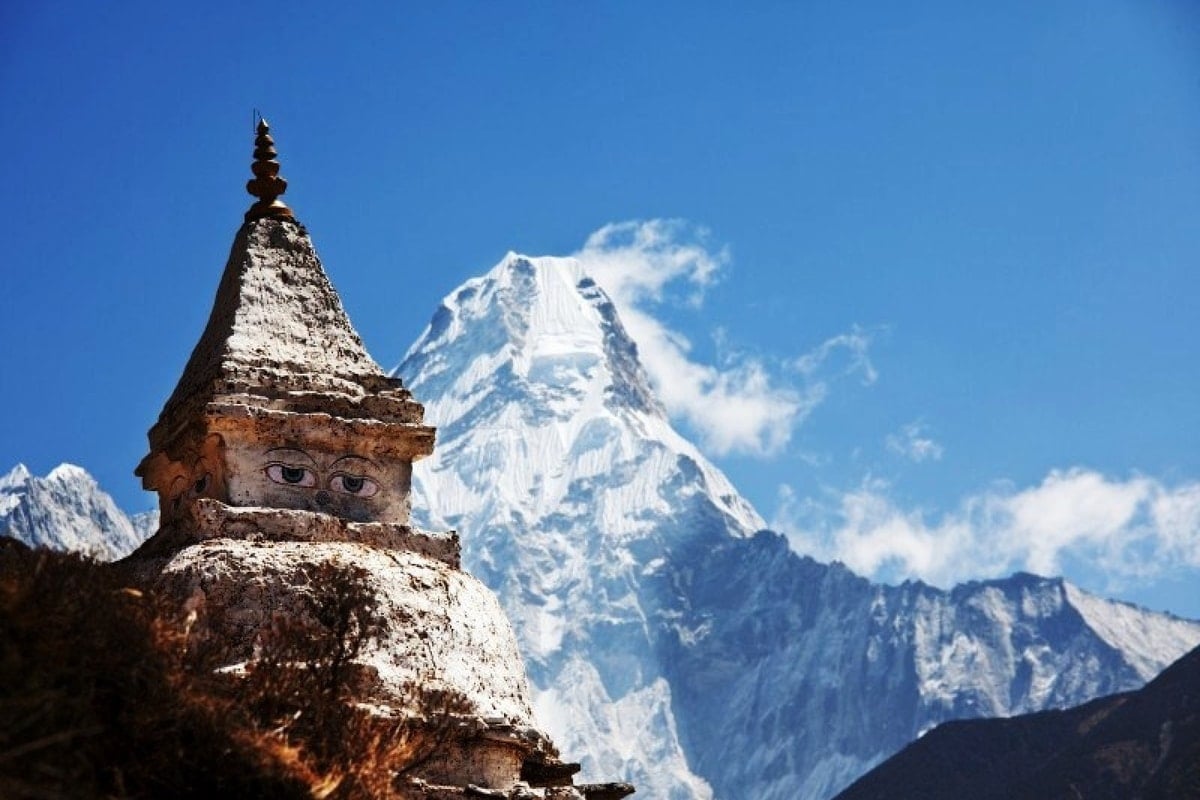
E-mail: [email protected]
Write us to on WhatsApp: + 977-9851060947
Recent Blog
- Everest Base Camp Hike: A Detailed Guide to Tips and Preparation
- Mount Everest Base Camp
- 17 Best Things to Do in Kathmandu, According to Local Experts
- Nepal-Tourism-Discovering-the-Beauty-Culture-and-Adventure-of-the-Himalayas
- Where is Mount Everest Located?
Blog Categories
- Nepal Travel advice & Safety (48)
- Peak Climbing & Expeditions in Nepal (3)
- Trekking Nepal: Safety Tips and Trek Recommendations (12)
- Everest base camp trek blog (22)
- Annapurna Trek Guide & Tips (4)
- Family adventure Holidays (1)
- Trek safety and Advice (1)
- Sherpa & Everest (3)
- Namche Bazaar informations (1)
- Best Treks in Nepal (5)
- Best Company for Nepal trekking (1)
- Nepal Trekking preparation (1)
- Adventure in Nepal (1)

We Are Associated With
Recommended By
Subscribe for Newsletter
Sign up for our newsletter and dont loose your chance to win a free Everest Trek. Get alerts on amazing travels deals and latest news.
Follow us on:
Copyright © 1992-2024. All Rights Reserved. Mountain Sherpa Trekking and Expeditions Pvt. Ltd.
- (+977) 9841936940
- [email protected]

- Guide Required for Solo Treks in Nepal: Trekking Rule Change, Safety First, Solo Trekkers
But Why Is a Guide Required for Solo Treks in Nepal?
Was guide actually necessary, what can solo trekkers do now, how to hire a trekking guide in nepal, enquiry form.
The Nepal Tourism Board (NTB) has recently announced the guide required for solo treks in Nepal throughout the entire country from April 1st, 2023. This is done in an effort to ensure the safety and security of all travelers in Nepal, and to minimize the chance of any accidents or emergencies.
For solo trekkers, the rule change means that they must be accompanied by a certified guide or a group of at least two other people while trekking in Nepal. This rule applies to all trekkers, regardless of their experience level. It is important to note that the rule does not apply to trekkers who are accompanied by a guide from a licensed tour operator and are not traveling alone.
At the same time, it is important to note that the new rule does not impact the general safety of trekkers. Nepal is still a safe country for trekking, and the rule change is simply an effort to ensure that all trekkers are adequately prepared for their trips into the remote areas of the country.

Furthermore, the Department of Tourism has also implemented several initiatives aimed at ensuring trekkers’ safety in addition to the new rule. Additionally, these initiatives include providing detailed information on the region’s weather and terrain; providing maps, guidebooks, and other materials to help trekkers prepare for their journey; and providing access to emergency response teams in the event of an accident.
The new rules will apply to all trekking areas in the country, including the Annapurna Circuit, the Everest Base Camp trek, and the Langtang Valley trek. All trekkers must be accompanied by a government-licensed guide, or joined by a Tour Operator.
Read: Guide Hire in Nepal: Overview Of Hiring Porter in Nepal
This order comes in the wake of a series of unfortunate events that occurred in the last few years, in which solo trekkers were either injured, lost, or even died in some cases. The Nepalese government believes that by restricting solo trekking, they will greatly reduce the risk of trekkers getting into trouble.
The Director of the Nepal Tourism Board, Mani R. Lamichhane, points out: “When you are traveling solo, in case of emergencies there is no one to help you. It is fine if they are traveling in the cities, but in the remote mountains, the infrastructure is not adequate. When tourists go missing or they are found dead, even the government cannot track them because they have taken remote routes.”
The safety of travelers has always been a priority for Nepal, and this ban is a direct reflection of that commitment. While the move may be disappointing for many solo travelers, it is a necessary step to ensure that everyone is safe during their time in Nepal.
The decision to ban solo trekking in Nepal has stirred up some controversy, with some arguing that it restricts the freedom of travelers and others stating that it is a necessary precaution. However, after careful consideration, it is clear that the ban is indeed necessary. Here’s why:
- As a starting point, mountain trekking in Nepal can be highly unpredictable and dangerous, especially if you are not experienced. Without proper guidance, solo trekking can be extremely dangerous and trekkers may find themselves in dangerous situations that could lead to injury or even death. In fact, the number of accidents and deaths among solo trekkers has increased in recent years, making it clear that a policy change was needed to ensure the safety of travelers.
- In addition to this, the ecology of the region can be damaged if trekkers don’t adhere to the regulations. With more tourists flocking to the region, the fragile ecosystem can be put under a lot of stress. This can lead to the destruction of local flora and fauna. To protect the region, the government has implemented a ban on solo trekking.
- Finally, the terrain of remote regions doesn’t have many medical facilities along the route. The Himalayas are unforgiving and treacherous. One wrong move can lead to a fatal disaster. With no one to help, a solo trekker can be stranded for days until help arrives. The lack of medical facilities along the route further increases the risk for solo trekkers.
Therefore, the ban on solo trekking in Nepal is absolutely necessary. While it may be a disappointment for those who wanted to experience the region on their own, the ban is in place to ensure the safety of trekkers and the preservation of the region.
In order to avoid unnecessary danger, it is recommended that trekkers in Nepal travel in groups and with licensed guides.
Read: I am thinking of traveling trekking in Nepal how?
Although solo trekking may be banned in Nepal, it does not mean that you cannot experience the country’s stunning beauty and majestic mountains, only that you may not be able to experience them alone. There are still many ways to discover the Majestic Himalayas of Nepal by joining a trekking group or taking part in an organized tour with us.
That being said, solo trekkers are still welcome in Nepal. While the ban may be inconvenient for some, it is important to remember that trekking in Nepal is still an incredibly rewarding activity that can be enjoyed by all.
For trekkers looking to explore Nepal, there are still plenty of options available. There are plenty of well-marked trails throughout the country, with maps and signposts along the way. Additionally, trekking in small groups with an experienced guide is an excellent way to make the most of your journey.
Hiring an experienced guide and porters in Nepal is an important step for any traveler. While it may be tempting to attempt a solo trek, the Nepalese mountains are treacherous and can easily become dangerous if you do not know the trails of the land. A guide is vital for navigating the trails and identifying potential hazards.
At Info Nepal Tours and Travels, we specialize in providing experienced and certified trekking guides to accompany our guests on their chosen trekking trails. All of our guides are certified by the Nepal Government and have years of experience in navigating the treacherous Nepalese mountains. We offer guide and porter hire services in the following regions:
The trekking experience we offer is tailored to the individual needs of our clients. Our company can arrange treks of any length and difficulty, and we can provide all necessary equipment and supplies.
We have the knowledge and experience to make sure that our clients get the most out of their trekking experience in Nepal. We offer a wide range of activities, from sightseeing to hiking and even fun outdoor activities. So don’t hesitate to get in touch with us if you’re looking for a reliable and experienced guide for your trek.

Associated With

Himalayas on Foot
Local Trekking Company in Nepal
How to Trek Solo in Nepal

Ever wondered how would it feel while trekking alone in Nepal? In this article today, we are going to discuss how to trek solo in Nepal.
Nepal is visited more often for trekking. Trekking in the lap of the Himalayas is the biggest achievement one can have in life.
There are different popular trek trails in Nepal including the highest peak of the world Mount Everest. Many free individual trekkers and trekkers from agencies trek around Nepal every year.
Solo Trekking In Nepal:

There are various agencies in Nepal that help you through your trekking and city tours in Nepal. However, free trekkers are still found in large numbers every year. Any tourist who wants to trek freely without taking a professional guide with them can trek on their own. Once in 2012/2013, there was a talk about prohibiting solo trekkers in Nepal by the Nepal government because of security issues.
But, now there is not any that kind of issues and you can trek the route of your choice legally. Solo trekking is not a new topic regarding the trek trails of Nepal . You would meet many free individual trekkers on your way during the trek. Not only trekking but city tours or jungle safari also can be done freely. The main point is you should have detailed information on what you are doing on which day and you should have overall knowledge regarding your itinerary.
- Contact Number *
- Your Message *
- Please press 5 to submit *
Legal Permission:
Nepal Tourism Board has the system of issuing TIMS (trekker’s information management system) for every individual trekker. Either the trekker is going through an agency or is a Free individual trekker, he/she must have TIM’S issued before starting the trek.
You can issue your TIMS card from Kathmandu. Since you are a FIT the TIMS card you use is green. Other trekkers use blue TIMS card. NTB charges a higher amount in the TIMS card of free individual trekker.
The next one is the Permit. There are many places in Nepal which are forbidden. The government of Nepal has restricted those places without special permission. That special permission is ‘permit’. You need to have permit cards to travel in restricted areas of Nepal. The rule is at least there should be two individuals for trekking in restricted areas. For entering the national parks and wildlife conservation areas, you should have a permit too.
Solo Trekking As a Female:

It is hardly heard Nepal is not safe for a solo female trekker. Every year, there are various solo trekkers and many of them are female. Just because you are a female, your trekking would not be unfair. Still, the recommendation will be to get a guide or just a friend to trek with.
Trekking means normally going towards the rough road of high altitude and you never know where and what is going to be wrong with your health. Having a friend beside can be fun. You can talk during your walk. Trekking solo as a female is not insecure but trekking with a partner can be better.
Less Expense:
Once you read this you would not want to take a tourist guide or a porter with you. Trekking alone, you can save a lot in Nepal. Nepal is not an expensive country. The fewer estimation of your budget will run throughout your trek.
If you trek alone, You will be paying only for TIMS, permit, and your food and accommodation. When you trek with the agency or when you take a personal guide or porter, you expense doubles. Paying for the hotels and tea houses during your trek and paying for the food and accommodation of your guide is included in your bills. Trekking alone can help you save a lot of money.
Though you have less expensive when you travel all alone, a guide is highly recommended. The trek trails are very rocky and rough. You would not have the internet there. You have a high chance of forgetting your way to the top or either back to the city.
There would be rarely any kind of sign in your way. The guides in Nepal have a lot of work experience. They can guide you even if the weather is very poor. For the first time trekkers, the trail is going to be harsh and confusing. If you have already trekked once in the same trek trail, you may be able to trek it next time.
However, the scariest part of solo traveling is there have been many incidents with solo trekkers in the past. They forgot the route, they got lost and some of them were found to be dead long after.
These have not happened frequently but they have happened for sure. You have a high chance of forgetting your trek trail as they all look similar and you have no good internet there. According to your safety, You should have a professional trekking guide with you.
Fun in Nature:
Trekking is an interesting term itself. When you trek towards the mountains it is way more fun. And, when you are alone, in nature nothing can beat that happiness. Life these days has been very busy. Nobody is free. Work, pressure family and all make a human tired.
When you forget about all of them and take short leisure in nature, you definitely feel relaxed. Hiking alone through the rocky and rough trek trails and ascending up to the altitude towards the mountains gives heavenly feelings.
Slowly and noticing every aspect of nature you can ascent towards your destination. If you have good knowledge about your trials and itinerary and if you are well prepared for altitude, nothing in the whole world can give an as good feeling as trek gives.
Equipment and Gears:

If you are a free individual trekker, you should be very careful about your gear and equipment . Do not forget you will have nobody with you to ask for help with. Gears and equipment can be bought or can be rent in Kathmandu and Pokhara.
You should not carry them all along from your country only because you are trekking in Nepal. You should be careful with the selection of your gears. The point to be noted is you must have all the important gears and equipment you need without making your backpack heavy.
DO not forget you will be trekking all alone and you would have nobody to help with your luggage. You can get equipment and gears at a reasonable price in Nepal of reasonable quality.
FIT should be very careful regarding your clothing. Make sure you are carrying every piece of cloth you need. The next thing is you should have a comfortable boot. You must carry all the perfect clothes without making your luggage heavy. Since in case you get tired or you want help there will be no one else.
Seasons for the trek:

In the meantime of September and October , you will find many trekkers in your route. You have a high chance of finding other free individual trekkers who can be your companion. These seasons are autumn in Nepal. It is neither hot nor cold. The monsoon would have just come to the end in these months.
This is the best time for trekking that’s why. If you trek in December or January there will be freezing cold in mountains. If you trek through June or July there will be monsoon this time. The weather may be completely bad and you have a high chance of forgetting the route. Also, you will have less chance of finding other trekkers in your way.
Regions for Trek:
You should have detailed knowledge and information in your trekking region. It includes the weather of the region, people, food, and culture. It will help you a lot during your trek. The region you want to trek also matters if it is going to be safe for you.
Some trekking trails are at high altitudes above 5000 meters. These are the altitudes beyond a human can handle. In those areas, you will have high chances of having altitude sickness or any other sorts of problems.
The weather there is acute cold and if it happens to be in the winter season, you will freeze. There are some other trekking routes of around 3000m. They may be way easier to trek. If you are going alone, you can choose these kinds of trekking routes which are going to be easier for free individual trekkers.
Personal Experience:
Every year lots of free individual trekkers trek around the altitudes and trekking routes of Nepal. They return back with good memories. This also depends on your personal experience. If you have been to that trekking point through that trekking trail earlier, it would not be very difficult for you. At least, you can go alone next time.
Since you have already hiked the altitude before, you will have a good idea of ascending, food, culture, and weather of the place. The proper schedule is also a vital thing for FIT. For the trekkers of the agency, they manage the schedule. But, if you are the one to trek freely you should be very careful regarding your trekking days, acclimatization, and trekking hours. This will help you to prevent altitude sickness.
However, FIT is not new in terms of Nepal. If you have a proper schedule, proper knowledge of the trekking route you are physically and mentally fit and you have the guts to trek freely to the highest peaks of the world you will surely make it. Still, having a well-experienced guide is a better option.
In conclusion, the above-mentioned guidelines will help you to know how to trek solo in Nepal.
You may also like...

10 Day Trek in Nepal

Nepal Weather November Trekking

Trekking in Nepal in February
All you need to know about Nepal’s new solo-trekking ban
Mar 14, 2023 • 4 min read
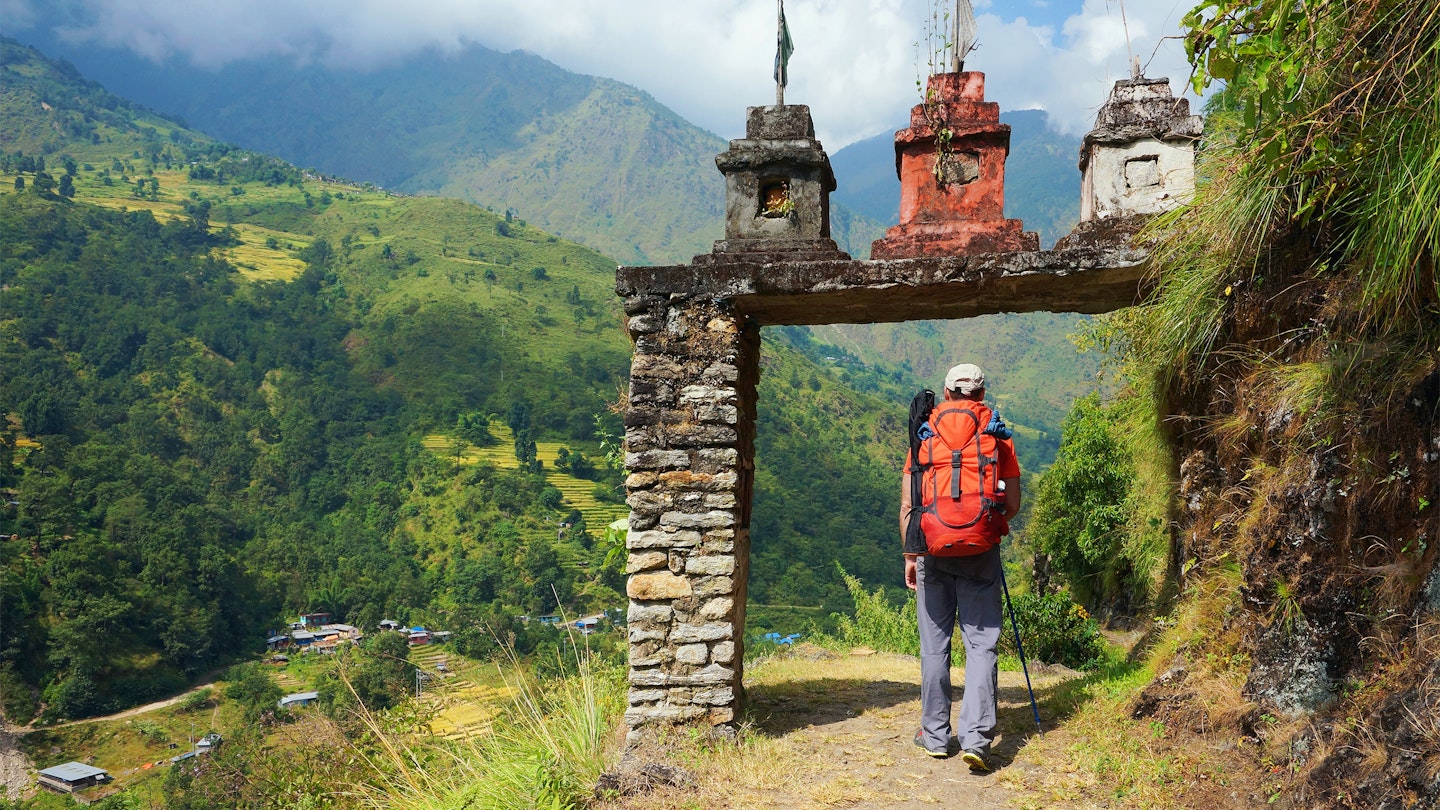
To encourage safety and employment in the tourism sector, Nepal will soon require all trekkers in national parks to have licensed guides © MOROZ NATALIYA / Shutterstock
From April 1, solo trekking will no longer be allowed in Nepal ’s national parks and conservation areas .
The Nepal Tourism Board, the body responsible for promoting the country’s tourism, announced the decision on March 3. According to the board, the decision was taken after consulting with the country’s various tourism stakeholders.
“The two main objectives behind the ban [are] to make trekking in Nepal safer and to create more employment opportunities in the country,” says board director Mani R Lamichhane.
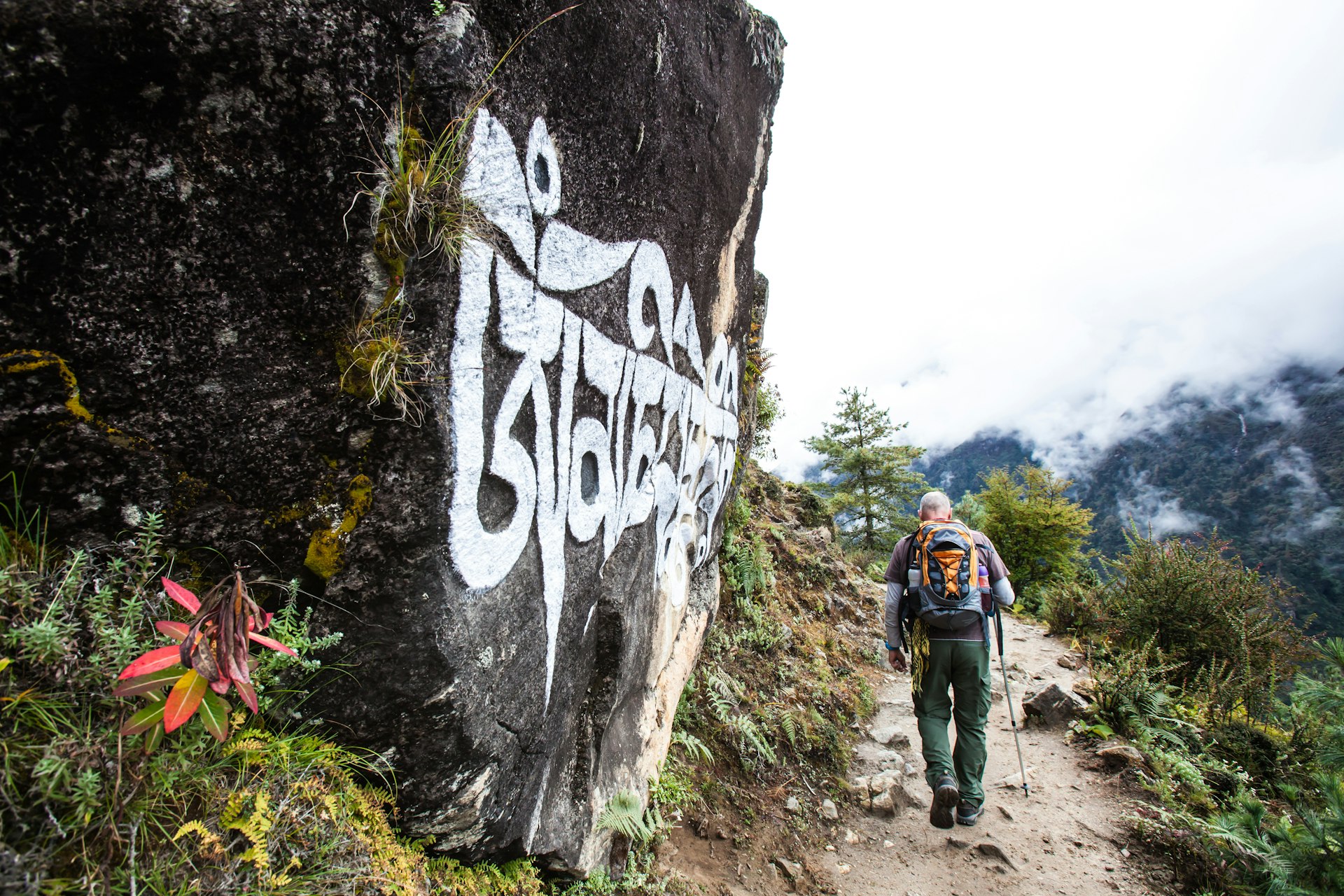
A question of safety
According to board-provided data, in fiscal year 2019–20, 390 tourists were reported lost or missing; in the following fiscal year, the number was 54 (nearly all are eventually rescued or found). “In both the years, the majority of tourists who were reported lost/missing were those trekking without guides, basically solo and ‘free independent travelers’ [FIT],” adds Lamichhane. “Even if you look at the data from years before 2019–20, you will see the same trend.”
The umbrella organization Trekking Agencies’ Association of Nepal has been pushing for the ban on solo trekking since as early as 2009, says Nilhari Bastola, the organization’s president.
“Every year we see two to four cases of solo trekkers getting involved in deadly incidents,” says Bastola. “Our data shows that having a trained trekking guide goes a long way in ensuring that trekkers remain safe and avert possible dangers.”
Licensed guides, says Bastola, are well aware of the topography of trekking trails and the possible risk factors in various routes.
Many of Nepal’s popular trekking trails are in remote destinations where human settlements are sparse and cellular connectivity unreliable. And in the country’s remote mountainous trails, sudden weather changes and such natural disasters as landslides occur frequently, posing immense risks to solo trekkers unfamiliar with the region’s conditions.
“When trekkers go missing in remote trails, it becomes immensely challenging for authorities to conduct search-and-rescue operations,” says Lamichhane.
Trekkers getting involved in fatal incidents every year had also created a misperception of Nepal as an unsafe trekking destination, agree Lamichhane and Bastola.
“This misperception is impacting our country’s tourism sector, and we are confident that the new rule will help lower the number of such unfortunate incidents,” says Lamichhane.
A boost to the local economy
Another motivation for the new move? Jobs.
“Out of the 171,000 trekkers that Nepal saw in the fiscal year 2019–20, around 46,000 were solo trekkers. Imagine the number of Nepalis who would have gotten jobs had it been mandatory for trekkers to hire guides,” says Lamichhane. “By hiring licensed guides, trekkers will also be creating more job opportunities in Nepal and thus doing their part in being responsible travelers.”
A lack of jobs for trekking guides has been an issue in Nepal’s tourism sector for years. Every year, dozens of Nepalis graduate with trekking-guide licenses, yet many of them do not end up working, says Dawa Tseten Gurung, the managing director of Himalayan Wander Walkers , a Kathmandu-based trekking expedition company. “The new decision will bring more jobs only if the concerned authorities put in place a robust mechanism to ensure that the new rule is implemented.” Gurung’s company boasts a roster of seven trekking guides.

How to hire a trekking guide in Nepal
The Nepal Tourism Board has made it clear that solo and FIT trekkers will have to hire guides through government-authorized trekking agencies. Trekkers are free to choose the trekking expedition outfitter of their choice.
Since there are many unauthorized trekking companies offering services, Lamichhane advises visitors to do their homework, and make sure the outfitter they are dealing with has a license to operate legally in Nepal. The Nepal Tourism Board is also working on a database that will have a list of all registered trekking companies in the country.
To accompany you on your trek, you can expect to pay a minimum of around $17 per guide per day. The price goes up based on the guide’s (or guides’) experience and the difficulty level of the trekking route.
Places where trekkers can still go solo, for now
Since the new rule bars solo trekking in national parks and conservation areas, many of Nepal’s most popular trekking routes are now off-limits for lone explorers. Yet there are still plenty of trails where one can hike solo.
A route that has become increasingly popular in the last few year, the Pikey Peak trek in the lower Solukhumbu region offers scenic mountain views – including of Everest – and can be completed in under seven days.
The five-day Ama Yangri trek in the picturesque Helambu region via Melamchi is another great option. In the same district of Sindhupalchok is the remote Panch Pokhari (which translates to “five lakes”). This trek can take anywhere between eight to 10 days.
Closer to Kathmandu is the Champadevi hike via Chandragiri. “It’s a moderately challenging one-day hike and takes hikers past lush green forest with scenic views of Kathmandu Valley,” says Gurung.
There’s also the option of a three-day Balthali trek via Nagarkot (an hour drive from Kathmandu), with overnight stops at Dhulikhel and Balthali.
Explore related stories
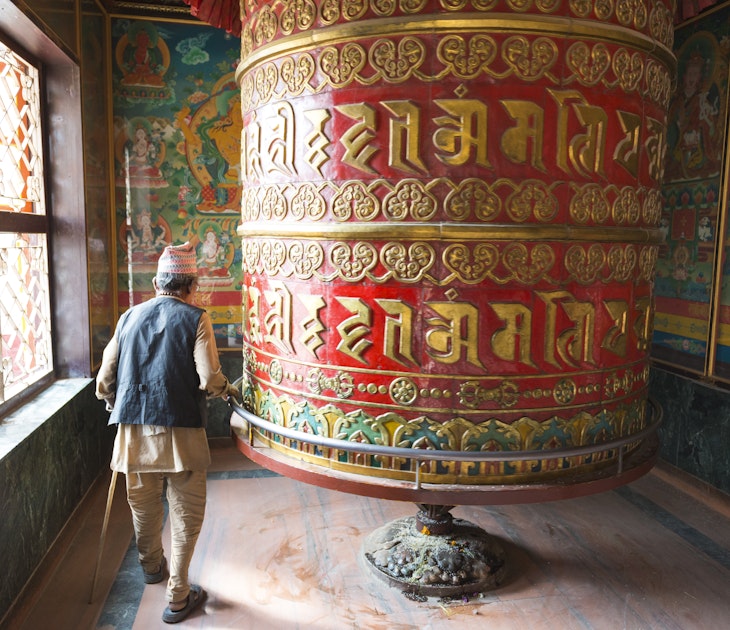
Jan 9, 2022 • 8 min read
Nepal is the destination with everything: towering Himalayan peaks, wild jungles, sacred sites and epic trekking routes. Here are the best places to visit.
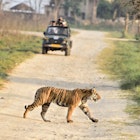
Apr 16, 2024 • 13 min read
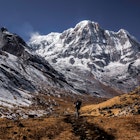
Feb 22, 2024 • 3 min read
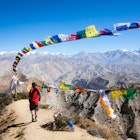
Dec 23, 2023 • 7 min read

Sep 24, 2023 • 7 min read
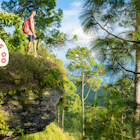
Sep 18, 2023 • 7 min read
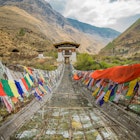
Aug 31, 2023 • 11 min read
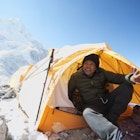
Jun 20, 2023 • 10 min read
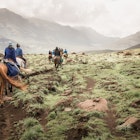
Dec 26, 2022 • 14 min read

Jul 13, 2022 • 8 min read

Top 5 Popular solo trek in Nepal
Solo treks in Nepal are one of the most fulfilling things to do, but it has its own share of risks. Here is the list of top trekking destinations if you are planning for a solo trek in Nepal . These locations are usually safer, have more hotels, and more travelers on the way, and the chances of rescue are better in case of any emergency.
Top 5 Destinations for Solo Trek In Nepal:
- Annapurna Base Camp
Mardi Himal
Khumai danda, annapurna base camp.
Annapurna Base Camp (ABC) is one of the most popular trekking destinations in Nepal. It offers a beautiful view of Annapurna Mountain along with the view of Machhapuchre on the way. It’s a 7 to 9-day trek starting from Kathmandu valley based on our travel speed and vehicle availability.
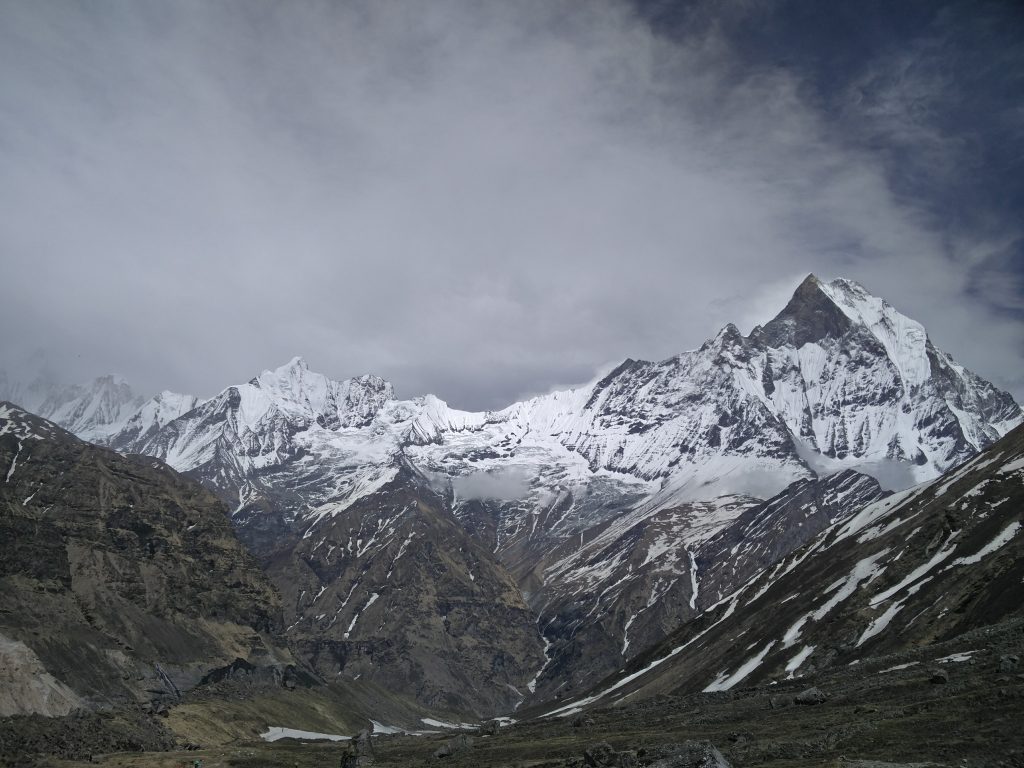
Reaching base camp can be one of the most fulfilling experiences that you can get. You will see an almost 360-degree mountain view from the base camp. The total cost of the trip would be somewhere around Rs. 30,000 to Rs. 35,000.

Khumai Danda trek is one of the shortest treks in Nepal and that’s why it is also the best destination for those planning for a solo trek in Nepal.

Poon hill is one of the most popular destinations for a solo trek in Nepal . Poon Hill itself offers a variety of experiences that we can get in trekking and also a gateway towards other trekking routes like Annapurna Base Camp. You can reach Poon hill from Pokhara easily in one and a half days. You can experience almost 360-degree mountain views there.
Hotels at Poon hill are pretty good as there is a good flow of tourists. As a solo traveler, you will also meet a lot of other travelers who are going to Poon hill or are passing from Poon hill for other treks. This way will always have people and is one of the safest treks for a solo trek in Nepal . Relatively, this is also the most affordable trek destination in Nepal.
Gosai Kunda
It’s a 5-day trek that people go for religious as well as sightseeing only. This place has great religious value too, so it would be heavily crowded if you go during Janai Purnima time. The lake is somehow surrounded by some mountains and there are other multiple lakes nearby too. This is best for the solo trek in Nepal as you will find many hotels and teahouses on the way along with fellow travelers here and there.

You will have to go to Dhunche from Kathmandu which is a 6-hour drive. After that, you will have to walk for around 2 days to reach Gosaikunda and 1 and a half days to be back at Dhunche.

The lake looks gorgeous when it’s frozen too, and many people these days even take helicopter tours to the lake and spend there 30 minutes for a photoshoot or breakfast. A frozen lake has its beauty, while in a regular lake, you can take a bath and see the beauty of the water too. The choice is yours if you have 5 days to spend.
When you are traveling solo, you need to be careful about your safety and health. It’s not like traveling in a group, and even a small mistake can be a life-threatening one when there is no help nearby. You should be mindful of the weather, your packing, hotel booking, walking boots and wearables, headlamps, etc, and more.
There are risks associated with this, but if you plan well, you can experience one of the most adventurous, and fulfilling experiences of your life. Please let us know if you have already done some solo treks in Nepal and share your experience that will help fellow travelers.
Leave a Comment Cancel Reply
Your email address will not be published. Required fields are marked *
Save my name, email, and website in this browser for the next time I comment.
Start typing and press enter to search

Thinking of solo travel in Nepal? Nepal is a popular destination for solo travelers. On this blog, you will find everything you need to know before you visit Nepal.
The complete guide to solo travel in Nepal
Welcome to Nepal - the country where eight of the ten highest mountain peaks in the world are located, including the summit of Mount Everest, the highest mountain in the world.
Nepal, the gateway to the Himalayas and one of the most beautiful countries in South Asia, is stunning in its beauty and is considered by travelers as one of the most spectacular places on earth.
Nepal is a stunning combination of jungles, rice fields, temples and deserts, rich culture, and the highest mountain ranges in the entire world.
Nepal is without a doubt - a paradise for travelers.
I arrived in Nepal at the end of September, the peak of the tourist season, the best time to go out into the mountains and conquer Nepal by foot.
I visited Nepal for 6 weeks and got to experience this wonderful country in a good way that left me with a taste of more.

Table of content
Is it safe to travel alone in nepal, when to visit nepal, how to get from kathmandu airport to thamel.
- Where to stay in Kathmandu?
How to get around in Nepal?
- things to do when traveling alone in Nepal
Trip to Nepal: How to plan?
How to find partners when traveling alone in nepal, travel insurance to nepal, responsible tourism in nepal.
- Useful sites & apps for a solo trip to Nepal
- Final thoughts
I found Nepal as a country that is very safe to travel alone.
The crime rate is low. The people are kind and always smiling.
I would say that the Nepalis are the most smiling and nicest people in East Asia.
Of course, as with any trip, one should pay attention to the cases.
Like other Third World countries, there are cases of theft in Nepal.
It's not common, but be careful and cautious.
Be careful not to leave valuables in your guesthouse when you are away.
Overall the feeling in Nepal is very comfortable and safe for anyone traveling alone. Most of the Nepalis you will meet along the way are kind and charming people, most of them speak pretty good English, so it is easy to communicate with them and get help from them.

When asked "when to visit Nepal?" one usually means to ask "when is the best time to trek in Nepal?" because this is the most common tourist activity in the country.
There are two good times of the year for a trip to Nepal that includes trekking:
The main seasons occurs between mid-September and late November .
This season there is excellent visibility and favorable weather for trekking, when at the beginning of the season, it may still rain (end of the monsoon season), and at the end of the season, it gets colder.
The secondary season occurs between mid-March and late May .
This season the visibility is less good, but the weather is favorable for trekking.
The beginning of the season is cold, and there may be snow at the high mountain passes.
Towards the end of the season, it rains more, and the visibility gets worse.
It is important to note that in recent years the season has been delayed - if we used to talk about March-April, today we already talk more about April-May, and sometimes even the beginning of June.

Kathmandu Airport is 5.5 km east of Kathmandu.
Getting from the airport to the city center by taxi takes about 20-30 minutes depending on the traffic.
The Pre Paid Taxi service will be on your left as soon as you leave the arrivals gate, the prices there are fixed in advance.
A prepaid taxi at the airport costs about 750 Nepalese rupees.
You can get out of the airport, catch a local taxi on the street and easily get a taxi for 400-500 rupees to Thamel.
Once you have collected your backpacks and left the terminal, dozens of Nepalis will be waiting for you with signs and binders of all kinds of hostels and hotels. They will offer you a free taxi if you come to the hotel.
Sometimes these are good hotels, but often the hotels are in remote parts of the Thamel, and every time you want to go to the Thamel center (where everything happens), you will have to walk 10-20 minutes or take a rickshaw each time, and it is a waste of money.
Do not hop on the first taxi that arrives, until you have finished crossing the road, you will already hear lower prices, and of course, do not be afraid to bargain.

Accommodation in Nepal: Where to stay in Kathmandu?
The best area to stay is in Thamel, the main street that houses all the tourists who come to Nepal.
In Thamel, you will have everything, guesthouses, restaurants, travel agencies, and trucking equipment stores.
4 best places to stay in Nepal for solo traveler
Elbrus Home - Great hostel! 5 minutes walk from Thamel center.
Nice atmosphere, Spacious rooms, and cute garden area.
Definitely, one of the best places to stay in Kathmandu.
Flock Hostel Kathmandu - The hostel is clean and has a cozy dorm, with many showers with hot water.
The beautiful common room and the restaurant offer great food.
Rest Up Kathmandu Hostel - Convenient and relatively cheap place, cozy, good location close to many places in Thamel, and a quiet and pleasant atmosphere.
Hotel Jampa - It's not a hostel and has no dorm rooms, but if you are looking for relaxation and privacy it's a perfect hotel.
The hotel is located in the center of Thamel, but in a quiet alley, which makes all the difference.
The hotel has Strong Wi-Fi and is close enough to any point in Thamel.
Where do you stay during the treks in Nepal?
Most treks in Nepal offer quite comfortable accommodation along the way.
On some treks, you will stay in tea houses, where you can stay in modest rooms with a bucket shower (A funny experience) or shared toilets and showers.
There are guesthouses, which offer more comfortable conditions, and sometimes, also a restaurant that serves food west.
On other treks, accommodation is in family homes in the local villages, and this is a great opportunity to get to know the local life.

When talking about transportation in Nepal, it is important to talk about the roads.
Most of the roads in Nepal are unpaved, and most of Nepal is not connected by roads.
Many villages in the country are connected by footpaths only, and when there is a road, it is usually a dirt road.
In Nepal, you can get around in several ways:
Rickshaws are a very standard way to get around nearby places in Kathmandu.
Usually, the trip is an experience - in the open air, with all the noises and smells around.
Do not forget to bargain for the price of the trip!

The most common form of transportation on roads (dirt roads) is trekking. The jeeps usually leave from a fixed point in the village and leave when his full. Get ready for a particularly bouncy ride.
Bus for tourists
Buses run between Kathmandu and Pokhara, Lumbini, and Chitwan.
You can order tickets on the 12go Asia website, the best website for booking transportation in Asia!
The taxis in Kathmandu and Pokhara are small and clumsy but traveling. Probably more expensive than a bicycle rickshaw, but relevant to longer journeys, and probably also faster.
Locals are regular buses with local passengers, hence the name.
On the local bus, the seats are less comfortable, they are not air-conditioned, the places are not marked, and at certain times can be crowded.
On the other hand, there is no need to book tickets in advance, the frequency can be high, and they are very cheap.
Traveling locally will give you the full Nepali experience - you can talk to people and experience the road directly, a bit like a rickshaw.
The ride on a local bus is tough, but provides a rare experience and glimpse into the daily lives of the Nepalese.

Best things to do when traveling alone in Nepal
Trekking in nepal.
The main reason hikers come to Nepal is the impressive treks and ridges. Whether your stay is long or short, do not give up on the experience.
It is important to choose a reputable travel agency, take a guide, and even a porter to help carry the equipment so you can enjoy the route.
Most popular treks in Nepal:
Everest base camp.
Duration of the trek: 12-18 days
Experienced hikers will be able to enjoy a trek that reaches as far as the base camp at the foot of the mountain.
A more challenging route of the trek includes the Kala Patthar and crossing the tracks between 5,360 m and 5,550 m.
The route is a kind of collection of observation points on the various ridges, the most prominent of which is Mount Everest.
Annapurna circuit
Duration of the trek: 10-14 days
The trek revolves around the Annapurna ridge area which is part of the Himalayan mountain range. The circumferential route and the heights in it vary and so do the diverse landscapes you will encounter along the way.
The trek is defined as a light-medium level and includes a 5,416 m high strip.
Annapurna Base Camp
Duration of the trek: 8 days
During the trek you will pass the heart of the Annapurna Reserve and reach a peak of 4,000 m. The view that will accompany you on the way will be the mountains that the best climbers in the world try to conquer every year.
The Langtang Trek and the Frozen Lakes
Duration of the trek: 7-14 days
You can perform the trek in combination or choose one of the routes.
The Langtang Valley is mostly identified as a glacial valley where the landscape alternates several times from green to the route of snowy mountainous terrain.
You can combine a trip with a visit to the frozen lakes located at an altitude of 4,000 m, a spectacular view when the water of the lakes turns to ice, especially in the winter months.
how to choose which one?
The various treks have different degrees of difficulty and comfort and last several days to several weeks.
Everyone will be able to find a trek that suits his physical ability, the time he has left, and his pocket.
All popular treks have a lively movement of people, and you will get to know travel partners easier.
Although these are touristy treks, they do not detract from the charm of trekking in Nepal and the impressive Himalayan ridge.
For those who travel alone in Nepal, especially for the first time, and intend to go on a trek alone, it is worthwhile to go on one of the most visited and famous treks I have mentioned here.
On these treks, You will surely get to know people and gain tremendous shared experiences.

try adrenaline activities
Nepal is best known for the quality rafting it offers to many travelers. Streams of varying difficulty and hikes start from several hours and last several days.
You will not have to worry about equipment, everything is included through the various travel agencies in Pokhara and Kathmandu.
Apart from rafting, you will find in the Kathmandu Valley a bungee jumping site alongside the possibility to learn to kayak on the Bhote Kosi River or paragliding in the Pokhara area.

visit nature reserves
Apart from the nature reserves in the mountainous area of Nepal, you will find two interesting reserves located in the south of the country, in the flat Trai area.
The Radiyya Nature Reserve and the Chitwan Nature Reserve offer an introduction to wildlife such as elephants, tigers, rhinos, birds, and more. They can be reached through an organized trip from one of the agencies in the cities or independently.

Volunteering
Nepal is a third-world country, one of the poorest in the world.
Western tourism that comes to it helps the local economy, but the best help comes from the actions of tourists who join the various organizations in the country and volunteer to give their time and energy for the benefit of the weak population.
Do some shopping
You can buy everything here cheaply.
In addition to a variety of handicrafts and handicrafts, you will find climbing and trekking equipment, cameras, spices, clothes, and more in Nepal.

For travelers whose time is limited and limited, it is advisable to know in advance which trek they want to do.
Some go trekking independently, and some choose to take a guide or porter who knows the way.
Porter is a local whose main job is to carry the equipment for you (it is important not to overload it too much).
The porter is well versed in the route and will help you find good places for accommodation and food.
Sometimes the porter will take you to a place you may not like, for the reason that he gets free meals there or that his friends are there.
The porter must be attentive to your needs.

Did you come to Nepal alone? Did you go out with partners, and things did not work out? Don't worry.
Nepal is a friendly country for travelers alone, women and men alike.
The Thamel in Kathmandu and Lakeside in Pokhara, are packed with travelers all day long. Including countless restaurants and inviting travel agencies, where you can leave a sign (many do this), and even while wandering or shopping you may meet your next partner.
Did this happen, and you did not find a partner?
Do not be afraid to go out alone with Porter - on the trek you will meet lots of travelers!
Whether during the walk or at your accommodation that day, you will stay in small villages where most hikers sleep in the same places, and it is impossible not to know people.
If you go on a trek around Annapurna, after 2-3 days, you will already know all the hikers who started the trek in your time.

As mentioned, I traveled to Nepal alone and met lovely people already on the first day of the trek.
I left Kathmandu for the Annapurna circuit trek alone, and I was a little apprehensive at first if I met people, and it was easier than I thought.
Already on the jeep from Kathmandu to the village where the trek begins, I met amazing people who had a quick connection between us, and we went the whole trek together, and we stayed together for the rest of my trip in Nepal.
Beyond that, even on the trek itself, I met a lot of people each day, and for a moment, I did not feel alone.
Of course, I'm talking about touristy treks like the Annapurna circuit trek or the Everest Base Camp trek, that many hikers from all over the world come to do.
So do not be afraid to visit Nepal alone, you will never feel alone, and you will have the opportunity to meet enough people along the way and make new friendships.

* It is important to emphasize
You need to have a TIMS card and a national park/conservation area permit to enter and trek in these areas. But all parts of these regions are not safe.
The more frequent trekking routes are advisable to trek alone but I recommend you not to trek alone in Nepal.
Nepal is not like Europe or other places in the world where you can easily go trekking alone without any worries.
When trekking in Nepal, you need to make sure that there will always be people around you, even if you do not know each other, they can help you if something happens to you.
On popular treks, it is rare to be alone, but in any case, never try to cross a mountain pass when you are alone!
If life is important to you, be responsible enough, and stick with one group or someone else.
Of course, I traveled alone to Nepal, but I never had a day when I hiked alone in Nepal.
There were always people around me, whether it was the partners I met or other hikers in sight.
It is important not to underestimate this because no matter how much experience you have in trekking, trekking in Nepal is a completely different thing than what you are familiar with.

Local communication and local SIM card
It is easy to connect to WiFi in the accommodation and restaurants, and even on the touristy treks (Annapurna Circuit and Everest Base Camp), there is WiFi available.
Of course, in the mountains, the wifi will be slow and temporary, and sometimes even expensive.
It's very convenient to walk around with a local SIM.
Where to buy a local SIM in Nepal?
You can buy a SIM at the airport in Kathmandu - at the exit of the airport, there are stalls of the two Nepali cellular companies.
It's a little more expensive than buying in Thamel, but not significant.
There are two companies - NCell and NTC \ Namaste.
As long as you're not on the trek, it really does not matter.
In the Annapurna area, it is better to use NTC, and in the Everest area, it is better to use NCell.

How do you communicate on treks when there is no reception?
Satellite messenger device.
It is a device that allows sending a distress signal in case of emergency, and to send an 'everything is fine' message to the family.
Not everywhere on the trek, there is cellular reception, and there are places where you would like the opportunity to be in communication for your safety.
This is why more and more travelers today want to take a satellite device for their trip, especially if they are traveling alone.
Important to note!
* Do not go on a trek alone without a satellite device.
* Do not go on a trek alone without insurance that includes extreme locating and rescuing.
Even if you have maps, lots of experience, and have done a lot of research.
If you catch altitude sickness, lose your way, or fall - the satellite device can make the difference between life and death.
I'm not saying these things to scare you, but to be alert enough and understand what you're heading for.
I met enough people during the trek in Nepal who thought they were brave and could do anything, and they thought they could not get altitude sickness and eventually realized this the hard way.
Trek in Nepal is not a scary thing, and it is a fun and wonderful thing. But it is important to know all the possible scenarios and be prepared for them accordingly.

The Himalayas attract many adventurous hikers.
In addition to them, the flowing rivers are a sought-after, exciting rafting attraction.
This means that many visitors to Nepal will experience adventures that involve a certain risk.
It is important to choose an insurance policy that will cover the various activities in Nepal.
No one wants anything bad to happen to him during the trip. But if this happens, you should have health insurance and not be left helpless in a foreign country.
Travel insurance to Nepal must include challenging activities, locating, and rescuing.

The culture in Nepal is not similar to the Western world, therefore gestures and deeds that we think are simple and natural, are sometimes considered insulting and inappropriate by Nepalis.
For the most part, they will not say anything, but the locals will greatly appreciate and respect the travelers who will behave according to their culture.
Dress: Nepalis believe that in Nepal, you should dress like Nepalis. Short or bare clothes are not well received as well as intimate contact between a man and a woman.
Naked or shirtless walking is unacceptable.
You may notice men or women walking hand in hand or hugging members of the same sex, but this shows intimacy and not the sexual background.
Conversation: When meeting people, greet each other by saying Namaste which is accompanied by clasping hands on each other. This action blesses the person standing in front of you, and the Nepalis respect those who practice this way.
Behavior: Do not touch the head of another person (especially children), do not pass over someone sitting lower than you.
In receiving and giving objects or money, it is customary to use both hands or the right hand with the left palm resting on the right elbow.
Behavior in temples: Shoes should be removed and left at the entrance to temples.
When passing near or around a stupa, temple, or walls with prayer wheels, should be done clockwise.
Smoking is not allowed inside them, and a modest donation is welcome.
Photography: Ask permission before photographing people and holy places.
Respect the privacy at public ceremonies and events (especially cremation and bathing in the river).
Table manners: Eating around the Nepali table is done with the right hand. Mix the food, turn it into lumps using the five fingers, and inhale from the palm to the mouth.
Because the right hand is dirty from the food, the left hand is used to drink, add food, etc. However, in tourist restaurants, cutlery is served.

Useful sites and apps for a solo trip to Nepal:
12GoAsia - The best site to book tickets for public transport, buses, and trains in Nepal and Asia.
Booking.com - Comparison of hotels and accommodations
Hostel World - the best site for booking a hostel and dorms
Skyscanner - Compare prices of flights to Nepal at attractive prices
Xe currency - Currency conversion app
Maps.me - Navigation offline.
You can download the maps in advance to navigate offline, very useful.
You can use the App even on various treks!
Y.r - Weather. I use it all over the world.
Tripadvisor - recommendations for places to eat, accommodation, agencies, and more
Safety Wing - Travel insurance for Nepal
Final thoughts on a solo trip to Nepal
In my case, the decision to travel to Nepal has always been there.
I knew I wanted to get to this fascinating country and walk to the foot of the Himalayas.
Today after I have already visited Nepal alone, I can say that it is the best thing I have done.
I met amazing people in Nepal, had tremendous experiences, charming trekking partners, and got to know a fascinating and different culture from what I know.
As with any trip I take, when I go on a trip alone, I always know people from different places in the world, and ages, and that is what is beautiful about traveling alone, and Nepal is no different in this matter.
Now all you have left is to look for an attractive flight ticket, organize a bag, do not forget to take a camera of course and visit one of the most beautiful and fascinating countries in the world!

Thank you for reading!
Read My Other Blogs:
12 best reasons to visit nepal
Scotland road trip Itinerary for 14 days
How to plan the ultimate norway road trip
15 most amazing places in Norway
2 days in bergen norway
8 most scenic routes in norway
3 Day Madrid Itinerary
how to spend weekend in Amsterdam
2 weeks in sicily: the perfect sicily road trip
how to spend 3 days in prague
Disclaimer: some links on my site are affiliate links. If you choose to purchase through these links, I may receive a small commission at no extra cost to you. By using these you are directly supporting Guy On The Road to remain an independent travel blog. Thank you!
Follow me on Instagram

- The Solo Travellers Guide To...
The Solo Traveller's Guide to Nepal

When you think of Nepal, images of colourful Buddhist prayer flags probably come to mind, along with towering stupas, snow-dappled Himalayan peaks and yak trains carrying gear to remote trekking camps. But there is more to the country than the best high-altitude hiking and the most stunning mountain scenery in the world. At lower altitudes, wildlife-watching in the jungle, whitewater rafting, canyoning and mountain biking await the intrepid. Here’s how to have a magnificent trip.

What’s the vibe like in Nepal for solo travellers?
Nepal is a fantastic destination if you’re going it alone, whether you’re looking to make a spiritual pilgrimage to the Boudhanath stupa or ready to tackle the world-renowned treks to the base of Everest or Annapurna. You can also spend time in the buzzy capital, Kathmandu, shooting the breeze with other globetrotters in rooftop bars in between exploring medieval temples. Travel in Nepal is wallet-friendly, so you won’t find yourself out of pocket even if you don’t have a buddy there to split the bill. The Nepalese are also good-humoured and welcoming towards travellers, including solo women.

If you’re looking to do some serious trekking in Nepal, you’ll need at least two weeks – and ideally more, to allow for inevitable obstacles and delays. Take a couple of days to explore Kathmandu and two more to take in the temples of Bhaktapur and the ancient courtyards of Patan in the Kathmandu Valley. Make an overnight visit to Asia’s largest stupa in the village of Boudha and spend two or three days of spotting Bengal tigers, elephants and rhinos in the lowland Chitwan National Park.
Elsewhere, kick back for a few days in Pokhara, Nepal’s second city, where you can enjoy lakeside views of Annapurna. From here you can organise whitewater rafting on the Seti River and trekking in the Nepalese countryside. Spring and autumn are the best seasons for trekking and for visiting Nepal in general – you avoid the sweltering heat and torrential rain of the June to August monsoon, and the bitterly cold winter months.

Where to stay in Nepal as a solo traveller
In Kathmandu and Pokhara, accommodation ranges from five-star hotels and dedicated backpacker hostels to dirt-cheap bases. In other towns, you’re likely to encounter hotels with spacious, deluxe rooms on higher floors – which typically have satellite TV, decent mattresses and round-the-clock hot water – and darker, cheaper rooms on the lower floors, where solar-powered showers make cloudy mornings bracing.
More specialised accommodation includes homestays – a terrific way of immersing yourself in local culture, with shared bathroom facilities and simple rooms. Along popular trekking routes, you’re most likely to stay in teahouses – lodgings ranging from very basic to more luxurious (think electric blankets on beds, hot water in private bathrooms and a flushing toilet). All meals are included in the price, and in the evening guests gather in the lounge/dining area, typically heated by a yak-dung fire.

What to see and do in Nepal
There is so much to do in Nepal that you could easily spend a year in the country and not see everything. But even if you have less time, you can still take in the major highlights.
Old Kathmandu
One of Nepal’s most atmospheric urban centres, the centuries-old heart of Kathmandu is utterly beguiling. It’s well worth taking a guided rickshaw tour of Thamel to discover Old Kathmandu’s hidden alleyways and then revisiting on foot over two or three days. Wander the maze-like alleyways and visit the remains of the splendid Maju Deval, Kakeshwar and Krishna Narayan temples on the central Durbar Square. Try to spot the town’s living goddess ( devi ) at the Kumari Bahal, on the junction of Durbar and Basantapur squares.

Everest Base Camp Trek
Here’s one for the bucket list if you’re a serious hiker: a 12-day trek up 5,364m (17,598ft) to Everest Base Camp, from which hundreds of climbers make their summit attempts. Spend eight days trekking alongside yak trains and past colourful stupas, crossing the precipitous suspension bridge high above the Dhudh Kosi river. Stop for sustenance at teahouses and acclimatise along the way in the amphitheatre-like market town of Namche Bazaar, overlooked by snow-capped peaks; then make it back to Lukla in half the time. As you go, you’ll be accompanied by epic views of mountains such as Ama Dablam and Pumori – names familiar to all armchair mountaineers.

Annapurna Circuit Trek
Nepal’s most popular trek may well be the best three weeks of your life. Hiked counterclockwise from the picturesque village of Dharapani, the trail meanders along the Marsyandi Valley, passing a number of Tibetan-influenced mountain villages before crossing a high pass and descending to the more desert-like scenery of the upper Kali Gandaki Valley. Besides incomparable mountain scenery, with views of the mighty Annapurna along the way, there are some excellent day trips to take from the main route – to both mountain lakes and monasteries. You needn’t rough it, either: this trail is lined with teahouses, as well as Nepal’s best trekking lodges.

Eating and drinking in Nepal
In Kathmandu and Pokhara, the dining scene is extremely diverse, so take advantage of the wallet-friendly restaurants serving Indian, Chinese, Japanese, Thai and Middle Eastern dishes, as well as Nepalese staples. Nepal’s ubiquitous dish is daal bhaat tarkari (rice with mild vegetable curry and lentil soup on the side). Tibetan cuisine is very popular, too; you’ll encounter many variations on momos (stuffed dumplings) and thuk noodle stews.
Typical street food in cities includes samsa (samosas stuffed with potato curry), while in Kathmandu Valley there’s plenty of buff (water buffalo) and goat on the menu. Some trekking lodges serve yak steaks and burgers, while the more nose-to-tail aspects of Nepalese dining include such specialities as swan-puka (boiled, sliced and fried lung, filled with spicy batter), cho-hi (steamed blood pudding) and ti-syah (fried spinal bone marrow).
Don’t miss juju dhau (thick creamy yoghurt) in Bhaktapur, or sweet, sticky desserts all over the country that incorporate milk curd, nuts and jaggery (palm sugar). Whatever you do, never drink the water , but do drink chiya (masala tea) and try the black tea with salt and butter in Tibetan-influenced parts of the country. Beer buffs should look out for the very palatable Sherpa, Everest, Gorkha and Kathmandu brews.

Getting around in Nepal as a solo traveller
Reckon on a logistical challenge, given the rugged terrain, highly weather-dependent flights in small aircraft and earthquake- and landslide-damaged roads. Factor extra travel time into your travels. Given the mountainous landscape and the amount of time you save by flying, nabbing an inexpensive and stupendously scenic flight from Kathmandu is often the way to go. Do be aware, however, that neither Nepal Airlines nor smaller private airlines have a perfect safety record – crashes are not unheard of.
If you prefer to remain landbound, public buses are incredibly cheap, and riding on the roof with luggage is an option. Tourist buses to popular destinations run by travel agencies are pricier but less crowded. Renting a car or motorcycle for long-distance travel is an option (make sure you have comprehensive insurance), while short-distance hops within cities and towns via cycle rickshaw, e-rickshaw, tempo (outsized autorickshaw) and taxi require good haggling skills.

How to stay safe in Nepal as a solo traveller
Petty theft from hotel rooms and pickpocketing aside, Nepal has relatively low crime rates. Bigger concerns tend to be natural disasters; earthquakes and landslides are common. If trekking alone, register with your country’s embassy in Kathmandu before departure, familiarise yourself with altitude sickness symptoms and make sure you acclimatise properly before attempting high-altitude treks.

Cultural conventions in Nepal
Nepal is a predominantly Buddhist country and its people are overwhelmingly friendly and welcoming. Just be sure to dress modestly at all times (short shorts and sleeveless tops are unsuitable for men or women) and follow the locals’ lead of making a donation if visiting a temple. Removing your shoes in temples is a must, and if you sit down, make sure that the soles of your feet never point towards a Buddha image or another person.
Never step over someone’s legs and never touch anyone on the head. Never point at anything with an index finger – use your whole hand. Equally, if beckoning someone over, use your entire palm, and keep it facing downwards. If you hire porters or mountain guides, you are responsible for their health and wellbeing – make sure they’re covered by medical insurance and provide them with weather-appropriate gear if they don’t have it.

Fancy exploring Nepal with a small group of like-minded travellers? Sign up for our 11-day adventure Himalayan Escapades and Wildlife Encounters in Nepal . You’ll enjoy experiences including a guided rickshaw tour of Kathmandu, whitewater rafting along the Seti River and a safari in Chitwan National Park, home to Bengal tigers.
Since you are here, we would like to share our vision for the future of travel - and the direction Culture Trip is moving in.
Culture Trip launched in 2011 with a simple yet passionate mission: to inspire people to go beyond their boundaries and experience what makes a place, its people and its culture special and meaningful — and this is still in our DNA today. We are proud that, for more than a decade, millions like you have trusted our award-winning recommendations by people who deeply understand what makes certain places and communities so special.
Increasingly we believe the world needs more meaningful, real-life connections between curious travellers keen to explore the world in a more responsible way. That is why we have intensively curated a collection of premium small-group trips as an invitation to meet and connect with new, like-minded people for once-in-a-lifetime experiences in three categories: Culture Trips, Rail Trips and Private Trips. Our Trips are suitable for both solo travelers, couples and friends who want to explore the world together.
Culture Trips are deeply immersive 5 to 16 days itineraries, that combine authentic local experiences, exciting activities and 4-5* accommodation to look forward to at the end of each day. Our Rail Trips are our most planet-friendly itineraries that invite you to take the scenic route, relax whilst getting under the skin of a destination. Our Private Trips are fully tailored itineraries, curated by our Travel Experts specifically for you, your friends or your family.
We know that many of you worry about the environmental impact of travel and are looking for ways of expanding horizons in ways that do minimal harm - and may even bring benefits. We are committed to go as far as possible in curating our trips with care for the planet. That is why all of our trips are flightless in destination, fully carbon offset - and we have ambitious plans to be net zero in the very near future.

This Virtual Museum Allows Armchair Travellers to Explore Nepal

See & Do
How to spend 10 days in nepal's terai region.

The Best Bookshops in Kathmandu, Nepal

Hiking Nepal: Everything You Need to Know

Health & Wellness
Why is kathmandu in the midst of a pollution crisis.

The Best Markets in Kathmandu, Nepal

The Everest Marathon: Running the World’s Highest Race

Aiming High: Meet the First Black African to Summit Everest

Places to Stay
The best hotels to book in nepal for every traveller.

Bars & Cafes
Visit the world’s highest irish pub in namche bazaar, nepal.

Chitwan National Park: the Centre for Jungle Safari in Nepal

Guides & Tips
How to spend two weeks in nepal, culture trip spring sale, save up to $1,100 on our unique small-group trips limited spots..

- Post ID: 1002211252
- Sponsored? No
- View Payload

- Nepal Travel Guide
Solo Travel in Nepal
Are you planning a solo travel to Nepal? You may be flying alone, but you will not be alone— Nepal is a popular solo travel destination.
Trekking is a great experience and also one of the most popular activities to enjoy. Nepal has the most beautiful and diverse trekking places , with surreal exotic journeys.
Both solo and group traveling is possible in Nepal. While traveling with group can be an amazing adventure, Solo traveling can be an experience on its own.
Solo traveling comes with its own set of advantages, disadvantages, and doubts. However, this doesn’t stop people from solo travelers.
Solo traveling is very popular in Nepal. After all, seeing the world on your own, without having to worry about or adjust to a group, gives you freedom and has its own advantages.
Nepal is also one of the world’s safest destinations, you can definitely travel solo in Nepal.
Best Time for Solo Travel in Nepal
Traveling to Nepal in every season has its great feature. All year round, tourists visit Nepal. However, spring and autumn are the best time to visit and trek in Nepal.
There are several reasons why these are the best time to visit Nepal. The weather is pleasant during this time of year, offering you a clear view of the mountains. You will also discover rhododendron flowers in bloom.
There will be a high number of travelers during these seasons and months. Thus, you are most likely to meet similar minded people to talk to and gather information. Most importantly, if you go into difficulties, you will be able to find help more easily at this time.
The accommodation, travel and food cost are higher during this time due to peak season. As a result, pre-booking is essential.
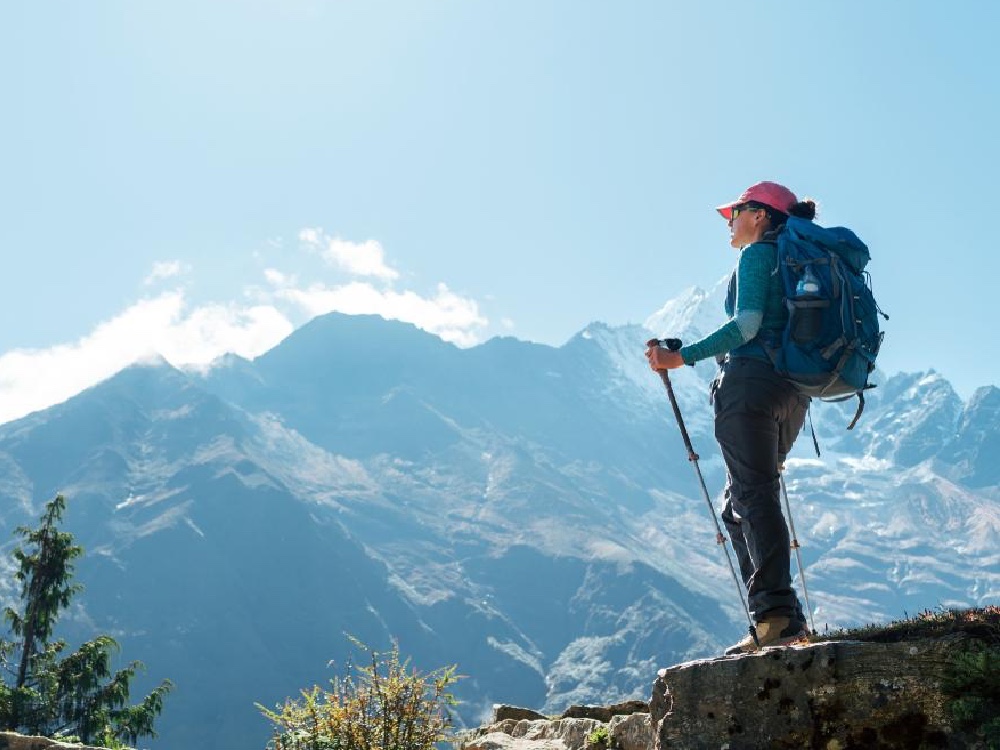
Top Solo Trips in Nepal
Some of the most famous solo treks in Nepal are Everest Base Camp Trek , Gokyo Lake Trek , Annapurna Base Camp Trek , Langtang Valley Trek , Poon Hill Trek , Mardi Himal Trek .
And if you plan on hiking during the monsoon season in Nepal, you can take the Jomsom Muktinath Trek and Annapurna Circuit Trek . These treks are located in Nepal’s trans-Himalayan region and rain-shadow areas.
Hence, solo monsoon traveling / hiking is still doable. So, once you’ve decided on a journey, you should start gathering information about the destinations to visit. You should know the trekking routes, guest houses, food, weather, the culture, and so on.
This way it will prepare you for the journey. And as for the duration, Nepal has hiking journeys that will last from a day/week to a month. We recommend that lonely trekkers do shorter hikes before attempting longer ones.
Equipment & Clothing for Solo Travel in Nepal
The right packing of necessary clothing and gears can make or break your trekking adventure. Hence, once you know when you are trekking, know the weather conditions and pack accordingly.
Make sure to bring all of the necessary clothing. Also, avoid overpacking or under packing.
For the equipment, you can find a complete list and supplies of equipment for a trip in Nepal. Both in Kathmandu and Pokhara, you can buy or rent.
Make sure you don’t bring any unnecessary gear. Because you will be carrying your own luggage as a solo traveler. Hence, anything extra will just add as a load to you. So, the most key thing to remember is to pack smartly.
Permits for Solo Trekking in Nepal
TIMS card (Trekkers Information Management System) is mandatory for every hiker willing to trek in Nepal. If you are hiking solo, you will get a green TIMS Card. If you want to go on treks through the conservation area, you’ll need a conservation area permit as well. You can get both these permits easily from Kathmandu .
Yet for solo hikers, these permits cost slightly more. Furthermore, there are also permit for trekking in the restricted areas of Nepal. And these are not issued for solo treks.
Trekking with or Without Guide and Porter?
Having a guide and porter has a lot of advantages. Both of these ensure in making your hiking experience smooth and safe.
It is important to have at least one of the two, when trekking solo in Nepal. You also have the choice of hiring a porter-guide who does the both works.
Yet, you will have less experience than a guide and will carry less than a porter.
Hiring a guide can make your trek much more comfortable and safer.
They will have good information on the hiking trails and mountains. And will know what to do in the emergency situation and danger ahead.
They can even suggest the best guest houses to rest and eat at. They will also assist you in communicating with the locals. This will allow you to interact with the locals and learn about their lifestyle and culture.
And with a porter, he will carry your 15 to 18 kg luggage. This will allow you to walk freely and discover the trails in your comfort.
So, if you decide to hire a guide or porter, make sure to confirm their legal work status. And only go with the one who makes you feel safe hands.
A guide or porter is not required to trek in popular areas such as Everest Base Camp and Annapurna Base Camp . Trekking without a guide is not permitted in the restricted areas of Nepal for safety reasons.
.jpg)
Pros and Cons of Solo Travel in Nepal
Everything has pros and cons. Solo trip is no exception. Let’s go over some of the benefits and drawbacks of solo trip down below.
- You can set your own pace : This is one of the biggest advantages of trip alone. When you go on a trek with a group, there are always people who want to go fast, and you end up breaking yourself trying to keep up. On the other hand, there are slower and less confident hikers who require you to slow down. As a result, trekking solo allows you to walk at your own pace.
- More flexible : When you’re on your own, you don’t have to worry about what other people think. You are free to detour or take a break at any time. Alternatively, if you want to continue on to the next campsite, you can do so without having to consider others.
- More Peaceful : Traveling solo gives you more time to think about things and enjoy the beauty that surrounds you. It gives you peace and quiet and much more peaceful time with nature.
- Easier logistics : If all of your friends are busy or if you don’t have any friends, you can hike solo or not at all.
- Less support in case of a problem : This is a main disadvantage when trekking alone. You have no one to help you if you fall or trip. The seriousness of the problem will be depending on your conditions and situations. For injury issues that you can walk out, it is not a deal as long as you have a good first aid kit.
- The greater the risk from wildlife/humans : Depending on where you trip, there may be dangerous wildlife or risks from other people. In general, these risks are greater when traveling solo. A single person is easier prey than a group.
- Can be lonely : All day long you can be very lonely, especially if you eat when you can usually talk with the rest of the group or friend. Hence, especially when it gets dark, you may find yourself with little to do. However, depending upon your personality, this may or may not be an issue.
Few Useful Tips for Solo Travel in Nepal
- Choose a good season with favorable weather condition, and pack all the necessary items for the trip.
- Select a hiking destination along the trails that you can reach comfortably in time. For solo trekkers, it is not advised to trek when it gets dark.
- Have travel insurance that covers treks in foreign countries such as Nepal. Also, ensure that your insurance covers emergency evacuation and rescue.
- Bring enough Nepali cash to cover your expenses for the entire trip. In the remote trails, there are no ATMs. The few that exist in some areas are not always dependable.
- Avoid taking unnecessary risks. When trekking alone, stick to the route and destination you’ve chosen.
- Keep some extra days in case of an unplanned situation, such as a delay or injuries.
Solo travel in Nepal opened to the travelers in the 1970s. Hence this is not something new in Nepal.
And yet, while traveling solo one should be careful on the trails and with the strangers, you meet on the journey during your solo trip.
Solo trips are great and safe if you choose to trek in popular hiking trails. Hence, pick a safe time.
For further question or enquiries, please feel free to get in touch . It is our pleasure to assist and guide you to the best of our knowledge.
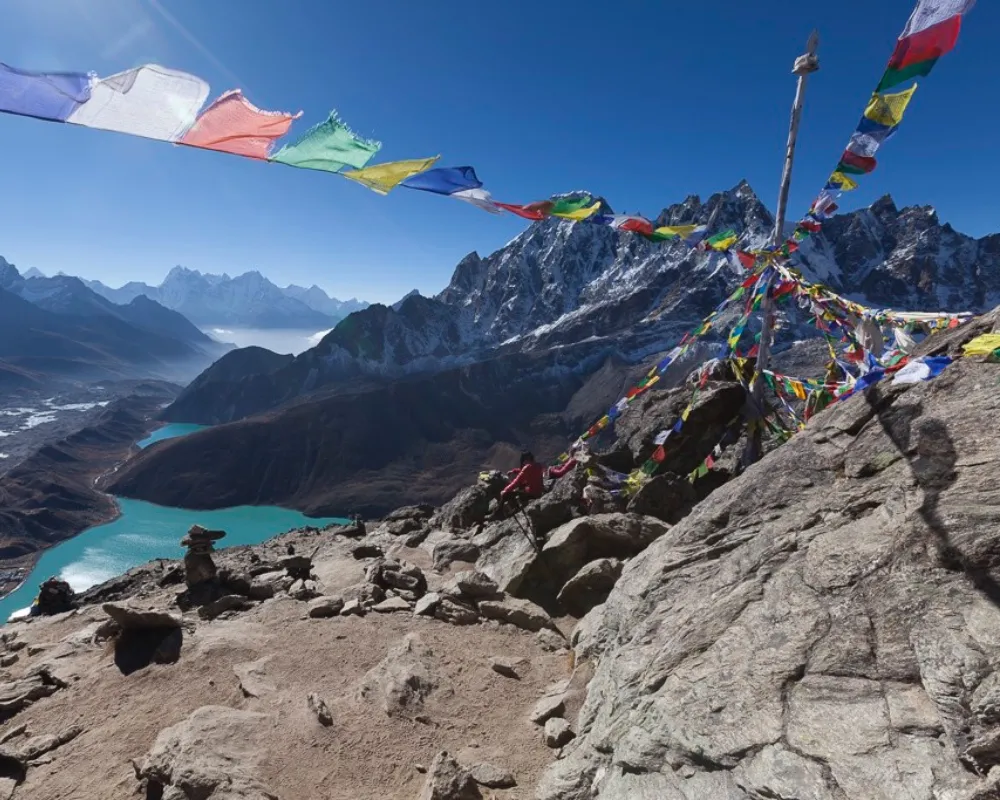
You May Also Like to Know
- Best Time to Visit Nepal
- Nepal Trekking Packing List
- Everest Base Camp Weather
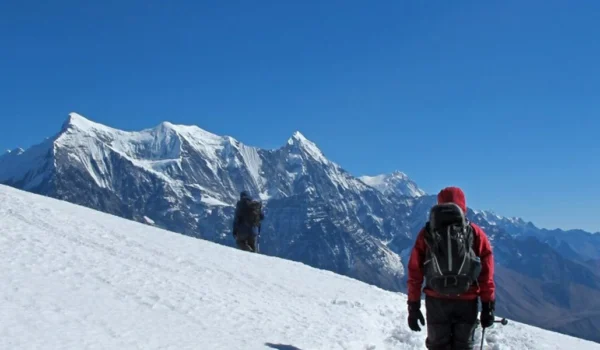
7 Things you need to know before going on a hike in Nepal
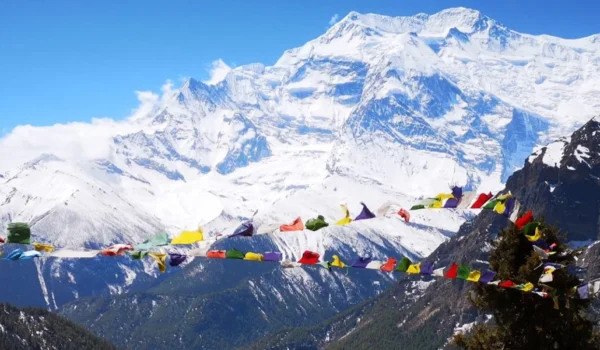
Best Time to Trek Annapurna Circuit
Posts you might be interested in.
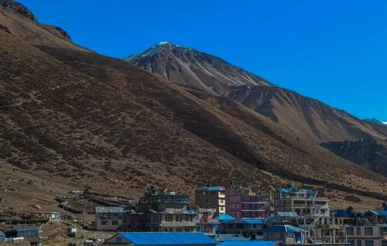
Best Time to Do Langtang Trek
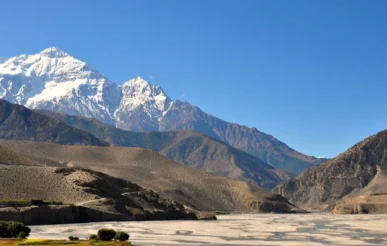
Nepal in July
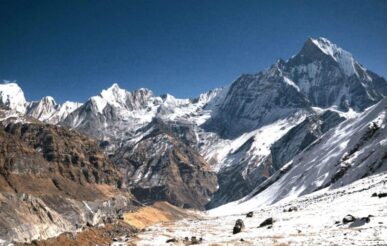
Everest Base Camp Trek in January
Personalize trip.
"I was born and raised in Nepal, nearby Everest region. I am proud to be a native Sherpa, and I have been a Mountain guide over a decade now. Following my passion, I decided to start helping travelers with their travel plans! I think life is a journey, a trip where you collect experiences when you share with other people and with nature."
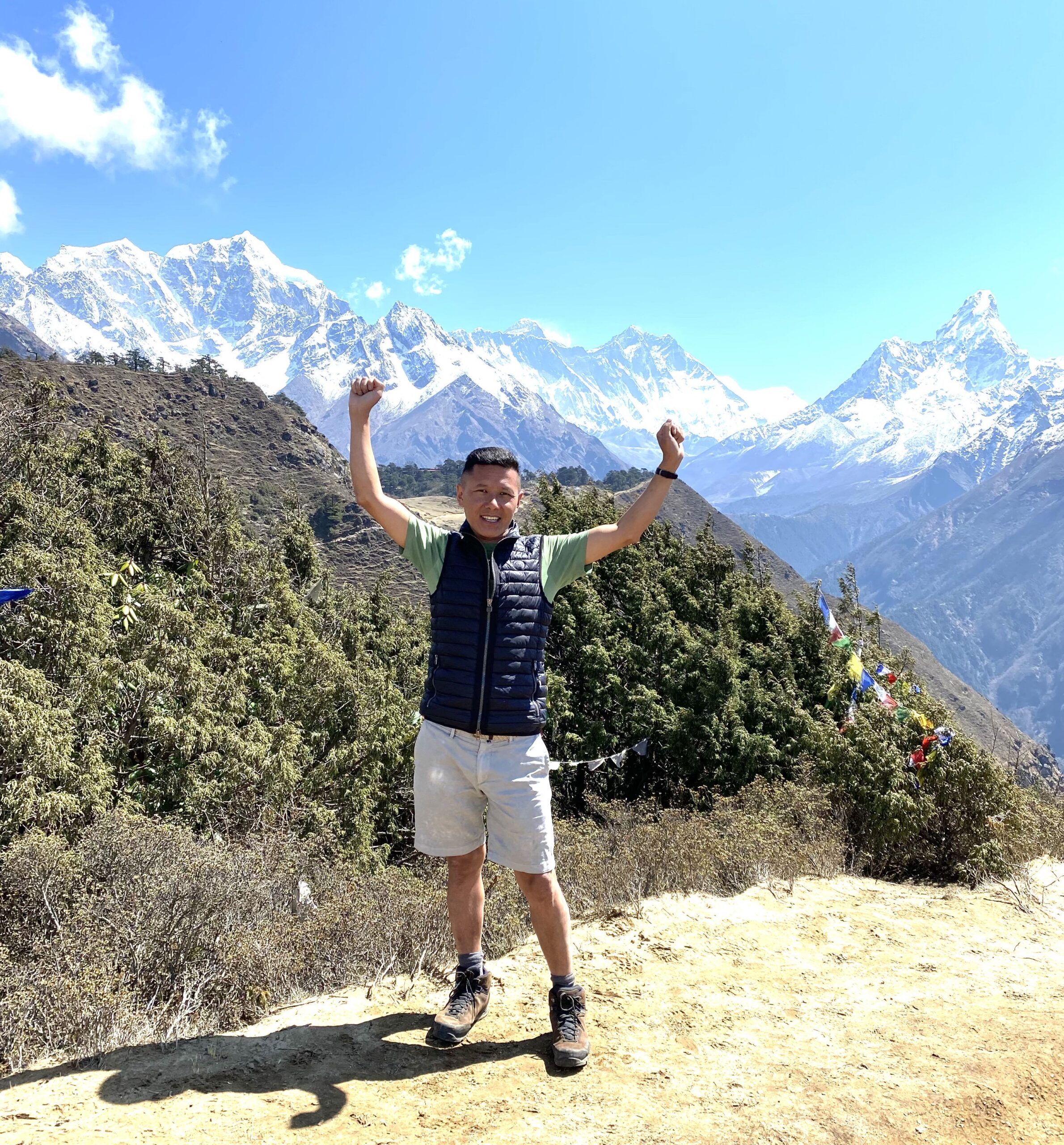
Chhiring Sherpa
We are certified.

- Bold Differences
- Bold Leader
- Terms & Conditions
- Covid-19 Information
- Everest Base Camp Trek
- EBC & Gokyo Valley Trek
- Everest Short Trek – 7 days
- Everest Three Pass Trek – 19 days
- Jiri Everest Base Camp Trek – 21 days
- Sailung Trek
- Gokyo Trek – 13 days
- Ultimate 2023 Guide to Annapurna Base Camp Trek
- Ghorepani Poonhill Trek
- Annapurna Circuit Trek – 15 days
- Annapurna Sanctuary Trek – 15 days
- Jomsom Muktinath Trek – 17 days
- Mardi Himal Trek – 9 days
- Mohare Danda Trek
- Naar Phu Valley Trekking – 15 days
- Tara Top & Siklis Trekking 4 nights 5 days
- Tamang Heritage Trek – 11 days
- Langtang Gosaikunda Trek – 16 days
- Helambu Trek – 11 days
- Langtang Valley Trek – 11 days
- Manaslu Larke Pass Trek – 17 days
- Tsum Valley Trek – 19 days
- Rolwaling Trek – 22 days
- Arun Valley Trekking – 15 days
- Makalu Base Camp Trek
- Ganesh Himal Trekking – 21 days
- Kathmandu Valley Trek
- Panch Pokhari Trek
- Upper Mustang Trek
- Upper Dolpo Trek – 26 days
- Lower Dolpo Trek – 15 days
- Dhaulagiri Base Camp Trek
- Rara Lake Trek
- Kanchanjanga Base Camp & Selele Pass Trek – 26 days
- Buddhist Pilgrimage Tour – 7 days
- Nepal World Heritage Tour – 9 days
- Kathmandu Heritage Tour – 1 day
- Kathmandu Nagarkot Chitwan Lumbini Pokhara Tour – 12 days
- Thulo Sailung Home Stay Trek (Indigenous Trekking Trail) – 10 days
- Chulu East Peak Climbing (6584m)
- Mera Peak Climbing (6654m) – 18 days
- Island Peak Climbing
- Pisang Peak Climbing
- Yala Peak Climbing (5500m) – 15 days
- Everest Expedition (8848m) – 61 days
- Annapurna Expedition
- Manaslu Expedition (8163m)
- Kanchenjunga Expedition
- Mt. Dhaulagiri Expedition (8167m)
- Rafting in Nepal
- Bungee Jumping in Nepal
- Ultralight Aircraft in Nepal
- Mountain Flight Nepal
- Jungle Safari Nepal
- Bhutan Cultural Tour – 4 days
- Cultural Tour of Western – 13 days
- Cultural Tour of Thimpu and Paro – 5 days
- Wangdiphodrang Cultural Tour – 7 days
- West Bhutan Cultural Tour – 5 days
- Mt. Kailash and Guge Kingdom Tour – 23 days
- Everest Base Camp Trek in Tibet
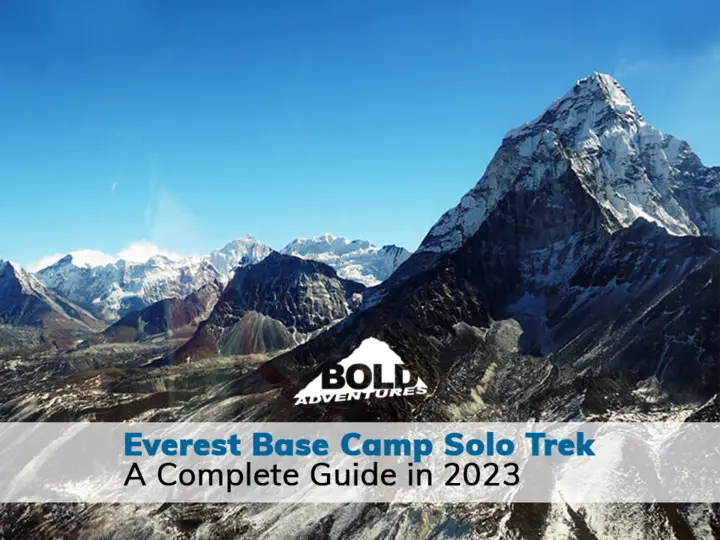
Everest Base Camp Solo Trek: A Complete Guide in 2023
Everest base camp solo trek in Nepal is an awe-inspiring adventure that promises a whirlwind of unforgettable moments. It’s a journey that not only pushes your physical limits but also uncovers profound insights and connects you intimately with nature’s wonders.
In this all-encompassing guide, we delve into the very heart of a solo trek to Everest Base Camp , unveiling crucial tips and profound wisdom to help you navigate the rugged terrain and savor every extraordinary moment.
Let’s acknowledge the paramount importance of caution and responsibility when embarking on a solo trek. While it grants you unparalleled freedom and flexibility, it demands meticulous planning and thorough preparation. We equip you with the essential knowledge, from acquiring permits and understanding Everest base camp altitude sickness to selecting the perfect season and Everest Base Camp Trek packing list . Armed with this wisdom, you can fearlessly embrace the ethereal beauty of the Khumbu Valley and immerse yourself in its awe-inspiring vistas.
While trekking alone offers a unique opportunity for self-discovery, it’s vital to recognize the potential challenges that lie ahead. Without the guidance of a seasoned expert or the camaraderie of fellow trekkers, ensuring your safety, communication, and securing accommodations during busy periods may pose additional hurdles. It’s crucial to evaluate your capabilities and consider the advantages and disadvantages before embarking on this remarkable solitary journey.
Whether you choose to trek with a reputable local agency or venture independently, our guide aims to empower you with knowledge and instill unwavering confidence in your ability to conquer the Everest Base Camp solo trek. So, prepare yourself to lace up your boots, strengthen your mind and body, and set forth on an extraordinary expedition to the pinnacle of the world. Everest Base Camp awaits your arrival and armed with this guide, you’re poised to conquer its lofty heights and forge everlasting memories along the way.
Table of Contents
Is It Safe To Travel Solo In Nepal?
Going on a solo adventure in Nepal promises a world of wonder and discovery, but amidst the excitement, it’s crucial to prioritize your safety above all else. Fear not, Nepal is renowned for its welcoming spirit and is generally considered a haven for solo travellers.
Nevertheless, it’s vital to remain vigilant and attuned to certain factors that could impact your well-being. Like in any new destination, exercising caution and taking necessary precautions are paramount. Dive into thorough research on the areas you wish to explore, immerse yourself in the local customs and traditions, and always keep a watchful eye on your surroundings. Female solo travellers, in particular, should adopt additional safety measures such as dressing modestly, avoiding solitary nighttime strolls, and opting for reputable accommodations.
Nepal’s awe-inspiring landscapes and boundless adventures await but remember to trust your instincts, seek advice from experienced travelers or local authorities, and keep your wits about you. With preparedness and awareness as your steadfast companions, your solo escapade through Nepal will be an unforgettable, secure, and heart-stirring experience.
Advantages Of Trekking To The Everest Base Camp Alone
Going on a solo trek to the Everest Base Camp unlocks a world of advantages for those adventurous souls yearning for a one-of-a-kind and independent expedition. As you venture forth on this extraordinary odyssey, the liberating sense of being the captain of your destiny becomes a precious gift. The freedom to handpick your resting spots, savor local delicacies, and chart your path empowers you to craft the trek to align perfectly with your desires.
Unlike the constraints of group excursions, the absence of time limits allows you to fully immerse yourself in the ethereal allure of the Khumbu valley, savoring every majestic vista at your leisurely rhythm. Moreover, venturing solo unveils an unprecedented opportunity to plunge into the storied tapestry of Everest Base Camp, unraveling its trails, captivating cultures, and the enthralling narratives of the Himalayan realm. If you don’t want to trek through the classic route to the Everest base camp then you can try out alternative trekking options like the Gokyo Lakes Trek , Everest Three pass trek , and Everest base camp trek via Gokyo Lakes .
Embracing solitude amid nature’s embrace, you can forge an intimate connection with the awe-inspiring landscapes and the indomitable spirit of the local communities. Furthermore, embarking on this lone expedition proves to be an economically astute choice, as it liberates you from the financial burden of guides, porters, and agencies, allowing you to allocate your resources toward augmenting your overall experience.
However, it remains paramount to approach solo trekking with utmost caution and meticulous preparation, for it presents its own unique set of challenges. It is wise to consider engaging a knowledgeable local guide to provide an added layer of safety and security, ensuring an unforgettable and deeply fulfilling sojourn to the foot of the world’s loftiest peak. Also, you will find a lot of places to visit while trekking in the Everest base camp .
Can You Trek To Everest Base Camp On Your Own?
EBC Solo Trekking is indeed possible, but it’s essential to approach this adventure with careful consideration and preparation. While it may be tempting to embark on a solo journey, it’s crucial to recognize the potential challenges and risks involved. The trek demands mental preparedness, prior trekking, hiking experience, and physical fitness level for the Everest base camp trek .
Navigating the route independently requires diligent research, logistical planning, and a thorough understanding of the region. Even with the right gear and planning the best time to visit Everest base camp , trekking solo can pose additional threats and obstacles. Safety should be a top priority, and it’s highly recommended, especially for beginner trekkers, to opt for the assistance of a local trekking agency in Nepal.
Their expertise ensures smoother transportation, communication, access to teahouses, and assistance in case of emergencies. While there are undeniable advantages to trekking solos, such as the freedom to make your own choices and delve deeper into the region’s history and culture, it’s crucial to weigh these benefits against the potential risks. Consider the need for a guide for your safety and security throughout the journey, ensuring a memorable and secure experience in the majestic Everest Base Camp.
Disadvantages Of Trekking To The Everest Base Camp Alone
While there are numerous advantages to trekking alone to Everest Base Camp, there are also several disadvantages that should be taken into consideration. One significant drawback is the potential for loneliness.
Without the company of a guide, porters, or fellow trekkers, you may miss out on the opportunity to share the experience and beauty of the trek with someone close. The stunning scenery, as well as the rich local culture and customs, may not be fully appreciated without someone to share and discuss them with.
Additionally, traveling alone leaves you vulnerable in case of sickness or fatigue. Without someone to take care of you, the support available from lodge owners and other trekkers may be limited. Moreover, dealing with the necessary paperwork and permits required for the trek can be more challenging without the assistance of a guide or a trekking agency.
In the event of flight cancellations or other unforeseen circumstances, being part of a group allows for alternative means of transportation, whereas traveling alone may pose additional difficulties in finding suitable alternatives.
You Might Be Interest In:
Everest Base Camp Trek Difficulty
Why Travel With Bold Adventures?
Bold Adventures Nepal is one of the best trekking companies in Nepal. We offer a wide range of adventure activities and trekking options for people of any age group. Bold Adventure Nepal believes in giving back to the community. Hence, we support small businesses and contribute to local communities and we try our best to operate in a socially and environmentally responsible manner.
Having years of experience in the tourism industry helps us understand the needs of our clients and offer a satisfying and enriching experience. We try to keep our group small, tread lightly, and act responsibly. We offer small treks around Kathmandu as well as adventurous treks like the Annapurna circuit trek, and Everest base camp trek. This makes it a suitable trekking experience for anyone seeking a little adventure and for anyone short in time.
You can rely on us for a safe and enriching trekking experience.
Also, check out:
Everest base camp trek insurance
Everest Base Camp trek is a daring and awe-inspiring adventure that opens the door to self-discovery and a deep connection with nature’s wonders. This guide has given you valuable insights and essential tips to navigate the challenging terrain and make the most of your extraordinary journey.
Whether you choose to trek alone or with a reliable local agency like Bold Adventures Nepal, always prioritize your safety. Nepal is known for its friendly people and is generally safe for solo travelers, but it’s important to be cautious and take necessary precautions in any new place you visit.
Trekking alone offers the freedom to make your own choices, immerse yourself in the local culture, and manage your resources as you see fit. However, it’s important to acknowledge the potential challenges like occasional loneliness, limited support in case of sickness or fatigue, and dealing with permits and unforeseen circumstances.
By trusting your instincts, doing thorough research, and seeking advice when needed, your solo adventure in Nepal can be secure, enriching, and heartwarming. Bold Adventures Nepal, with its experience and commitment to responsible tourism, provides a reliable option for a safe and fulfilling trekking experience.
So, get ready, prepare your mind and body, and embark on this extraordinary journey to the top of the world. Everest Base Camp awaits, ready to show you breathtaking views, captivating cultures, and unforgettable memories. With the knowledge and confidence gained from this guide, you’re well-equipped to conquer the majestic heights and create a lasting connection with this remarkable part of the Himalayas.
Everest Base Camp Trek Distance
Leave a Reply Cancel Reply
Save my name, email, and website in this browser for the next time I comment.
Recent Posts
- Everest Base Camp Trek in October Weather
- Annapurna Base Camp Trek Permit and Fee Details in 2023
- What To Pack For Annapurna Base Camp Trek?
- Annapurna Base Camp Trek Accommodation
- What Is The Age Limit For Everest Base Camp Trek?
Recent Works
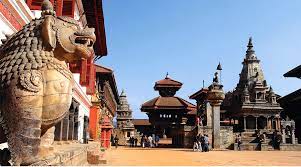
National Geographic content straight to your inbox—sign up for our popular newsletters here
Was Nepal right to ban solo trekking in the Himalayas?
A landmark decision to ban solo hiking in some of the country's wildest areas has shocked many adventurers — but was it about time?

Part of the magic of trekking in Nepal used to be how easy it was to get started, but on 1 April 2023, the government imposed a radical shake-up of the country’s trekking rules. Whereas previously travellers could hike alone anywhere in the country, now they must hire a guide to walk through Nepal’s 12 national parks and six conservation areas, including the popular Everest Base Camp and Annapurna and Manaslu circuits. And the mandatory Trekkers’ Information Management System (TIMS) card, which needs to be obtained to walk in these areas, can only be issued to those who arrange a guide through a government-approved trekking agency. So, is the sun finally setting on Nepal’s golden age of hassle-free trekking? The answer depends on how and where you want to hike in the country.
Why the change in rules?
“The primary objective of requiring trekkers to hike with a guide is to ensure the safety and security of visitors trekking in mountain regions,” explains Ram Chandra Sedai, CEO of the Trekking Agencies’ Association of Nepal. However, the secondary but equally important objective is to generate local employment opportunities. “The mandatory use of guides also helps to formalise the work of guides and porters with improved social security services, better wages and safer working conditions,” adds Ram.
What has the reaction been?
Nepal’s hard-working guides have welcomed both the job creation and safety implications of the new rules. “I’ve just returned from Everest Base Camp and was staying in a teahouse where a solo trekker passed away due to acute mountain sickness,” explains Shiva Bastakoti, a guide for Nepali trekking agency Snow Cat Travel . “He probably wouldn’t have lost his life if he’d been accompanied by a guide who could have advised him on what to do when he started showing signs of AMS.”
As well as knowing the trails — and interesting detours you might otherwise miss — good guides know the local languages, understand the mountains and can immerse you in the Himalayas’ culture, customs and cuisine.
Veteran hikers, however, are less enthusiastic about the end of the old footloose way of trekking. “For less-experienced trekkers, having a good guide can definitely enhance your trekking experience, but guides aren’t trained to a consistent standard in Nepal,” says Bradley Mayhew, author of Lonely Planet’s Trekking in the Nepal Himalaya guidebook. “Encouraging trekkers to hire a guide by providing better-trained guides would be a smarter approach than forcing all trekkers to take a guide, regardless of their experience.”
Trekking agencies have backed the new rules, though there are concerns about the way the changes were announced.
“With sporadic incidents of solo trekkers going missing, the new rules are certainly well-intentioned,” says Abhi Shrestha, COO of Snow Cat Travel. “However, the hasty introduction of the new rules, and the ambiguity in the way the rules have been phrased, leaves us with lots of questions about how effectively these changes can be implemented.”
How will this affect travellers?
If you’re booking a trekking tour to Nepal with an international operator in the UK or a trekking agency in Nepal, these changes will have little effect on your trip. However, travellers who want to trek independently will now have to budget at least £20 a day for a Nepali guide. Overall, costs to trek solo with a guide may end up similar to joining a supported group trek — bank on spending at least £1,000 for the two-week trek to Everest Base Camp, and significantly more to visit restricted areas such as Upper Mustang, Humla and Upper Dolpo. The Trekking Agencies’ Association of Nepal maintains a directory of licenced operators.
So, can I still trek independently in Nepal?
Yes — the new restrictions still leave hundreds of miles of lower-altitude trekking trails accessible to solo hikers, including approach routes used by early Himalayan mountaineers in the 1950s. Those who crave the freedom to trek unaccompanied can take the trails that snake through the Middle Hills around Kathmandu, Bandipur, Gorkha, Dhampus and Panchase near Pokhara. Here, you can still get a taste of the solo adventuring that existed in the days of Edmund Hillary and Tenzing Norgay.
FREE BONUS ISSUE
Related topics.
- BACKPACKING
- ADVENTURERS
- TRAVEL AND ADVENTURE
- ADVENTURE TRAVEL
You May Also Like

This thrilling Chilean trek is the world’s southernmost hike

How to plan the ultimate adventure in the Himalayas, from beginners' hikes to Everest base camp

A practical guide to hiking the Himalayas

Affordable gorilla encounters in Uganda's Bwindi Impenetrable Forest

Banff, Jasper and more: 4 wild places for Canadian outdoor adventures
- Perpetual Planet
- Environment
- History & Culture
- Paid Content
History & Culture
- Photography
- Terms of Use
- Privacy Policy
- Your US State Privacy Rights
- Children's Online Privacy Policy
- Interest-Based Ads
- About Nielsen Measurement
- Do Not Sell or Share My Personal Information
- Nat Geo Home
- Attend a Live Event
- Book a Trip
- Inspire Your Kids
- Shop Nat Geo
- Visit the D.C. Museum
- Learn About Our Impact
- Support Our Mission
- Advertise With Us
- Customer Service
- Renew Subscription
- Manage Your Subscription
- Work at Nat Geo
- Sign Up for Our Newsletters
- Contribute to Protect the Planet
Copyright © 1996-2015 National Geographic Society Copyright © 2015-2024 National Geographic Partners, LLC. All rights reserved

IMAGES
VIDEO
COMMENTS
Solo treks in Nepal can last from a week to a couple of months, depending on your route. But local guides do suggest taking on a shorter trek for your first time to get used to the conditions. Trekking in Nepal does demand a level of physical fitness, and you do need to be able to walk comfortably on rough terrain for six or so hours a day. ...
9 Useful Tips to Solo Trekking in Nepal: Guide Compulsory from April 1 (Updated 2024) Feb 2, 2024. Rupak Parajuli. Nepal is generally considered a safe country to travel solo or alone in. Travelers coming in from India often say that there is no comparison as Nepal is significantly safer than India. Part of this is because of Nepal's openness ...
Solo Trekking in Nepal's Everest National Park. "Om mani padme hum ." I heard the Sanskrit mantra many times while solo trekking in Nepal, but this time it was sweeter than ever. I looked up from a trail lunch of nak cheese into the red-cheeked face of a Sherpa. He was the only person encountered since sunrise.
The Annapurna, Langtang, and Everest are famous trekking routes. It highlights the Himalayas' stunning beauty, lush forests, and quaint villages. Each route presents a unique blend of natural wonders and cultural immersion, making every step memorable. Advantages and Challenges of a Beginner Solo Trek in Nepal.
Solo treks in Nepal opened to the foreigners in the 1970s. Hence it is not something new in Nepal. But, while trekking solo one should be careful on the trails and with the strangers, you meet on the trails during your solo trek. If you choose to trek in the popular trekking trails during the peak season, Solo treks are great and safe.
Throughout an afternoon of solo trekking in Nepal, you pass scores of chortens (rock memorials) and tombstones for fallen climbers and trekkers. From the 1996 disaster on Everest made famous in Into Thin Air to the recent earthquakes, I paused at dozens of markers. Some held "We Miss You Son" and similar heart-wrenching epitaphs.
Update: Effective April 1, 2023, new requirements require solo or foreign independent trekkers to use a local guide or porter while trekking in Nepal's national parks and protected areas. This is an important question for many trekkers and the choice will likely come down to experience and personal preference.
In conclusion, a solo trek in Nepal offers a perfect blend of adventure, self-discovery, and the freedom to chart your course amidst the awe-inspiring landscapes of the Himalayas. Whether you choose the well-trodden paths or venture into the lesser-explored regions, solo trekking in Nepal promises an unforgettable journey filled with personal ...
You will of course not want that after a day-long trek. You can take a porter with you if you have a heavy backpack. Spending around $10 can provide you the facility of carrying your things so you can enjoy the trek in the best possible way. Taking a guide with you can cost around $25 per day.
Solo Trekking in Nepal: Top 17 Tips for a Safe and Memorable Solo Trek - Learn How to Trek in Nepal Solo and Embark on Your Adventure with Confidence. Since 1998 15,000+ Happy Guests Sherpa Owned & Operated Company. Find Your Trips; Quick Inquiry We Help You Decide Your Special Trip ×. Submit. Pasang Sherpa (Managing Director) ...
The Nepal Tourism Board (NTB) has recently announced the guide required for solo treks in Nepal throughout the entire country from April 1st, 2023. This is done in an effort to ensure the safety and security of all travelers in Nepal, and to minimize the chance of any accidents or emergencies. For solo trekkers, the rule change means that they ...
Nepal is visited more often for trekking. Trekking in the lap of the Himalayas is the biggest achievement one can have in life. There are different popular trek trails in Nepal including the highest peak of the world Mount Everest. Many free individual trekkers and trekkers from agencies trek around Nepal every year. Solo Trekking In Nepal:
From April 1, solo trekking will no longer be allowed in Nepal 's national parks and conservation areas. The Nepal Tourism Board, the body responsible for promoting the country's tourism, announced the decision on March 3. According to the board, the decision was taken after consulting with the country's various tourism stakeholders.
Poon Hill. Poon hill is one of the most popular destinations for a solo trek in Nepal. Poon Hill itself offers a variety of experiences that we can get in trekking and also a gateway towards other trekking routes like Annapurna Base Camp. You can reach Poon hill from Pokhara easily in one and a half days. You can experience almost 360-degree ...
Nepal offers a plethora of solo trekking routes, each with its unique charm, stunning landscapes, and cultural experiences. Here's a list of popular solo trekking routes in Nepal: Everest Base Camp Trek: Duration: Approximately 12-16 days; Highlights: Stunning views of Everest, Kala Patthar, Tengboche Monastery, and Sherpa culture. 2.
Trekking in nepal. The main reason hikers come to Nepal is the impressive treks and ridges. Whether your stay is long or short, do not give up on the experience. It is important to choose a reputable travel agency, take a guide, and even a porter to help carry the equipment so you can enjoy the route. Most popular treks in Nepal ...
Where to stay in Nepal as a solo traveller. In Kathmandu and Pokhara, accommodation ranges from five-star hotels and dedicated backpacker hostels to dirt-cheap bases. In other towns, you're likely to encounter hotels with spacious, deluxe rooms on higher floors - which typically have satellite TV, decent mattresses and round-the-clock hot ...
Top Solo Trips in Nepal. Some of the most famous solo treks in Nepal are Everest Base Camp Trek, Gokyo Lake Trek, Annapurna Base Camp Trek, Langtang Valley Trek, Poon Hill Trek, Mardi Himal Trek. And if you plan on hiking during the monsoon season in Nepal, you can take the Jomsom Muktinath Trek and Annapurna Circuit Trek. These treks are ...
How to solo trek in Nepal. Trekking solo but with a guide in Nepal will be a rewarding adventure journey; it offers hassle free preparation and planning to guarantee your safety and enjoyment. Before planning your trekking itinerary, you have to choose a trekking route. That route needs to match your fitness level, experience, and preferences.
Everest base camp solo trek in Nepal is an awe-inspiring adventure that promises a whirlwind of unforgettable moments. It's a journey that not only pushes your physical limits but also uncovers profound insights and connects you intimately with nature's wonders. In this all-encompassing guide, we delve into the very heart of a solo trek to ...
Nepal, with its breathtaking landscapes, towering peaks, and vibrant cultural tapestry, is a haven for adventure seekers. For those craving solitude and self-discovery, embarking on a solo trek in Nepal is an experience like no other. From the majestic Annapurna and Everest regions to the less-explored gems like Langtang, Kanchenjunga, Mustang, and Naar Phu, each solo trek promises a unique ...
Just an update on the 2023 solo trekking rules, though Nepal Tourism board has made it mandatory to hire guide for the EBC trek. The local authorities in the Khumbu region have decided not to follow this. This can be viewed on their Facebook page 'Khumbu Pasanglhama Rural municipality' which has an official document published on April 2nd.
Yes — the new restrictions still leave hundreds of miles of lower-altitude trekking trails accessible to solo hikers, including approach routes used by early Himalayan mountaineers in the 1950s ...